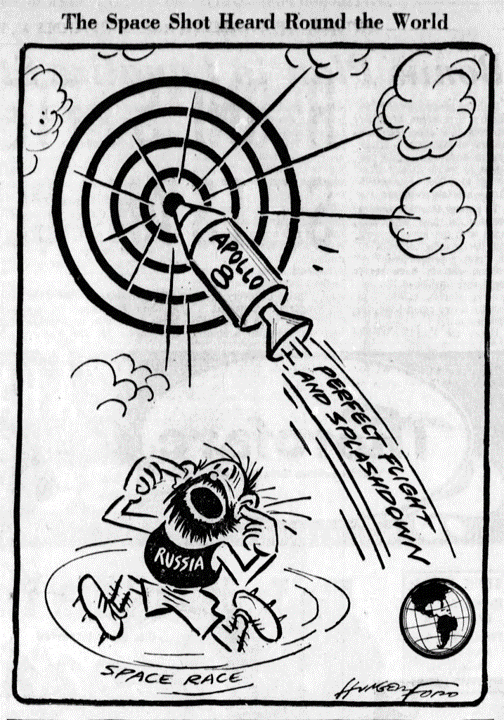
by Gideon Marcus
There's big news on both sides of the pole regarding a pair of recently ended space flights: Apollo 13 and Soyuz 9…
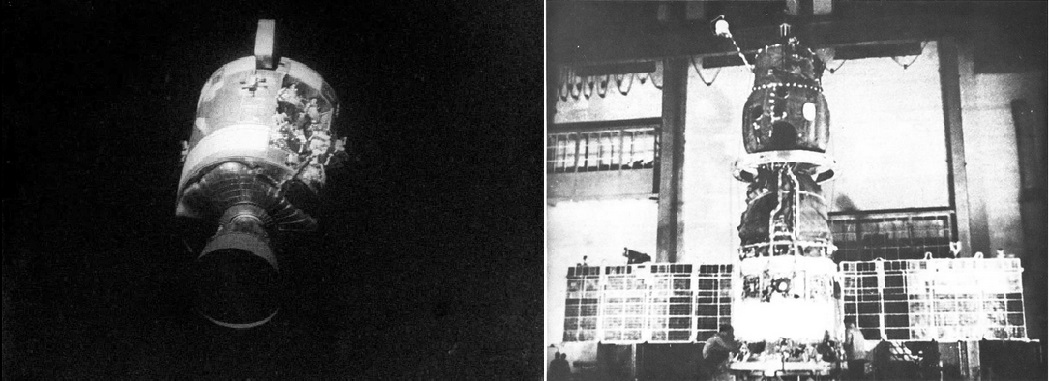
Continue reading [June 20, 1970] Gemini Too (the two-week flight of Soyuz 9)

by Gideon Marcus
There's big news on both sides of the pole regarding a pair of recently ended space flights: Apollo 13 and Soyuz 9…

Continue reading [June 20, 1970] Gemini Too (the two-week flight of Soyuz 9)
[New to the Journey? Read this for a brief introduction!]

by Kaye Dee
On 5 May, the Apollo-13 crew visited the Grumman Aircraft Engineering Corporation factory in Bethpage, New York, to thank the company for its lifesaving Lunar Module, without which the recent lunar mission would have ended in disaster.
 left to right: Apollo-13 astronauts Haise, Swigert, and Lovell during their visit to Grumman's Bethpage plant
left to right: Apollo-13 astronauts Haise, Swigert, and Lovell during their visit to Grumman's Bethpage plant
The Grumman team’s contribution to the successful outcome of the mission – understanding the full capabilities of the vehicle they had designed so that it could be pressed into service as the astronauts’ lifeboat – is just one example of the innovativeness and dedication of the many NASA support teams working behind the scenes in the Apollo programme.
Today, I want to tell another behind-the-scenes story, one that comes “straight from the horse’s mouth”, as I’ve interviewed many of the personnel involved – the crucial role played by NASA’s space tracking networks, in particular the Manned Space Flight Network (MSFN) in Australia, in saving Apollo-13. I hope it will give you some insight into the complex technical and logistical operations that were required to respond to the emergency, and a feel for the urgency with which everyone was operating.
Continue reading [May 14, 1970 Another Perfect Emergency (Saving Apollo-13)
[New to the Journey? Read this for a brief introduction!]

by Kaye Dee
We all breathed a sigh of relief when the astronauts of Apollo-13 returned to Earth safely a few days ago, after the Apollo programmes’ first (and hopefully last) inflight emergency, but superstitious people are claiming that Apollo-13 was unlucky because of a prevalence of “13s”! After all, the mission was launched at 13:13 Houston time (but somewhere in the world there will always be a place where the time is 13: something!) and the explosion that caused its inflight emergency occurred on 13 April (but only in certain timezones – it was already 14 April in Australia and most of the world east of the United States).
Don’t tell me the Apollo-13 crew were “unlucky”; in fact, they were immensely lucky that when something did go wrong they were a team with the right skills for the situation. As seasoned test pilots, the crew were experienced at working in critical situations with their lives on the line, and their professional skills as astronauts were matched by the “tough and competent” (to quote Flight Director Mr. Gene Kranz) Mission Control teams, backed by highly trained engineers and scientists – all determined to “return them safely to the Earth”, just as President Kennedy committed NASA to do when he set the goal of a manned lunar landing by 1970!

by Gideon Marcus
In February 1958, just months before Galactic Journey took to press, Vice President Nixon visited Jet Propulsion Laboratory. He went personally congratulate the team that had built America's first artificial satellite, Explorer 1.

Vice President Richard Nixon and a model of the Explorer satellite with Dr. Lee DuBridge, left, president of Cal Tech, and Dr. William H. Pickering, right, director of the Cal Tech Jet Propulsion lab, during a news conference in Pasadena, Calif., Feb. 17, 1958.
Now it is 1970. President Nixon is presiding over a severe curtailing of our space program. Next month, Apollo 13 will head to the Moon, marking the end of the first stage of lunar reconnaissance. The original plan was for ten increasingly ambitious lunar landings, paving the way for long term exploration and exploitation. But it's looking now like Apollo 11 was more of a conclusion than a beginning. The Saturn V assembly line is shut down, Congress and the President are against any ambitious space endeavors, and even the three phases of Apollo flights are being cut down to two.
Continue reading [March 30, 1970] The Age of Explorer — the end of the Space Race
[New to the Journey? Read this for a brief introduction!]

by Gideon Marcus
With the Apollo missions taking so much of our attention (there were four flights this year), it is understandable that unmanned missions and science have gotten short shrift. I'm going to try to address this oversight now.
Far out!
Do you remember Pioneer 6 (launched Dec. 16, 1965) and Pioneer 7 (launched Aug. 17, 1966)? They are deep space probes designed to observe the Sun from widely different vantage points. In fact, we've been a bit remiss: since '66, two more identical Pioneers have gone up: Pioneer 8 (December 13, 1967) and Pioneer 9 (November 8, 1968). A fifth and final Pioneer was launched August 27, 1969, but its carrier rocket exploded. The loss of that one is pretty bad; whereas the others are all spread out fairly equidistantly around the Sun, more or less as far away from it as the Earth, Pioneer "E" was going to be put in an orbit that kept it close to Earth, where it would be used to give as much as a two-week warning of dangerous flare activity.
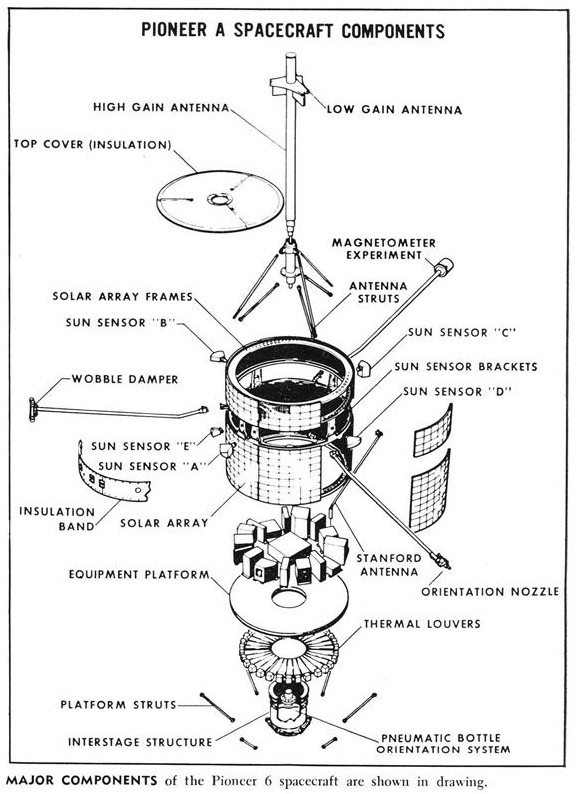
Nevertheless, NASA is blazing along with four satellites. Indeed, thanks to the longevity and spread-out positions of Pioneers 6 and 7, they were able to perform an unique experiment. On Nov. 6, the two satellites were 175 million miles apart on a common line with the Sun, and scientists observed the difference in behavior of solar wind particles due to their passage through space in opposite directions. In a similar vein, on Dec. 2, when the spacecraft reached points on a common spiral line leading out from the Sun (the star rotates, so it flings out particles in a spiral rather than linear fashion), scientists measured different kinds of solar particles coming from the same events on the Sun.
We'll have to wait for the journals to publish any papers, but this is the kind of large-scale, long-term science made possible by the Pioneer probes!
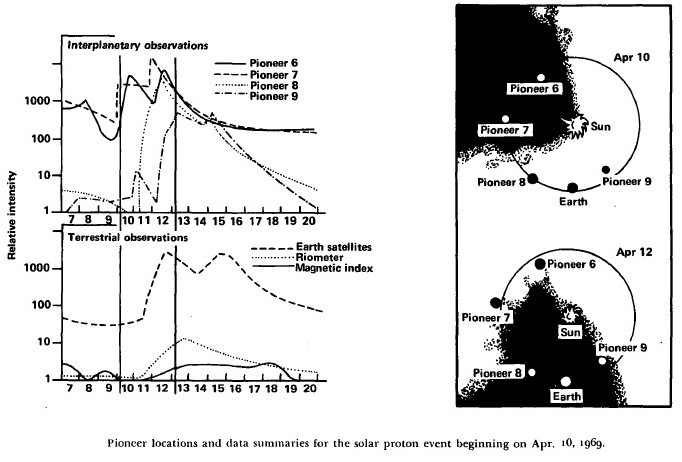
Another cool example of Pioneer science

by Gideon Marcus
Just four months ago, men first set foot on the Moon, fulfilling a millennia-long dream of humanity as well as culminating a decade-long Space Race between the superpowers. And the question on everyone's lips: how do you top that?
It's important to remember that the flight of Apollo 11 was not the end, but only a beginning—just as John Glenn's orbital flight, Gus Grissom's mission in Gemini 3, Wally Schirra's in Apollo 7 were all beginnings. The Moon Port is open, and it is time to start the exploration of the cosmos in earnest.
Appropriately, the flight of Apollo 12 was planned to mark an incremental expansion upon the prior mission's success. Scheduled for a November 14 launch at 11:22AM Eastern time months in advance, the second lunar mission would include the following improvements:
In all, Apollo 12 promised to be only slightly more ambitious than its predecessor, but how much more ambitious than a flight to the Moon do you need?
Continue reading [November 26, 1969] From the Earth to the Moon…and back (Apollo 12)
Seven years ago, the Journey published an article on the Women Pioneers of Space Science. At long last, Kaye offers a much-needed update, this time focusing on the women who helped make Apollo 11's trip to the Moon possible…

by Kaye Dee
Classical literature tells us that the god Apollo was associated with the Nine Muses, the goddesses who inspired the arts, literature and science.
Our modern Apollo program also has its Muses – trailblazing women working behind the scenes in critical areas of the programme. They deserve to be better known, not just for their own impressive careers to date, but also as role models, inspiring girls and young women who might be interested in science, technology, engineering, mathematics or medicine, but are diverted away from them by the prevailing view that careers in these areas are for men, not women.
 The famous ‘Dance of Apollo and the Muses’ by the Italian architect and painter, Baldassare Tommaso Peruzzi
The famous ‘Dance of Apollo and the Muses’ by the Italian architect and painter, Baldassare Tommaso Peruzzi
As someone who has had to contend with these stereotypes myself, trying to establish a career in the space sector in Australia, I thought it might be interesting this month to delve into the stories of four of the women working behind the scenes in the Apollo programme: modern-day daughters of Urania, the Muse of Astronomy, Mathematics and the “exact sciences”.
The “Return to Earth” Specialist: Frances “Poppy” Northcutt
Every aspect of a lunar voyage involves moving objects – the Apollo spacecraft, the Earth and the Moon. Calculating the trajectories required for an Apollo mission to meet and go into orbit around the Moon at a particular date and time, is a mind-bending feat. But getting astronauts safely home from the Moon is even more important!
NASA’s specialist in the incredibly complex and precise calculations required to determine the optimal trajectories for the return to Earth from the Moon, minimising fuel and flight time, is Miss Frances Northcutt, who goes by the nickname “Poppy”. She is, perhaps, the only one of these ladies that you might have heard of (at least those of you in the United States), as she was such a “curiosity” during the press and television coverage of the Apollo-8 mission that she has been interviewed many times (and more on this below).
Born in 1943, Miss Northcutt earned a mathematics degree from the University of Texas, then commenced working at TRW in 1965 as a “computress”! Yes, that was her actual job title, although in Australia we’d have just called her a "computer" (a term applied here and in Britain to both men and women doing this kind of intensive calculating work). Miss Northcutt was placed at NASA’s Langley Research Centre, calculating spacecraft trajectories for the Gemini missions. She proved to be so talented in this area that within just six months TRW promoted her to engineering work with its Return to Earth task force, helping to design the computer programmes and flight trajectories to return an Apollo spacecraft from lunar orbit to Earth.
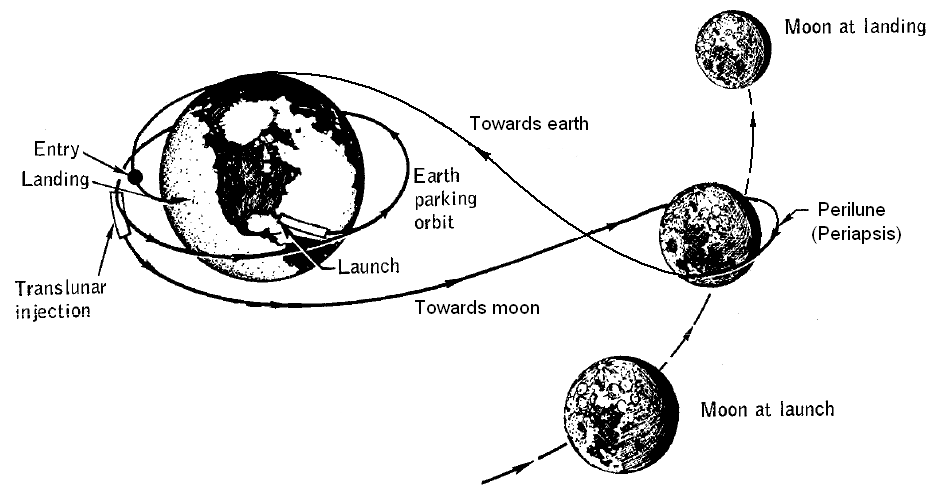 A simplified version of the Apollo lunar free return flight trajectories
A simplified version of the Apollo lunar free return flight trajectories
Poppy Northcutt became the first woman to work in this type of role and was soon undertaking the intricate calculations involved in enabling the Apollo astronauts to travel around the Moon and come safely home. The Moon’s lower gravity changes parameters such as fuel usage, as well as the timing of manoeuvres, so the calculations are particularly tricky. Poppy identified mistakes in NASA’s original trajectory plan, performing calculations that reduced the amount of fuel used to swing around the Moon.
When NASA decided that Apollo-8 would become a lunar orbiting mission, the task force team, including Miss Northcutt, moved to Mission Control to instruct the flight controllers on the trajectory calculations and be available to make real-time calculations and course corrections in the event of unexpected incidents during the flight. Assigned to Mission Control's Mission Planning and Analysis room, Miss Northcutt and her team have been an integral part of Apollo-8, 10 and 11 and are now preparing for Apollo-12. She is the only female engineer in the teams that work in the backrooms of Mission Control in Houston, providing support to the flight controllers.
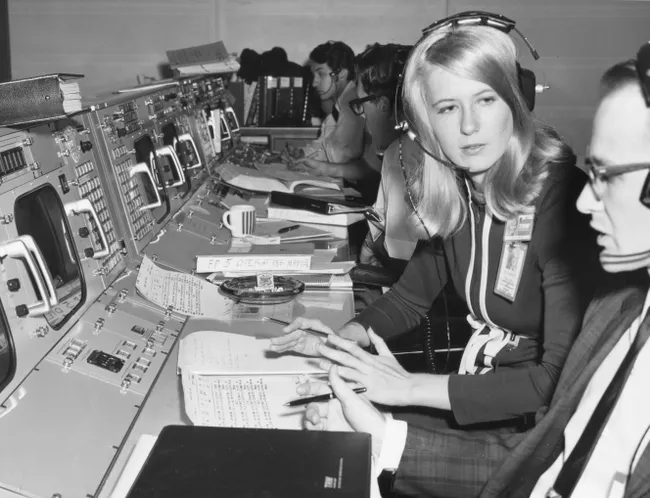 Poppy Northcutt working in the Mission Control support room during Apollo-8
Poppy Northcutt working in the Mission Control support room during Apollo-8
Working Like a Man (but not being paid like one!)
“Computresses” in Miss Northcutt’s original position are classed as “hourly workers”, with their wages capped at working 54 hours per week (in other words, five nine-hour days). Their male counterparts were not only paid more (as we all know, female workers are generally paid between about half and two-thirds of the wages for a man doing the same job), they were also on salaries and paid overtime.
As an ambitious young woman, Miss Northcutt quickly realised that to earn the respect of her male colleagues and be considered a peer, she would have to work the same long hours they did – even if this meant that she was essentially working 10 or more hours a week for no pay!
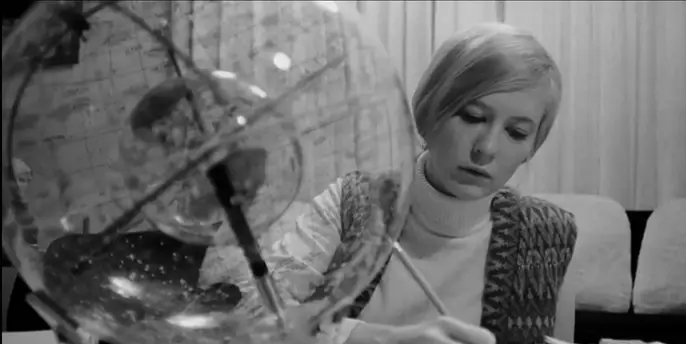 A NASA promotional photo of Miss Northcutt at work in March this year. She presents herself as a diligent professional
A NASA promotional photo of Miss Northcutt at work in March this year. She presents herself as a diligent professional
Her talent and diligence paid off with her promotion to engineer, but, ironically, even though she was still being paid less than her male colleagues, Miss Northcutt tells the story that there was no normal mechanism to approve the pay rise she received with this jump from Computress! Her manager had to keep scheduling the highest possible raise as frequently as he could to bring her up to the full female rate of her new salary.
During Apollo missions, when shifts last around 12 to 13 hours a day in Mission Control, Miss Northcutt usually commences her duty shifts for each mission around the time that the Apollo spacecraft, coasting towards the Moon, prepares to enter the lunar sphere of gravitational influence. During lunar orbit insertion she stands by to assist with new calculations, in the event of an emergency abort, and she reports for duty at Mission Control every day of the lunar phase of the mission and until the astronauts have returned safely to the Earth's sphere of influence. No one can say Poppy Northcutt isn’t pulling her weight, just like a man!
Sexism, Celebrity and Activism
As the only female engineer in Mission Control during the Apollo-8 mission, Miss Northcutt was such a “curiosity” that she received a lot of attention from journalists. While much of this coverage was not seen in Australia, from what I have heard from friends in America, I understand that many of the questions that she received were quite sexist – and even silly.
Miss Northcutt is a very pretty woman and dresses fashionably, so apparently ABC reporter Jules Bergman thought it was more important to ask about her potential to distract her male colleagues from the mission, than to ask about her crucial role: “How much attention do men in Mission Control pay to a pretty girl wearing miniskirts?” Would they have asked a male flight controller if the suit he was wearing turned the heads of the typing pool?! I gather that she gave him a polite brush off response.
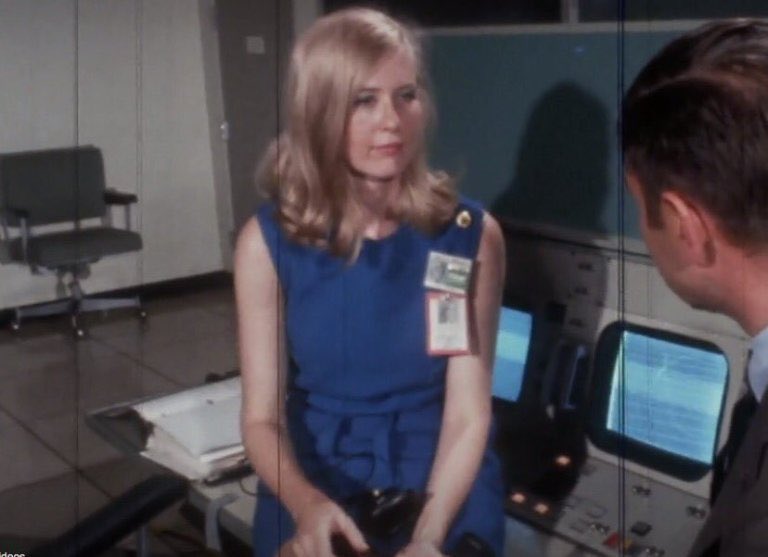 A friend in the US took this photo from her television screen, giving me a glimpse of Mr. Bergman's interview with Miss Northcutt
A friend in the US took this photo from her television screen, giving me a glimpse of Mr. Bergman's interview with Miss Northcutt
It is bad enough when reporters focus on her appearance and ask her such inane questions, while she operates at the level of her male colleagues, for far less monetary reward. But Miss Northcutt has also reported an instance in which she discovered that the other flight engineers were covertly watching her on a video feed, from a camera trained on her while she was conducting equipment flight tests.
As a result of her personal experiences with sexism, Miss Northcutt has become a strong advocate for women’s rights, and has joined the feminist National Organisation for Women. Even in her early days at TRW, she worked to improve the company’s affirmative action and pregnancy leave policies. “As the first and only woman in Mission Control, the attention I have received has increased my awareness of how limited women’s opportunities are”, she has said. “I’m aware of the issues that are emerging. Working in this environment I can see the discrimination against women.”
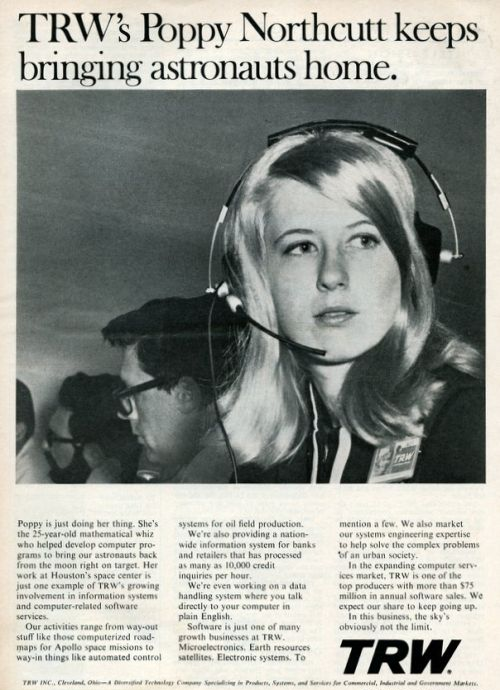 TRW is happy to use Miss Northcutt's minor celebrity to promote itself, but not happy enough to pay her the same salary as her male colleagues!
TRW is happy to use Miss Northcutt's minor celebrity to promote itself, but not happy enough to pay her the same salary as her male colleagues!
However, while she is not pleased that much of the attention she has received has been focussed on her appearance, or treating her as a rare exception to the male-dominated world of spaceflight, Miss Northcutt has said that she recognises that being a woman visibly occupying a critical position in the space programme does send a very positive message to women and girls: a career in science and technology is possible if you want it – and are prepared to work for it!
Miss Northcutt has received letters and fan mail from around the world (including several marriage proposals, it seems!) She has said that she is motivated to continue to advocate for women’s rights in the workplace by the letters she has received from young women, who have said how much she has inspired them.
Whoever Heard of a “Software Engineer”? Margaret Hamilton
The Apollo missions not only need precise trajectories for their lunar voyages – they also need software for their onboard flight computers, which control so many aspects of the flight. If you’re not familiar with this term, “software” describes the mathematical programmes that tell a computer how to carry out its tasks, and a “software engineer” applies the engineering design process to develop software for those different tasks.
The Director of Apollo Flight Computer Programming is Mrs. Margaret Hamilton Lickly, who prefers to be known professionally as Margaret Hamilton.I've heard that women in the United States who prefer not to be categorised by their marital status, are now starting to use the designation "Ms.". I don't know if Margaret Hamilton is using this new honorific, but it seems to me appropriate to apply it to her in this article.
33-year-old Ms. Hamilton is another woman playing a crucial role in NASA’s lunar program. Not only is she a pioneer in software engineering, she even coined the term!
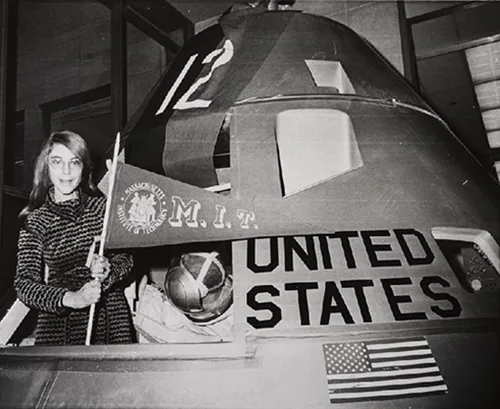
Like Miss Northcutt, Ms. Hamilton is also a mathematician, having studied at the University of Michigan and Earlham College. Shortly after graduating in 1958, she married her first husband, James Hamilton, and taught high school mathematics and French, before taking a job in the Meteorology Department at the prestigious Massachusetts Institute of technology (MIT) in 1959, a few months before the birth of her daughter.
Ms. Hamilton developed software for predicting weather, and in 1961 she moved to MIT’s Lincoln Lab for the Semi-Automatic Ground Environment (SAGE) Project, adapting weather prediction software into a programme used by the U.S. Air Force to search for potential enemy aircraft. At the Lab, she was the first person to get a particularly difficult programme, which no-one had been able to get to run, to actually work! While working on SAGE, Ms. Hamilton began to take an interest in software reliability, which would pay dividends during Apollo-11’s lunar landing.
A Calculated Move
When Margaret Hamilton learned about the Apollo project in 1965, she wanted to become involved in the lunar programme, and moved to the MIT Instrumentation Laboratory, which was developing the Apollo Guidance Computer. She was the first programmer hired for the Apollo work project at MIT and has led the team responsible for creating the on-board flight software for both the Apollo Command and Lunar Modules. She also serves as Director of the Software Engineering Division at the Instrumentation Laboratory.
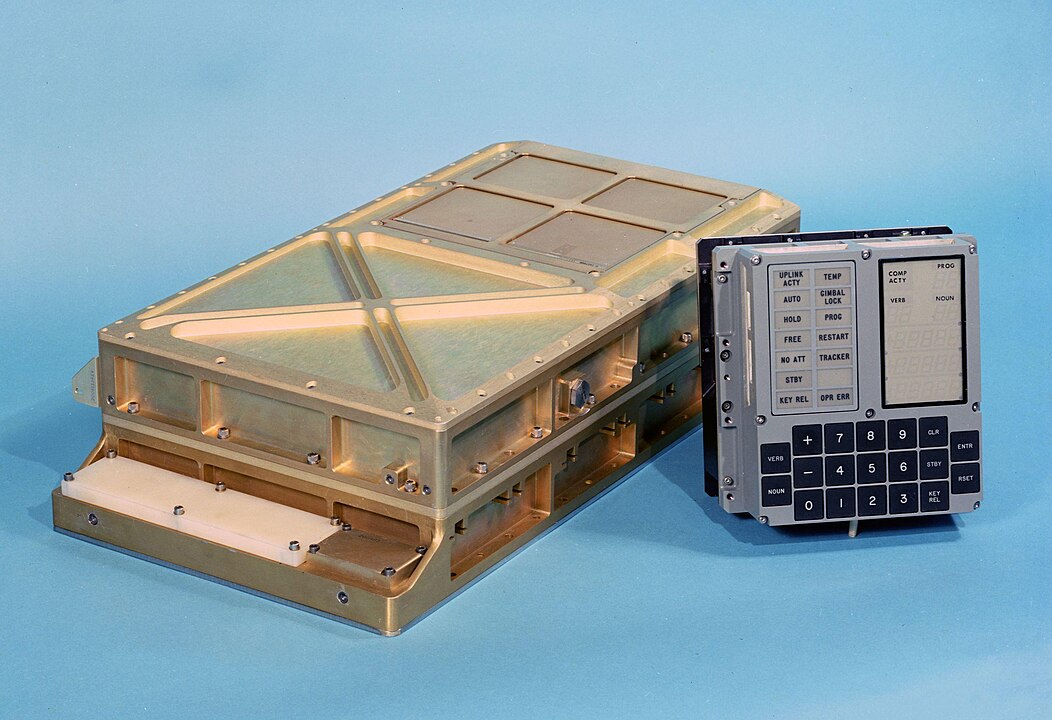 The Apollo Guidance Computer was installed on both the Command and Service Modules. Astronauts communicated with it using a numeric display and keyboard
The Apollo Guidance Computer was installed on both the Command and Service Modules. Astronauts communicated with it using a numeric display and keyboard
While working on the Apollo software, Ms. Hamilton felt that it was necessary to give software development the same legitimacy as other engineering disciplines. In 1966, she therefore coined the term “software engineering” to distinguish software development from other areas of engineering. She believes that this encourages respect for the new field, as well as respect for its practitioners.
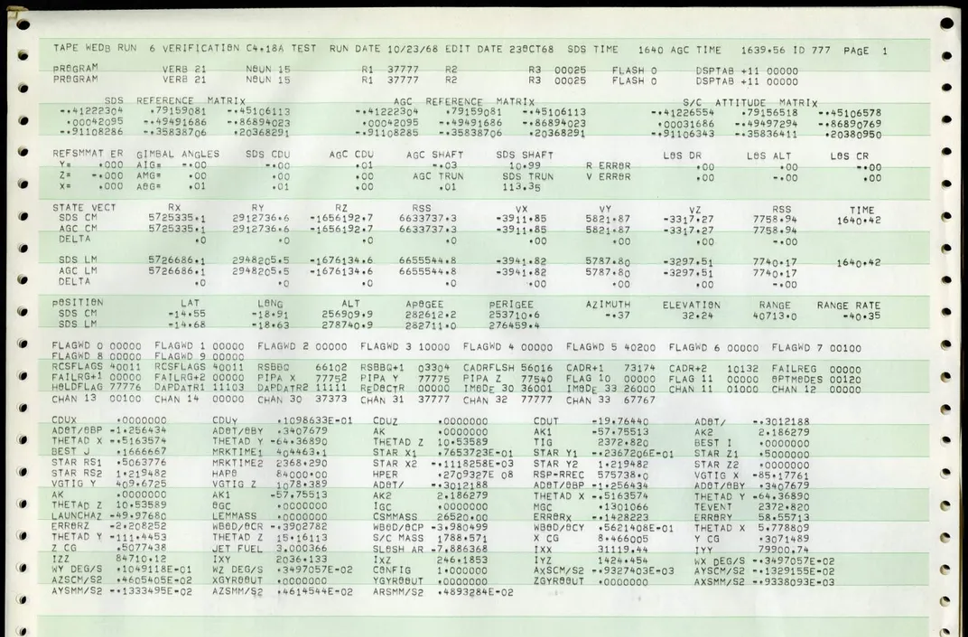 A page from the software for the Apollo Guidance Computer
A page from the software for the Apollo Guidance Computer
On one occasion when her young daughter was visiting the lab, the little girl pushed a simulator button that made the system crash. Ms. Hamilton realised immediately that the mistake was one that an astronaut could make. While Ms. Hamilton has said that she works in a relationship of "mutual respect" with her colleagues, when she recommended adjusting the software to address the issue, she was told: “Astronauts are trained never to make a mistake.” Yet during Apollo-8, astronaut Jim Lovell made the exact same error that her young daughter had!
While Ms. Hamilton’s team was able to rapidly correct the problem, for future Apollo missions protection was built into the software to prevent a recurrence. With her interest in software reliability, Margaret Hamilton insisted that the Apollo system should be error-proof. To achieve this goal, she developed a programme referred to as Priority Displays, that recognises error messages and forces the computer to prioritise the most important tasks, also alerting the astronauts to the situation.
In Part 2 of my series of Apollo-11 articles, we saw how, during the descent to the Moon’s surface, the Lunar Module’s computer began flashing error messages, which could have resulted in Mission Control aborting the landing. However, the Priority Displays programme gave Guidance Officer Bales and his support team confidence that the computer would perform as it should despite the data input overloads that it was experiencing, and that the landing could proceed.
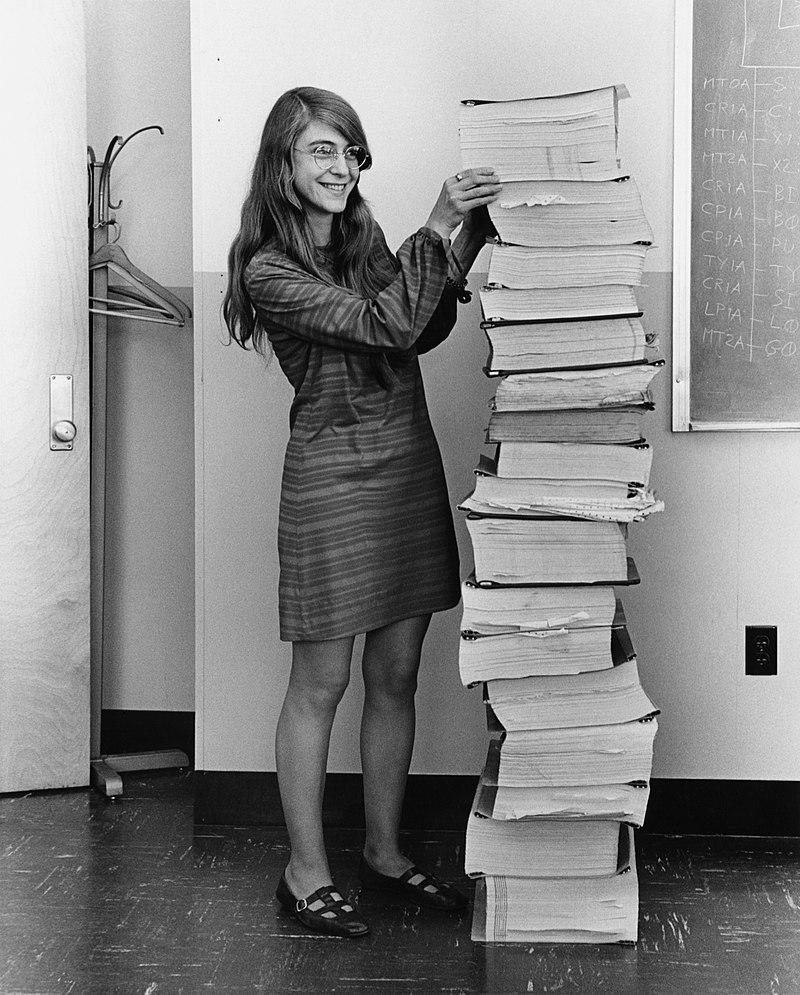 Ms. Hamilton with this year's printout of the entire Apollo Guidance Computer software
Ms. Hamilton with this year's printout of the entire Apollo Guidance Computer software
Ms. Hamilton and her 100-strong team continue to work on developing and refining the Apollo flight software, and I’m sure that they will contribute to whatever future spaceflight projects NASA develops, stemming from Vice-president Agnew’s recently-delivered Space Task Group report to President Nixon.
“I’ve Got Rocket Fuel in my Blood”: JoAnn Morgan
Mission safety and reliability are, of course, critical, but Apollo-11 could not even have made the historic lunar landing if the mission had been unable to launch in the first place! When Apollo-11 lifted off, there was one lone woman in the launch firing team at Kennedy Space Centre’s (KSC) Launch Control Centre, who helped to ensure that would happen – Instrumentation Controller JoAnn Morgan.
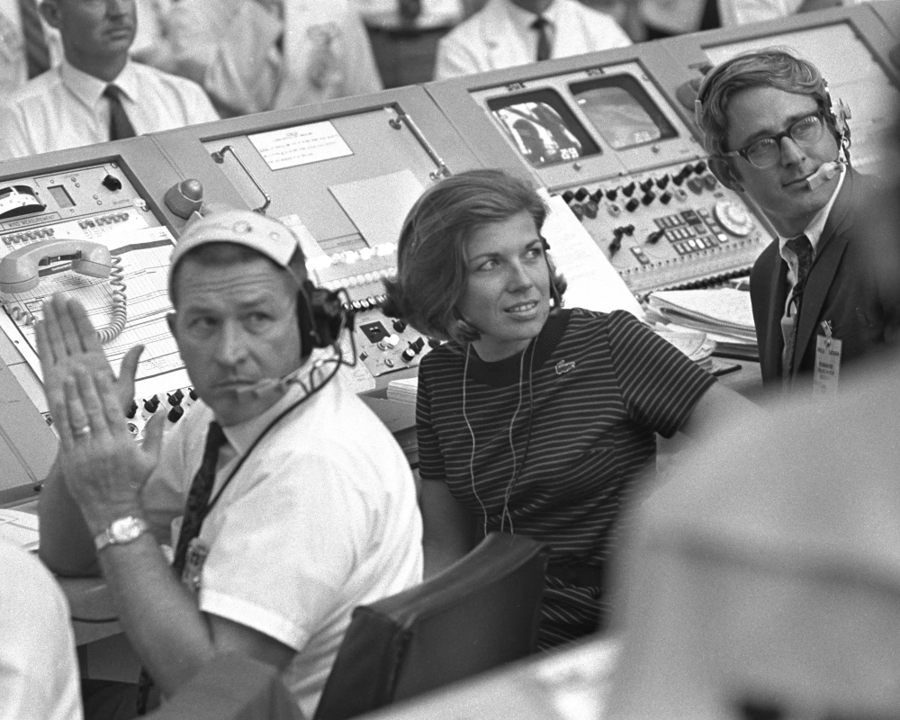 JoAnn Morgan watching the lift-off of Apollo-11 from her station in Launch Control
JoAnn Morgan watching the lift-off of Apollo-11 from her station in Launch Control
Mrs. Morgan, who was born in December 1940, has described herself as a “precocious little kid” who loved mathematics, science and music, and wanted to become a piano teacher. However, after her family moved to Florida from Alabama, she was inspired by the launch of the first American satellite, Explorer-1, in January 1958, and its significant discovery of the Van Allen Radiation Belts. It was the “opportunity for new knowledge” that space exploration represented that filled the teenager with a desire to be part of the new space programme.
 Young JoAnn with one of her favourite books. As a child she loved to read and play with her chemistry set
Young JoAnn with one of her favourite books. As a child she loved to read and play with her chemistry set
Soon after, JoAnn saw an advertisement for two (US) Summer student internship positions, as Engineer’s Aides with the Army Ballistic Missile Agency at Cape Canaveral. As we know, job openings are often advertised separately for males and females, but this ad only referred to “students” (not “boys”), so she took the chance, decided to apply, and was successful thanks to her strong marks in science and mathematics.
So, at just 17, JoAnn Hardin, as she was then, began working as a University of Florida trainee for the Army at Cape Canaveral Air Force Station. “I graduated from high school on the weekend and went to work for the Army on Monday. I worked on my first launch on Friday night” is how Mrs. Morgan describes the beginning of her NASA career. The Army programme she was working with became part of NASA when it was established in October 1958.
Supportive Male Mentors
While undertaking her degree in mathematics at Jacksonville State University, Mrs. Morgan continued her Summer internships with the NASA team launching rockets at Cape Canaveral. The young student’s potential did not go unnoticed, and she acknowledges that she received significant support in furthering her career from several senior NASA personnel, including Dr. Wernher von Braun, the chief architect of the Saturn V rocket, Dr. Kurt Debus, the first director of Kennedy Space Centre and Mr. Rocco Petrone, Director of Launch Operations at KSC.
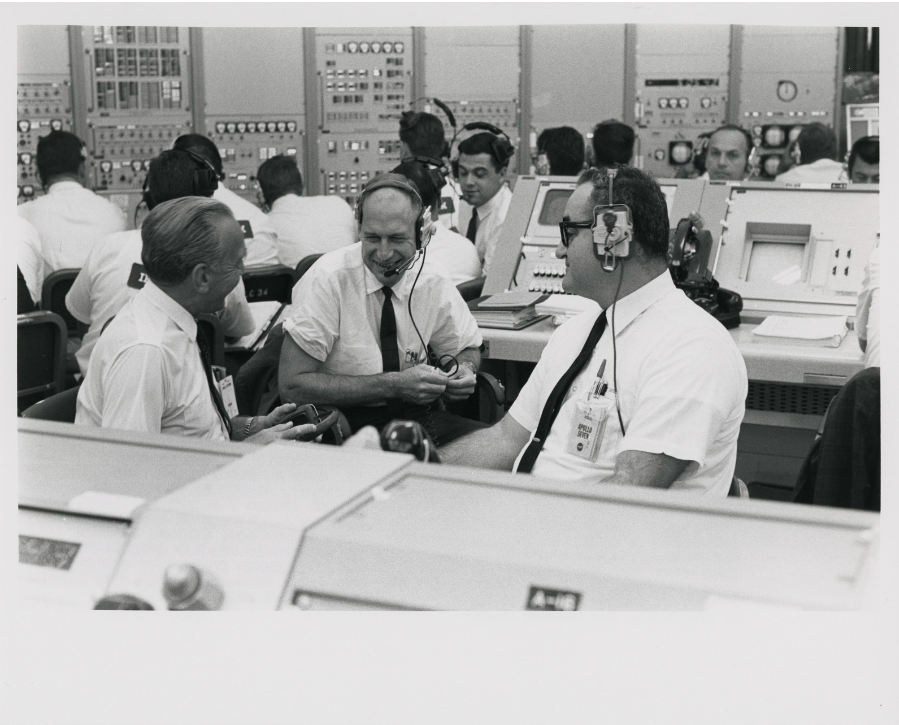 Mentors Kurt Debus, left, and Rocco Petrone, right, during the Apollo 7 flight readiness test in the blockhouse at Complex 34
Mentors Kurt Debus, left, and Rocco Petrone, right, during the Apollo 7 flight readiness test in the blockhouse at Complex 34
Dr. Debus provided Mrs. Morgan with a pathway to becoming an engineer, and she gained certification as a Measurement and Instrumentation Engineer and a Data Systems Engineer, which enabled her to be employed as a Junior Engineer on the launch team. “It was just meant to be for me to be in the launching business,” she says. “I’ve got rocket fuel in my blood.”
As a young woman joining an all-male group, Mrs. Morgan was fortunate that (unbeknownst to her at the time) her immediate supervisor, Mr. Jim White, insisted that the men on the launch team address her professionally, not be “familiar”, and reportedly told them that “You don’t ask an engineer to make the coffee”! (Which, of course, is often a task that falls to the women in any office).
Professional Disrespect
Despite Mr. White’s efforts to create an environment of respect for his first female engineer, Mrs. Morgan has still described experiencing sexism and harassment, treatment similar to the experiences of Miss Northcutt. With no female restrooms in the launch blockhouses at Cape Canaveral, when she needs to use the restroom, she has to ask a security guard to clear out the men’s room so that she can enter. She has reported receiving obscene phone calls at her station (which disappointingly could only have come from colleagues).
However, like Miss Northcutt, while she has said that she sometimes feels a sense of loneliness as the only woman in the team, Mrs. Morgan “wants to do the best job she can” and works the same long hours as her male colleagues. In 1967, as the Apollo programme was ramping up, her dedication to her work had tragic consequences. The stress and long hours of her job contributed to her miscarrying and losing her first child.
 The crowded interior of the blockhouse at Launch Complex 34, where Mrs. Morgan has often worked
The crowded interior of the blockhouse at Launch Complex 34, where Mrs. Morgan has often worked
Perhaps the most shocking example of professional disrespect and harassment (which could be considered an assault) that Mrs. Morgan has experienced was during a test being conducted at the blockhouse for Pad 34, where the first Apollo missions were set to be launched. When preparing to acquire some test results, she was actually struck on the back by a test supervisor, who aggressively told her that “We don’t have women in here!” She had to appeal to her own supervisor, Mr. Karl Sendler (who developed the launch processing systems for the Apollo programme) to confirm that she could remain. He told her to disregard the test supervisor and continue with her work (though it’s not clear if any action was taken against the offending supervisor).
On Console for Apollo-11
The unpleasant incident with the test supervisor prompted many of Mrs. Morgan’s colleagues and senior managers to come forward in expressing acceptance and respect for her as part of the team. Nevertheless, even though she has worked launches for Mercury, Gemini and Apollo, received an achievement award for her work during the activation of Apollo Launch Complex 39, and been promoted to a senior engineer, Mrs. Morgan has frequently found herself rostered for the inconvenient evening shifts. Since her husband is a school teacher and band-leader, this hasn’t always allowed them a lot of time to be together.
Until Apollo-11, Mrs. Morgan was also not selected to be part of the firing room personnel for a launch, usually being stationed at a telemetry facility, a display room or a tracking site for launch. She found this very disappointing, as she always wanted to feel the vibrations from a launch that her colleagues described.
But her desire to experience the incredible shockwave vibrations of a Saturn-V lift-off was finally achieved with the launch of Apollo-11. Recognising that Mrs. Morgan is his best communicator, Mr. Sendler quietly obtained permission from Dr. Debus for her to be the Instrumentation Controller on the console in the firing room for Apollo 11! (This achievement also had the bonus of working day shifts, so that she has been able to spend more time with her husband).
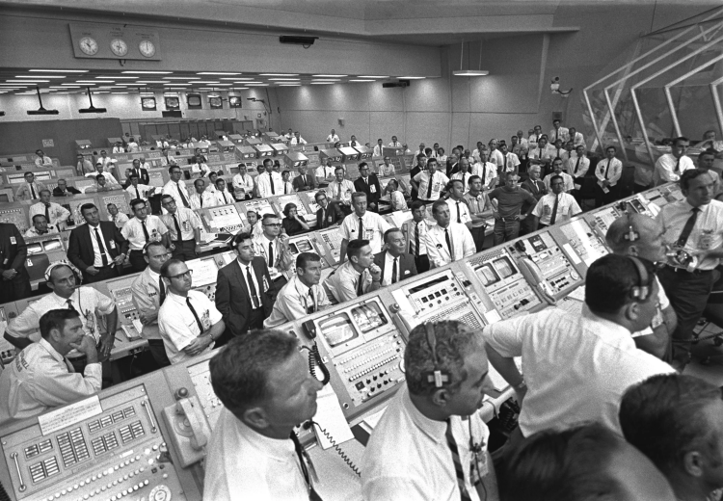 Can you spot the lone woman in a sea of men? In this picture of the Launch Control firing room during Apollo-11, Mrs. Morgan is in the third row, just to the left of centre.
Can you spot the lone woman in a sea of men? In this picture of the Launch Control firing room during Apollo-11, Mrs. Morgan is in the third row, just to the left of centre.
A successful launch is critical to each mission and Mrs. Morgan believes that her prime role in the launch of the historic mission will help to further her career within NASA. Although she has not received the same level of press and television attention as Miss Northcutt, she does hope that even the photos of her in Launch Control – a lone woman in a sea of men – will help to inspire young women to aspire to careers in the space programme, so that, at some time in the future, photos like the ones she is in now “won’t exist anymore.”
Making Packed Lunches for Astronauts: Rita Rapp
You could say that the astronauts are the most fragile component of each Apollo mission. Nutrition is important in keeping crews healthy and functioning during a flight, so space food has to be as appetising as possible, within the constraints of spaceflight and the weightless environment – especially as missions to the Moon, and future space stations and lunar bases will keep astronauts in space for longer and longer periods.
Physiologist Miss Rita Rapp, head of the Apollo Food Systems team, has been looking after the astronauts' bodies – and stomachs – since she joined NASA in 1960. For the Apollo programme, she has developed the space food and food stowage system designed to keep the astronauts supplied with the right mix of calories, vitamins, and nutrients to enable them to function well in space. One of her goals has been to ensure that crews have something worth eating during their spaceflights.
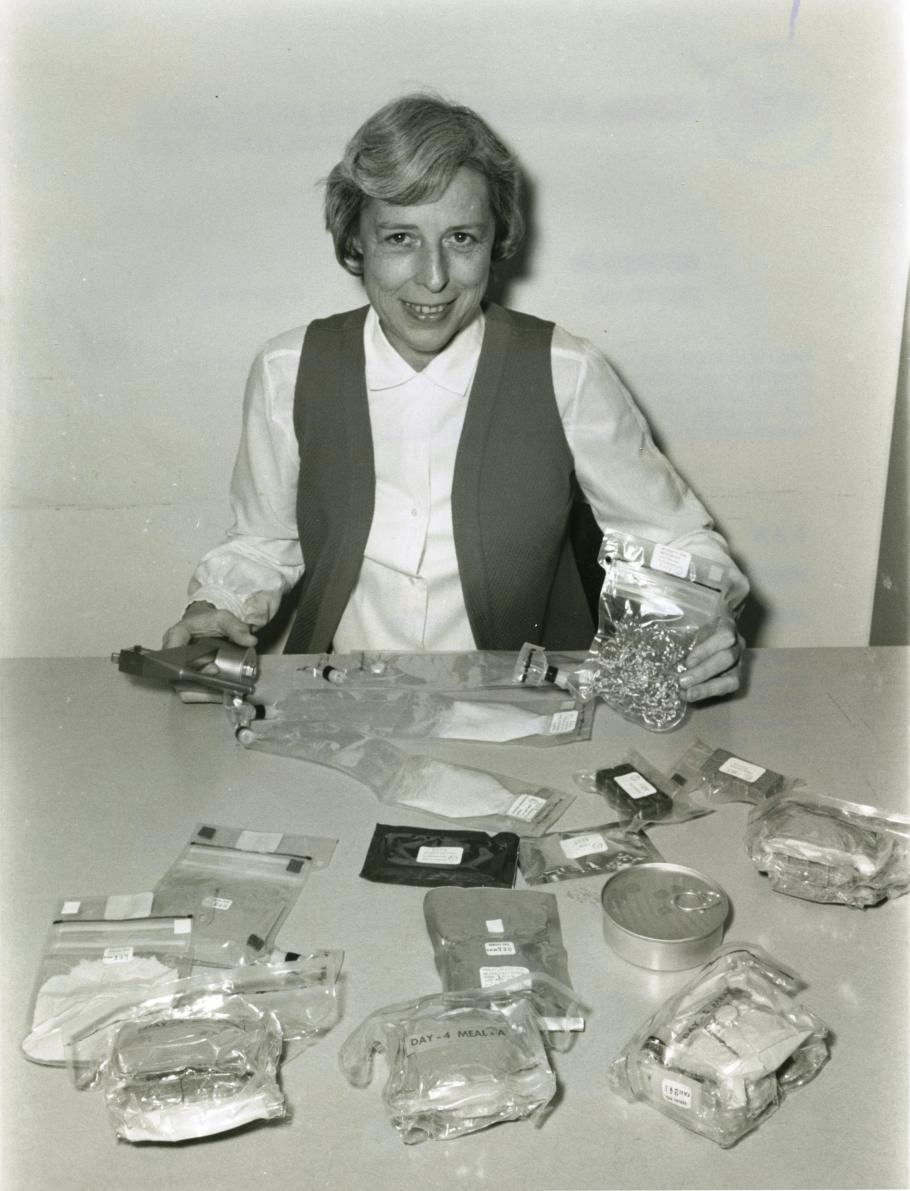 Rita Rapp with some of her space food innovations that have greatly improved the space food menu for Apollo astronauts
Rita Rapp with some of her space food innovations that have greatly improved the space food menu for Apollo astronauts
Born in 1928, Miss Rapp studied science at the University of Dayton and then took a Master’s in anatomy at the St. Louis University Graduate School of Medicine. She was one of the first women to enrol in this school. Graduating in 1953, she took a position in the Aeromedical laboratories at Wright-Patterson Air Force Base, where she began assessing the effects of high g-forces on the human body, especially the blood and renal systems, using centrifuge systems.
In 1960 Miss Rapp joined NASA’s Space Task Group preparing for the Mercury manned spaceflight programme, later transferring to the Manned Spacecraft Centre in Houston. For the Mercury program, she continued her work on centrifugal effects on the human body. She also designed the first elastic exercisers for Mercury and Gemini missions, devised biological experiments for the astronauts to conduct in-flight, and developed the Gemini medical kit.
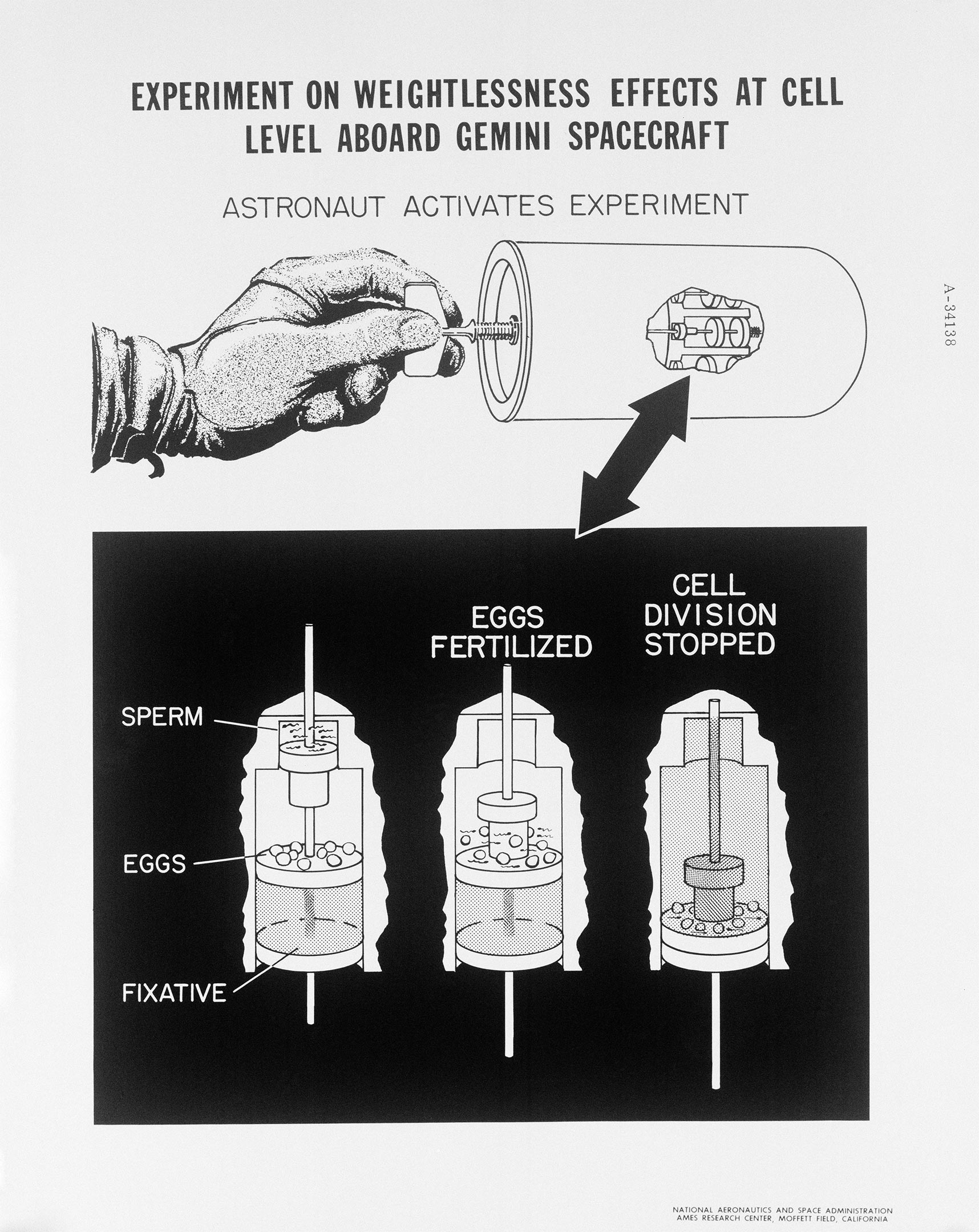 The first Gemini biological experiment, designed by Miss Rapp
The first Gemini biological experiment, designed by Miss Rapp
From Aeromedicine to Space Food
In 1966, as the Apollo programme was ramping up, Miss Rapp joined the Apollo Food Systems team. Although she has continued to work on space health and hygiene projects, in her new role her primary focus became looking at systems for storing food onboard the Apollo spacecraft. Working with dieticians, and commercial companies, she has investigated the ways space food could be packaged and prepared, and become the main interface between NASA’s Food Lab and the astronauts.
Although she tries to use as much commercially available food as possible, Miss Rapp and her team are also continually experimenting with new recipes in the food lab, gradually replacing the earlier “tubes and cubes” style of space food used in Mercury and Gemini with meals that are closer to an everyday eating experience.
She has developed improved means of food preservation, such as dehydration, thermostabilisation, irradiation and moisture control, which allows for a wider range of foods to be suitable for spaceflight, and I have no doubt these useful technologies will find their way into commercial food preparation and onto our supermarket shelves in the not-too-distant future.
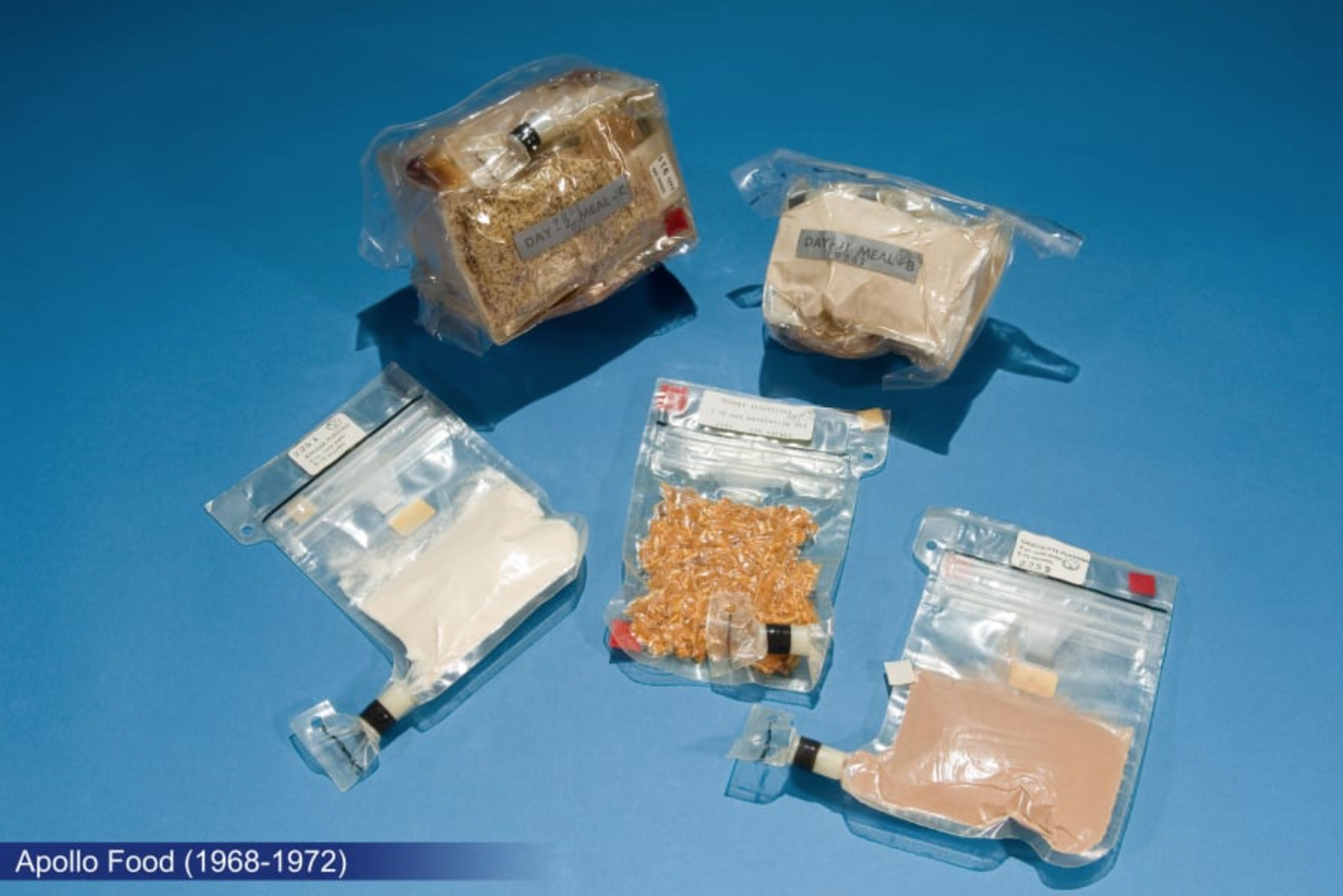
Working with the Whirlpool Corporation, Miss Rapp has developed new forms of food packaging for Apollo, such as the spoon bowls, “wet packs” and cans for thermostabilised food. These containers enable astronauts to eat with more conventional utensils, instead of sucking food out of a tube or plastic bag. Creating a more natural, homelike eating experience is good for the astronauts’ morale and psychological health during missions. You can discover more about Miss Rapp's space food developments in my articles on the various Apollo missions.
Miss Rapp takes great pride in providing the Apollo crews with the flavours and comforts of home. “I like to feed them what they like, because I want them healthy and happy,” she says. She takes note of their individual food preferences, often devises new recipes and prepares the individual meals of each Apollo astronaut separately. Her home-made sugar cookies, that she bakes herself, are a special favourite of Apollo crews, and additional supplies are included as snacks in the onboard food pantries of the Command and Lunar Modules. She also likes to provide the crews with special food “surprises”, such as the turkey dinner enjoyed by the Apollo-8 crew in lunar orbit on Christmas Eve last year.
The women of Apollo who I’ve discussed in this article are trailblazers for women’s participation in mathematics, engineering, and other technical aspects of spaceflight. While they are not the only women in professional roles in the space sector, female participation in space careers, and in science, engineering, and technology more generally, is still very low.
I hope that by highlighting the exciting Apollo-related careers of the four women above, it will plant a seed in the minds of young girls reading the Journey that they, too, can aspire to careers in scientific and technological fields that are generally thought of only as careers for men. I also hope that growing levels of female participation in the workforce, together with feminist activism, will eventually consign the sexism, discrimination and harassment that women working in all careers experience at present, to the history books—though I won’t hold my breath on it happening any time soon.
Two days ago, Apollo 11 blasted off from Cape Kennedy's Pad 39A, destination: Moon. KGJ, our affiliated TV station, will be simulcasting CBS coverage of the landing and Moonwalk starting at noon, Pacific time, on July 20th, and going all day from then.
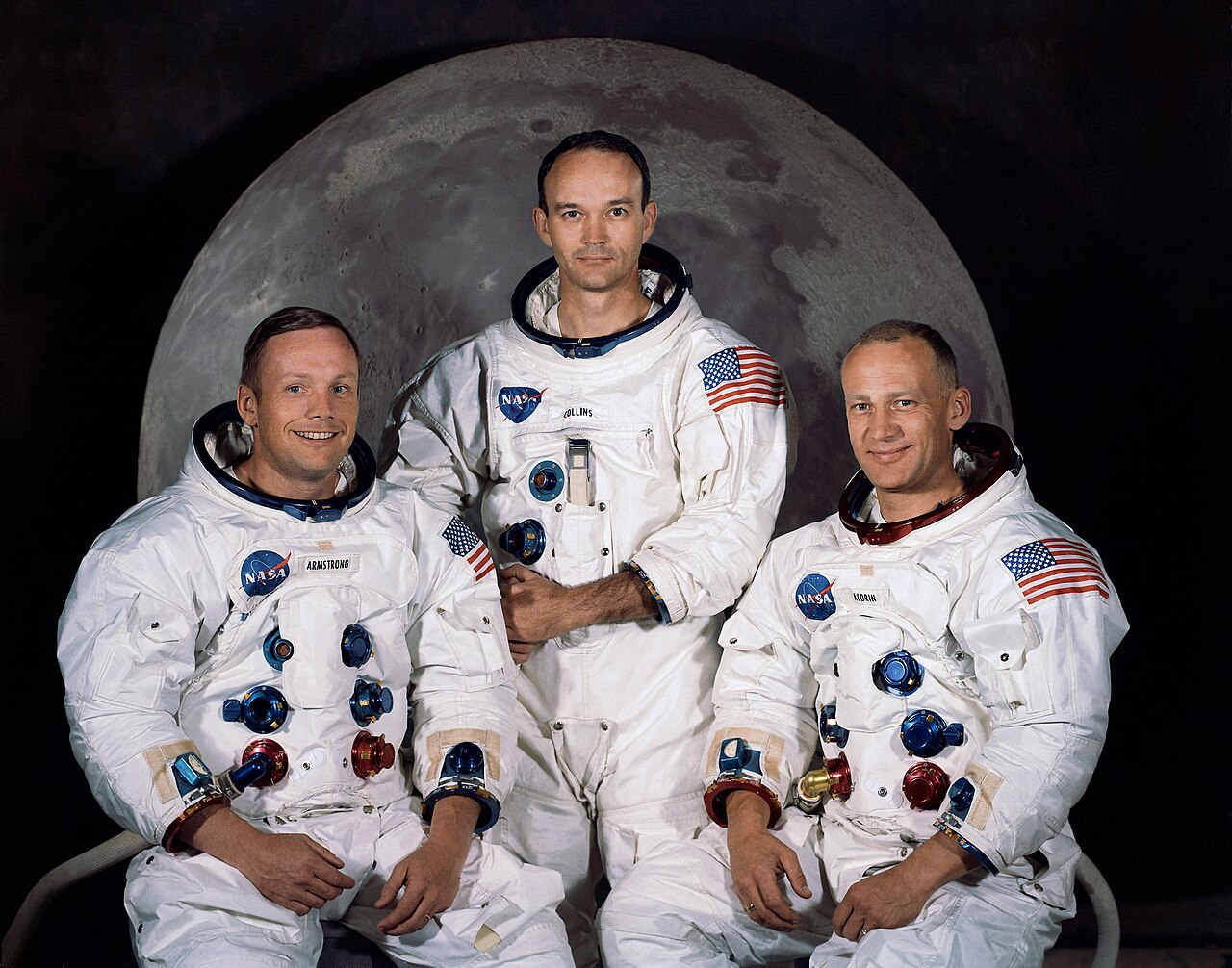
Please join us for this once-in-a-lifetime event!

by Kaye Dee
"Lift off. We have lift off”, Launch Control at Kennedy Space Centre (KSC) excitedly announced, as Apollo 11’s Saturn-V thundered off the pad just two days ago! While a Saturn-V liftoff is no longer a new occurrence at KSC, this launch was special. An astronaut crew is now on the way to fulfill the millenium-old human dream of reaching the surface of the Moon!
Describing Apollo 11 as Mankind’s “greatest adventure” has already become hackneyed and overused. And yet, I didn’t really feel that I could give this article today any other title – because the attempt to land the first astronauts on the Moon is an incredible adventure: some commentators are calling it the greatest human adventure since our hominid ancestors ventured out of Africa to explore the world. Is that hyperbole? Perhaps. But it is a daring exploit to venture out from our home planet, across a totally inimical environment, and actually set foot on another world for the first time.
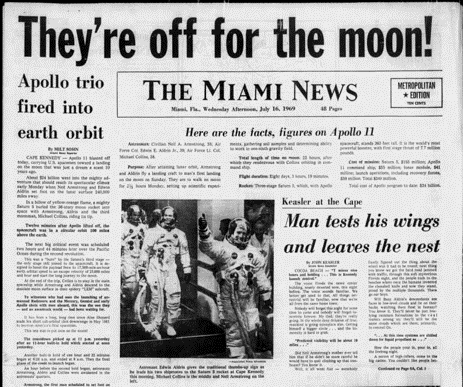
This mission is exciting, complex and – yes – dangerous, so to follow it all, I’m once again going to divide my coverage of it into two parts, beginning today with some background for the mission and its launch. The second part will follow, after the astronauts’ (hopefully) successful return to Earth.
Where to Land?
Operational and engineering considerations have played the major role in dictating where the first astronauts will land on the Moon. Over the last two years, intense analysis has gradually winnowed down some thirty possible landing sites originally suggested based on Lunar Orbiter images and Surveyor lander data and more recent close-up imagery from Apollo-8 and 10.
Several constraint parameters have determined the Apollo-11 landing site and its backup landing locations. The Moon has a peculiar lighting characteristic, in that it reflects the light from the Sun directly back into your face, and it was a concern to the astronauts that they might be dazzled by this reflected light while trying to land. To avoid this, they wanted to have the Sun only about 10 degrees above the horizon, meaning that the Lunar Module (LM) must fly in from the east with the Sun behind it, to land shortly after sunrise, when surface objects cast revealing shadows to identify possible hazards around the landing site.
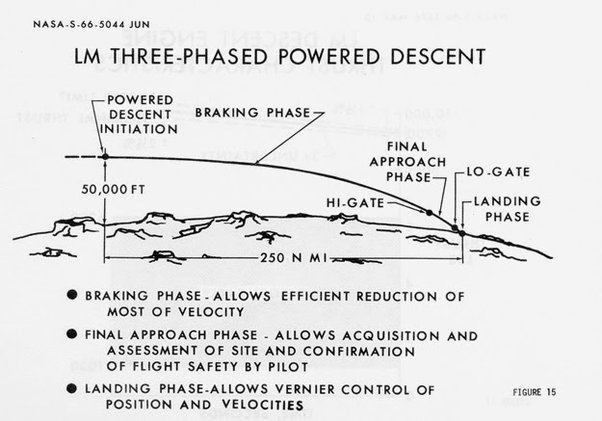
This trajectory for landing means that the landing site had to be east of the lunar meridian, so that if the launch was delayed for a few days, back-up sites would still have suitable lighting. NASA wanted the site to be within 5° of the lunar equator, as a higher latitude site would consume more fuel, and fuel economy is an important consideration for this first landing attempt. Finally, mission planners wanted a relatively flat landing site for the initial landing, free from sharp ridges, large boulders or steep sided craters.

A “Water Landing” on a Dry World
These constraints required the location for the first manned lunar landing to be a “mare” region (those areas thought by ancient sky-gazers to be lunar seas) near the Moon’s equator, with the choice settling on the Mare Tranquillitatis (Sea of Tranquility). This area provided two possible landing targets designated ALS (Apollo Landing Site)-1 and ALS-2.
 Map showing the final five prospective landing sites for Apollo-11. Site 2 is the selected location for the landing attempt
Map showing the final five prospective landing sites for Apollo-11. Site 2 is the selected location for the landing attempt
The selected site, ALS-2, is only 25 kilometres southeast of the Surveyor-5 landing site, and when Apollo 10 made a low pass over the spot it received a favourable report from Commander Tom Stafford.
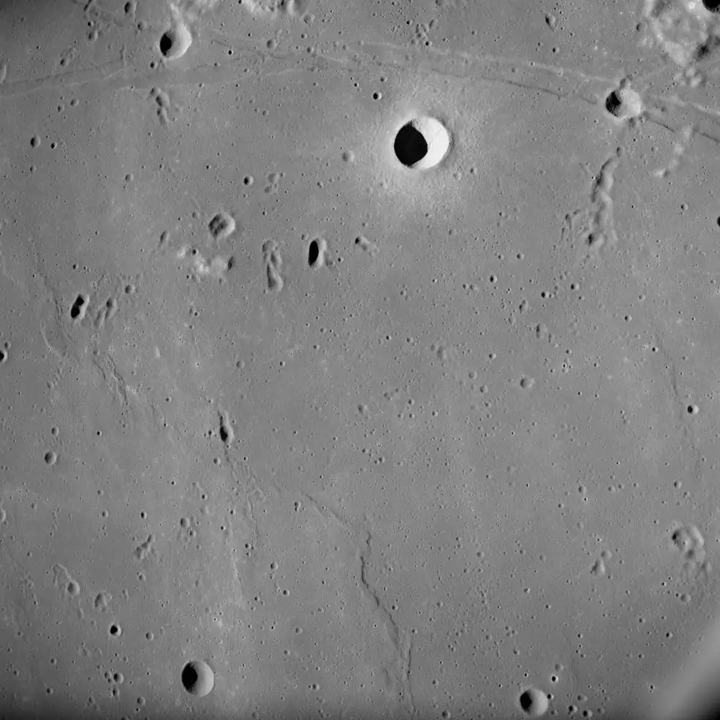 Apollo-10 view of the Apollo-11 landing site
Apollo-10 view of the Apollo-11 landing site
ALS-2 would also allow a two-day recycle in the case of a delay, to the next back-up site in Sinus Medii. Last, but not least, the choice of ALS-2 has made the scientists happy, since it will provide them data from a typical mare site.
A Crew to Make History
For the astronauts of Apollo-11, becoming the crew that would make the historic first lunar landing attempt has been a matter of luck and crew rotation, rather than deliberate selection. As the back-up crew for Apollo-8, Neil Armstrong and Edwin Aldrin were automatically rotated into the prime crew for Apollo-11. The third member of that back-up team, Fred Haise, was replaced by Michel Collins, following his return to flight status after surgery for a bone spur in his neck. (Haise has now been switched to the Apollo 14 crew).
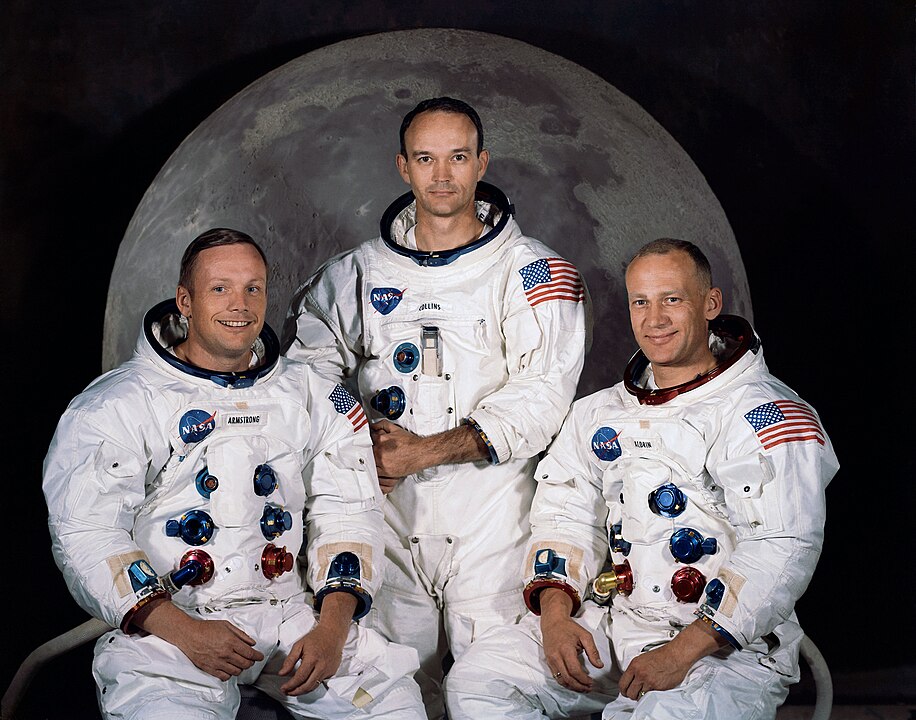 L. R. Neil Armstrong, Michael Collins and Edwin "Buzz" Aldrin
L. R. Neil Armstrong, Michael Collins and Edwin "Buzz" Aldrin
We already know that Apollo-10 was a brief contender to make the first landing attempt, while had that mission failed to achieve all its “rehearsal” objectives, Apollo-11 would now be repeating its flight plan. In that case, Apollo-12 would have become the first landing attempt – and should Apollo-11 fail to achieve its landing objective, Apollo-12 may yet become the first Moon landing mission.
While perhaps not “hand-picked” for the job, the current Apollo-11 crew, formally announced on 9 January this year, are certainly up to the task of ensuring the success of this history-making spaceflight!
 Apollo-11 crew portrait at the announcement of their selection
Apollo-11 crew portrait at the announcement of their selection
Spaceflight Veterans
Each member of the Apollo-11 crew is a veteran of one previous space mission, so we have met them before in the annals of the Journey.
Mission Commander Mr. Neil Armstrong, 38, was the Command Pilot of the Gemini-8 mission, which experienced NASA’s first in-flight emergency. He safely rescued that mission by drawing on his extensive test flight experience. As a civilian, Mr. Armstrong earns $US22,500 a year from NASA, making him the most highly paid of all the astronauts.
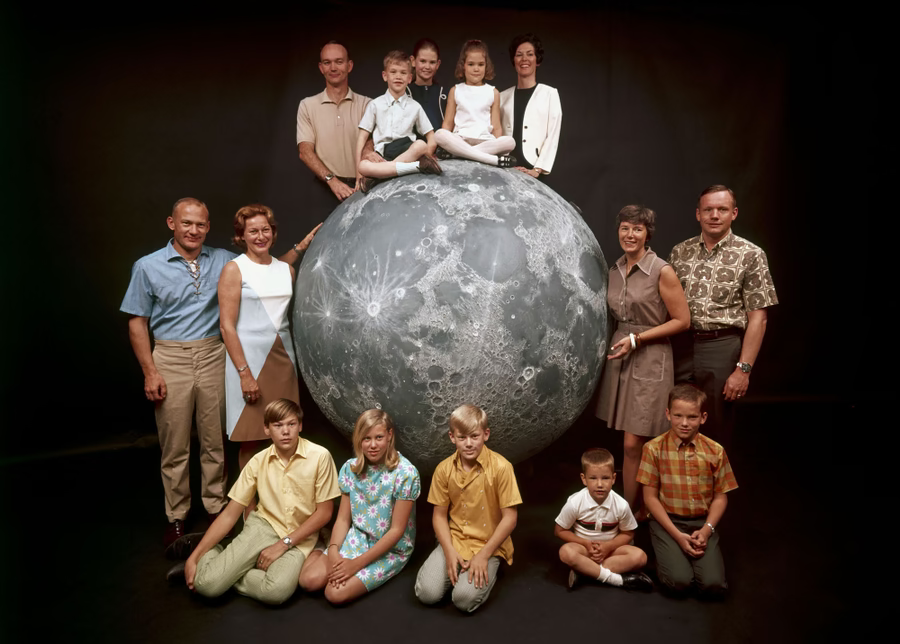 A lovely portrait of the Apollo-11 crew with their wives and children, from Life magazine
A lovely portrait of the Apollo-11 crew with their wives and children, from Life magazine
USAF Colonel Edwin Aldrin, 39, known to his family as “Buzz” and to his astronaut colleagues as Dr. Rendezvous, is the designated Lunar Module Pilot (LMP). Col. Aldrin was the Pilot of Gemini-12, performing three successful spacewalks. If the onboard radar fails, this is a man who can manually complete the rendezvous using a sextant and a slide rule!
Also a Colonel in the US Air Force, Michael Collins is the Command Module Pilot (CMP) for this mission. His first spaceflight was Gemini-10, for which he was the Pilot, performing both a “stand-up” EVA (standing in the hatch of the spacecraft) and a partially-successful spacewalk.
Who’s First Out the Hatch?
At the very first press conference for the Apollo 11 crew in January, on the assumption that it would be the first landing mission, a reporter raised the question of who would be the first astronaut to step onto the Moon. Early mission flight plans and timelines noted that the LM Pilot would step out first, and this scenario was consistent with the practice on the Gemini missions, where the Pilot would make the Extravehicular Activities (EVAs), rather than the Command Pilot.
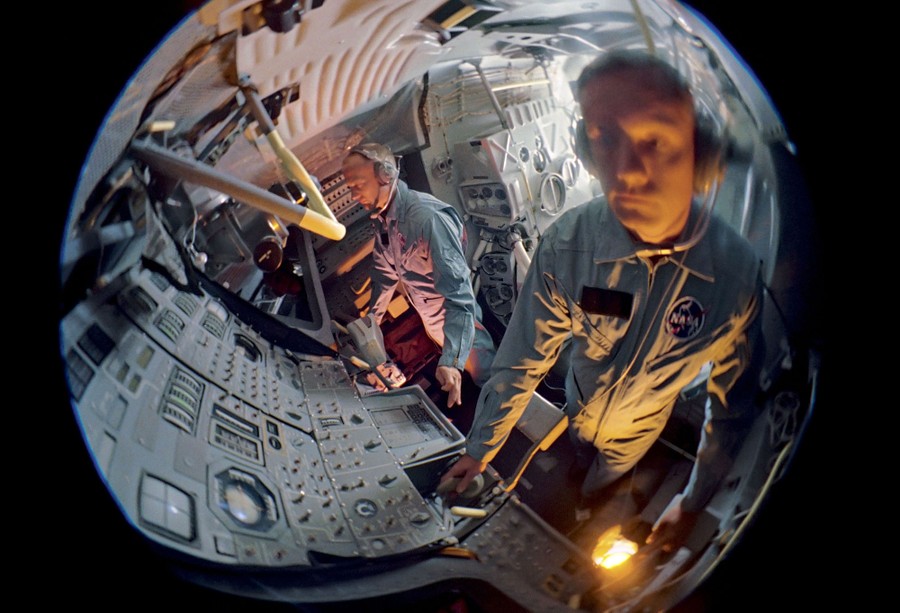 Fish-eye view of astronauts Aldrin and Armstrong as they train in a mock-up lunar module
Fish-eye view of astronauts Aldrin and Armstrong as they train in a mock-up lunar module
However, in April it was announced that Mr. Armstrong, as mission commander, would be the first to step onto the lunar surface. Col. Aldrin, apparently expecting to be first out of the hatch, is rumoured to have been put out by this, especially when there were some stories flying around that he had been sidelined in favour of Armstrong because the commander was a civilian. Aldrin is said to have felt this to be a slight to the military.
A Quiet Hero
There is an official NASA rationale for the decision that Mr. Armstrong should be the first person to exit the LM and step onto the lunar surface: the interior design of the Lunar Module and the physical locations of the two astronauts inside the cabin makes it more practical for Armstrong to be the first one out. As LMP, Col. Aldrin will stand on the right side of the LM, while Mr. Armstrong, on the left, will be closest to the hatch opening.
 Diagram of a forward view of the LM, showing the Commander's station the let and the LMP station to the right. It would have been difficult for Armstrong and Aldrin to swap places in this very cramped interior
Diagram of a forward view of the LM, showing the Commander's station the let and the LMP station to the right. It would have been difficult for Armstrong and Aldrin to swap places in this very cramped interior
I have heard through the grapevine at the Honeysuckle Creek Tracking Station that senior NASA managers decided unanimously in March that they wanted Mr. Armstrong to be the First Man on the Moon, because they felt that the first human to set foot on another world should be someone like the pioneering aviator Charles Lindbergh – a calm and quiet person. Armstrong fitted this mould as “the example of the great American hero – calm, quiet, softly spoken, with absolute confidence and with no ego”.
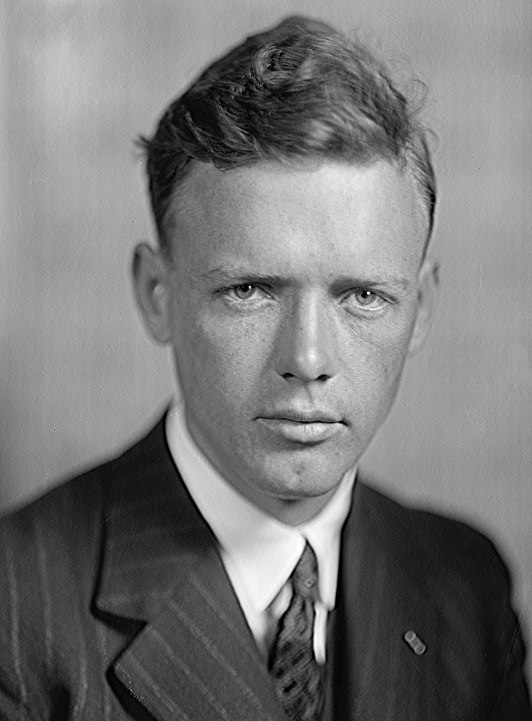
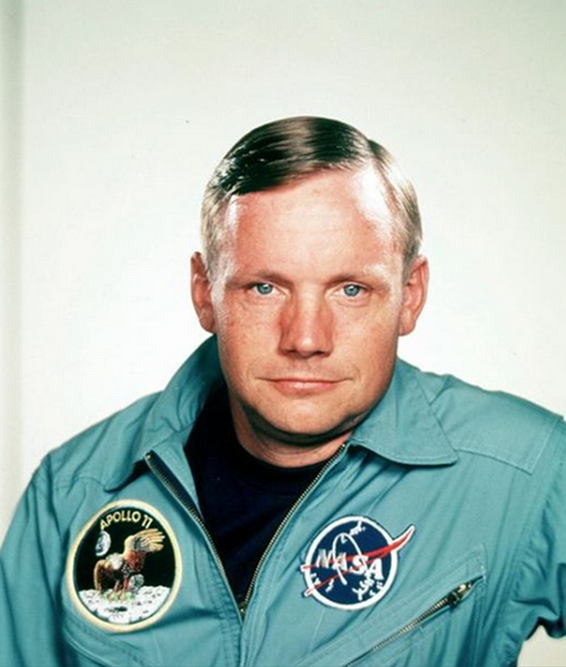 Charles Lindbergh and Neil Armstrong – seen by NASA managers as two men in the same quietly heroic mould. There is certainly something similar in their facial expressions
Charles Lindbergh and Neil Armstrong – seen by NASA managers as two men in the same quietly heroic mould. There is certainly something similar in their facial expressions
Flight Operations Director Deke Slayton is also said to have felt that, as Commander, it was a matter of protocol that Mr. Armstrong should be first out the hatch, especially as he was senior to Col. Aldrin, having joined the astronaut corps in Group Two, while Aldrin entered in Group Three.
But whatever the reasoning, as long as the landing on the lunar surface is a success, Neil Armstrong looks set to become the astronaut whose name will reverberate through history as the First Man on Moon in just a few days’ time.
Symbolic Callsigns
As was the case with Apollo-9 and 10, Apollo-11 requires separate callsigns for the Command and Lunar Modules when they are operating independently at the Moon. Given the globally significant nature of this flight, and its symbolic role in winning the Space Race for the United States by landing the first astronauts on the lunar surface ahead of the USSR, the crew, according to Mr. Armstrong, were inundated with suggestions for the names of their spacecraft.
NASA Public Affairs wanted the Apollo-11 crew to be “less flippant” in selecting their spacecraft names following the more light-hearted choices of the Apollo-9 and 10 crews. While I’ve heard that the names Snowcone (CM) and Haystack (LM) were referred to early in mission planning, ultimately the Apollo-11 astronauts selected the names Columbia (for the CM) and Eagle (for the LM) as being suitably representative of the historic nature of the mission.
 1915 US coin depicting Columbia and the American eagle
1915 US coin depicting Columbia and the American eagle
Columbia (a feminine form derived from the name of Christopher Columbus) is the traditional female personification of the United States. This name is also a nod to Jules Verne’s spacecraft “Columbiad” (from the 1865 novel From the Earth to the Moon), which was the name the Apollo-8 crew wanted to use for their historic Command Module.
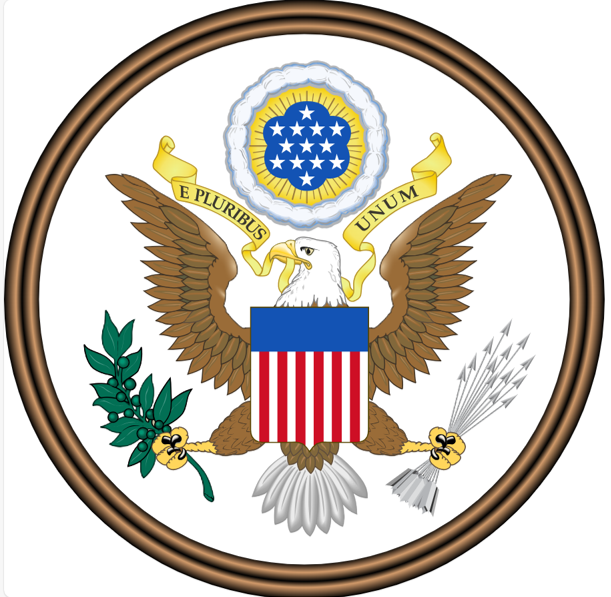 The obverse of the Great Seal of the United States depicts a bald eagle carrying both an olive branch and a bundle of arrows in its claws, symbolising war and peace
The obverse of the Great Seal of the United States depicts a bald eagle carrying both an olive branch and a bundle of arrows in its claws, symbolising war and peace
The bald eagle is, of course, the symbolic bird of the United States, depicted on the Great Seal of the United States and the National Coat of Arms. It also appears on the seal of the US Department of the Air Force – and Col. Aldrin and Col. Collins are both USAF officers.
And a Symbolic Mission Patch
The association of the eagle with the United States is a motif that also occurs in the design of the Apollo-11 mission patch. In fact, the deciding factor in selecting the name “Eagle” for the Lunar Module was the patch design already under development, that depicted an American bald eagle landing on the Moon.

Mr. Armstrong’s backup, Captain Jim Lovell, is credited with originally suggesting the symbol of an eagle on the mission patch.
Some early sketches for an Apollo 11 patch were prepared by Allen Stevens of Rockwell International, who has been involved with the development of several Apollo mission patches, but Astronaut Collins seems to have had a major role in the final design.
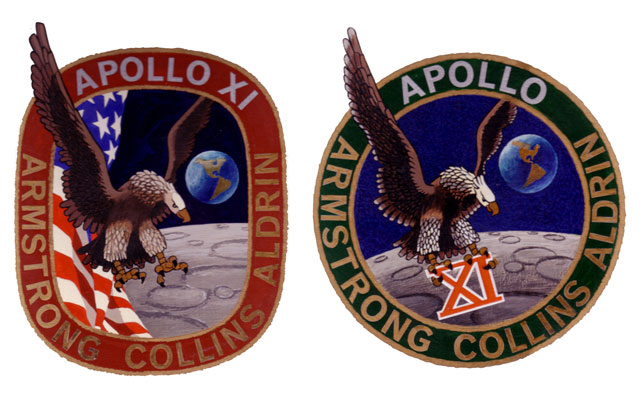 Allen Stevens early designs for the Apollo-11 patch incorporated the names of the crew and the Roman numeral XI
Allen Stevens early designs for the Apollo-11 patch incorporated the names of the crew and the Roman numeral XI
Col. Collins found a depiction of a bald eagle in a National Geographic book on birds that he considered ideal – the eagle with its wings partially folded, swooping down with its talons extended.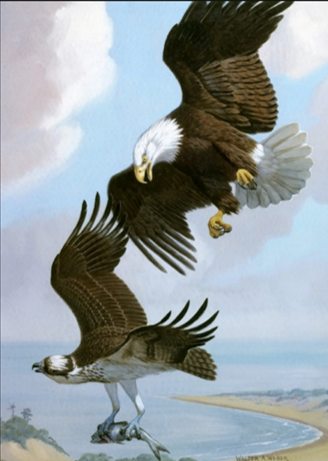
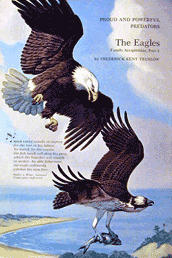 (left) A beautiful eagle painting by National Geographic Society staff artist Walter A Weber, first published in the July 1950 issue of National Geographic magazine, was re-used and re-oriented (below) for the book that inspired Michael Collins
(left) A beautiful eagle painting by National Geographic Society staff artist Walter A Weber, first published in the July 1950 issue of National Geographic magazine, was re-used and re-oriented (below) for the book that inspired Michael Collins
Tracing the picture, Collins then sketched in the Moon’s surface to give the impression that the eagle was landing, and included an image of the Earth in space in the background above the eagle’s right wing. In the final patch design, the eastern seaboard of the United States and parts of the northern portion of South America are visible on the globe, with a scattering of white clouds over the blue oceans.
As the design evolved, the crew decided on a departure from previous patch designs, leaving off their own names so that the patch could be said to represent all the people involved in the mission, not just the astronauts. Since Armstrong felt that the Arabic number ‘11’ would be more easily understood around the world, the use of the Roman numeral, or Collins’ suggestion of writing out “eleven” were both dropped as design elements.
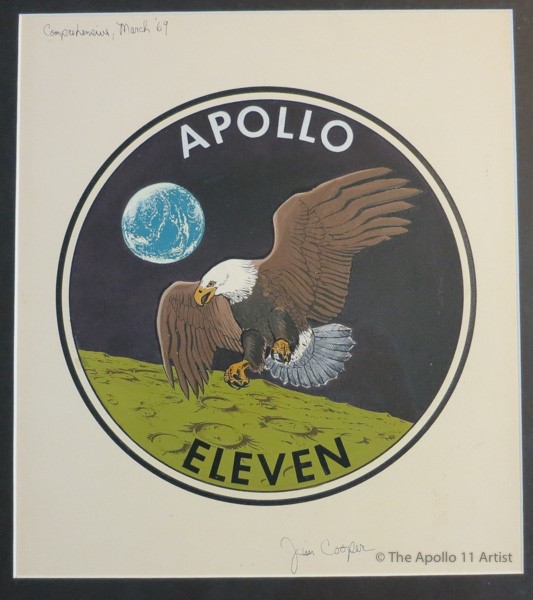 An interim step towards the final mission patch design
An interim step towards the final mission patch design
Images and Impressions Matter
NASA simulator instructor Tom Wilson suggested that the eagle carry an olive branch, as a symbol of the United States’ peaceful intentions in landing on the Moon.
 The olive branch was added to the design, depicted as being carried in the eagle’s beak. To round out their design, the three astronauts selected a naturalistic black for the sky, with blue and gold edging around the around the outside of the circular patch.
The olive branch was added to the design, depicted as being carried in the eagle’s beak. To round out their design, the three astronauts selected a naturalistic black for the sky, with blue and gold edging around the around the outside of the circular patch.
NASA illustrator James Cooper produced the finished artwork for this design. However, when the crew submitted it for approval, it was rejected on the basis that the eagle’s powerful talons, extended stiffly below it, were "too warlike", and might give a wrong impression in our Cold War environment, where propaganda imagery matters.
Recalling that in the Great Seal, the eagle carries an olive branch in one set of talons, the olive branch was switched from the beak to the eagle’s claws. Although Col. Collins expressed the thought that “the bird looked a little uncomfortable” depicted in this way, the design was approved and became the official mission patch.
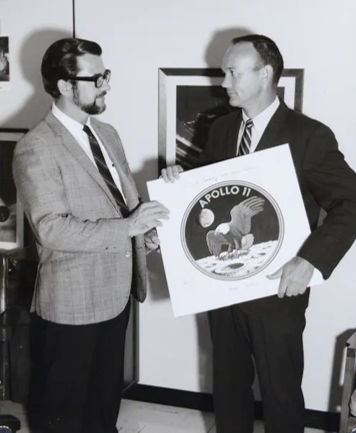 Artist James Cooper hands over the finsihed version of the final artwork for the Apollo 11 patch to Astronaut Collins
Artist James Cooper hands over the finsihed version of the final artwork for the Apollo 11 patch to Astronaut Collins
Tracking Apollo to the Moon
For the previous Apollo missions, I hadn’t written in any detail about the worldwide NASA tracking network that will be following every second of Apollo-11’s voyage to the Moon and back. Time to fix that, as none of the lunar missions would have been possible without it.
NASA’s global Manned Space Flight Network (MSFN) will be constantly monitoring the flight, using the resources of 17 stations, 4 ships and the 8 aircraft that form the Apollo Range Instrumented Aircraft (ARIA) fleet.
 Map showing the MSFN deployment for Apollo-11's Trans Lunar Injection. The irregular circles mark the reception areas of each tracking station, ship or aircraft
Map showing the MSFN deployment for Apollo-11's Trans Lunar Injection. The irregular circles mark the reception areas of each tracking station, ship or aircraft
Three MSFN stations – at Goldstone in California, Honeysuckle Creek, near Canberra, Australia, and Fresnedillas, near Madrid, Spain – were specifically constructed to support the Apollo missions, being deliberately sited close to existing stations in NASA’s Deep Space Network (DSN) so that the two networks could work together for lunar operations.
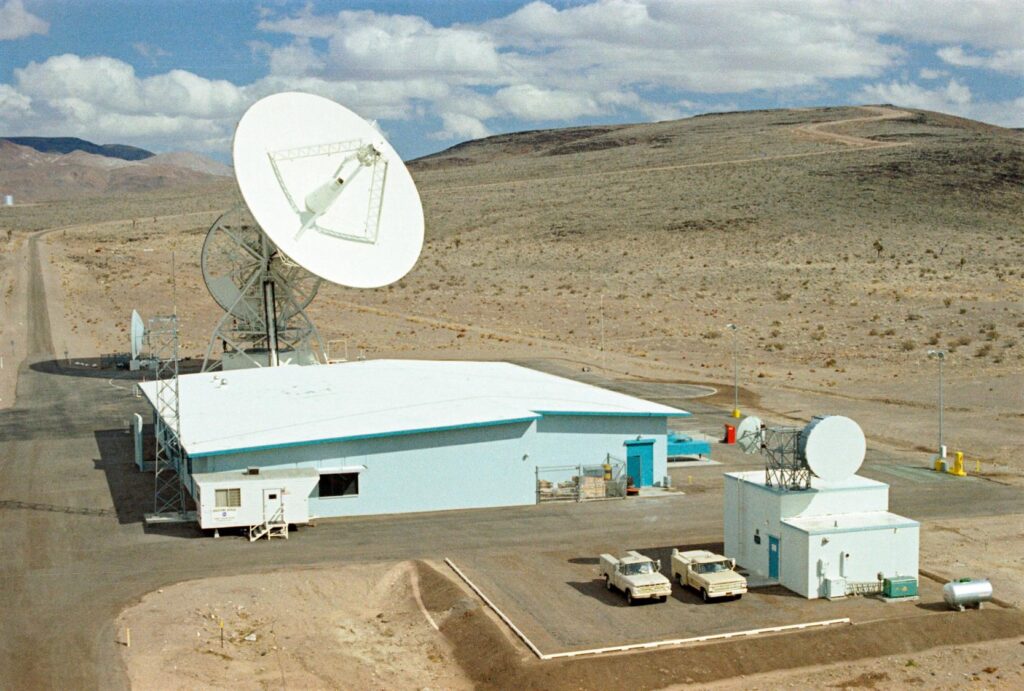 The MSFN tracking station at Goldstone, California
The MSFN tracking station at Goldstone, California
Working Together
The DSN facilities at Goldstone, Canberra and Madrid (which have similar 85ft dishes to those used by the MSFN), will be shadowing the MSFN stations to provide back-up, as well as complementing spacecraft communications at the Moon. During the period when the Columbia and Eagle will be operating independently – with the CM in lunar orbit, while the LM transports Armstrong and Aldrin to the lunar surface and back and during their surface activities – the DSN facility will support tracking and communication with one spacecraft while the MSFN station supports the other.
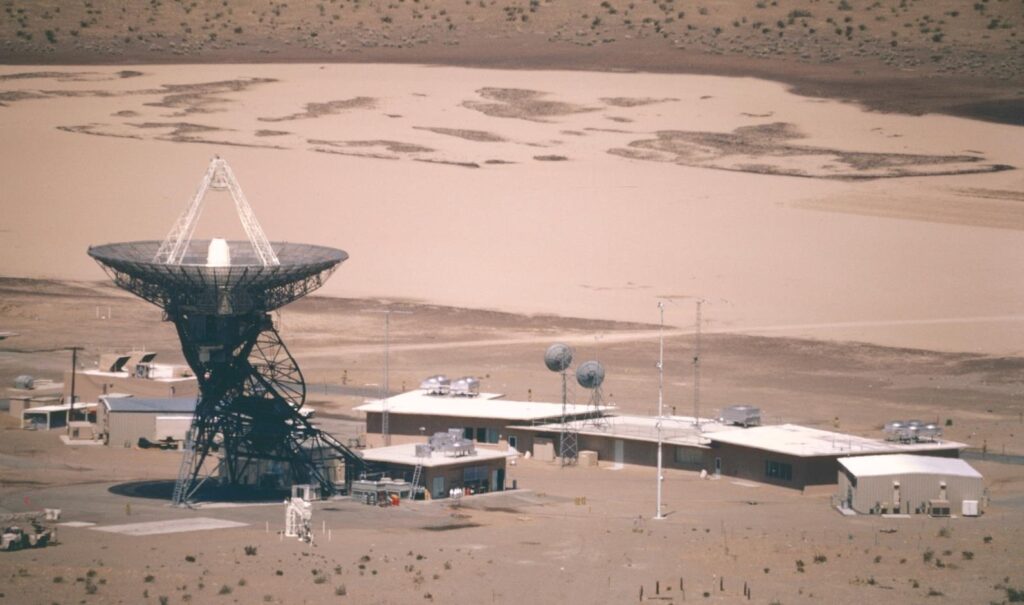 The "Pioneer" DSN antenna at Goldstone, with its "Apollo Wing", housing the equipment added to support Apollo missions
The "Pioneer" DSN antenna at Goldstone, with its "Apollo Wing", housing the equipment added to support Apollo missions
In addition, for the planned live television broadcast from the lunar surface during the LM crew’s historic first Moonwalk, the new 210ft antenna at Goldstone is anticipated to be the prime receiving station for the signals from the Moon, with the Parkes Radio Telescope in Australia providing back-up. I’ve mentioned the Parkes telescope previously, in conjunction with the Our World global satellite television broadcast, but what is not generally known is that the design of this 210ft radio telescope was, in fact, the prototype on which the new 210ft dishes of the DSN are based.
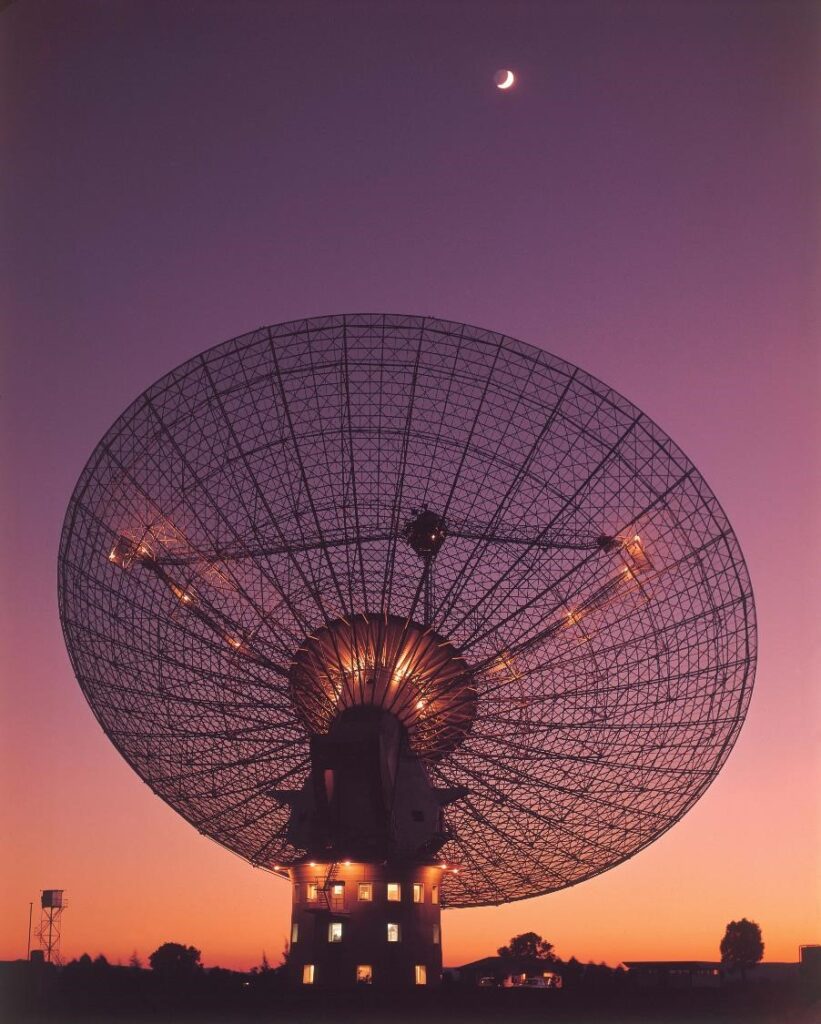 The Parkes Radio Telescope, photographed on the evening of Apollo 11's launch
The Parkes Radio Telescope, photographed on the evening of Apollo 11's launch
 The new "Mars" 210ft antenna at Goldstone
The new "Mars" 210ft antenna at Goldstone
A Tough Training Schedule
It’s hard to believe today that when Alan Shepard made the first Mercury spaceflight, he had only conducted 150 hours of mission simulations. Given the critical nature of the Apollo-11 flight, Armstrong, Aldrin and Collins worked 14-hour days, 6 days a week for a full 6 months before the mission. They each spent over 1,200 hours in simulators wrestling with a continuous stream of missions, frequently peppered with emergencies, equipment malfunctions, and potential catastrophes to test their knowledge, skill, and coolness to the limits.
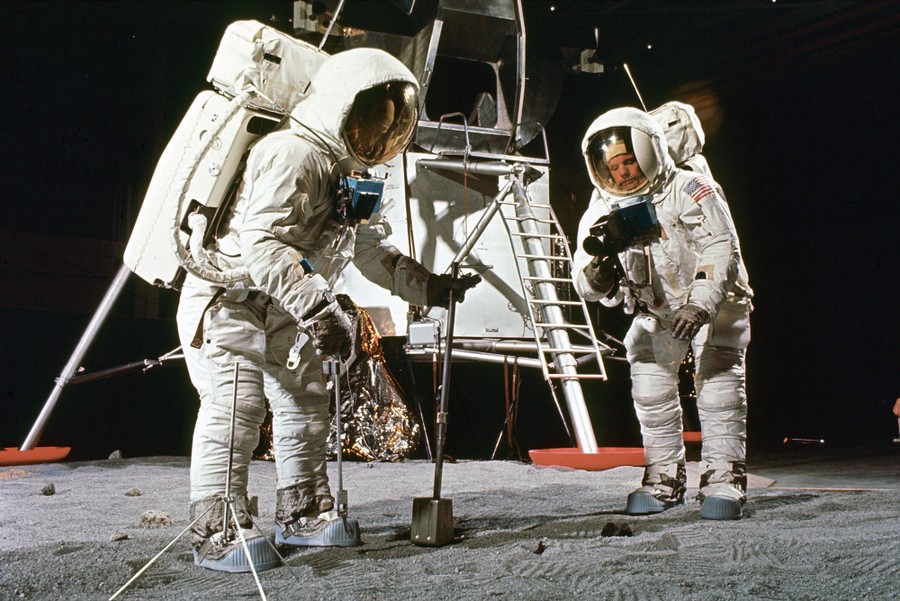 Armstrong and Aldrin practicing their lunar surface activities
Armstrong and Aldrin practicing their lunar surface activities
 CMP Collins concentrates during a session in the LM simulator
CMP Collins concentrates during a session in the LM simulator
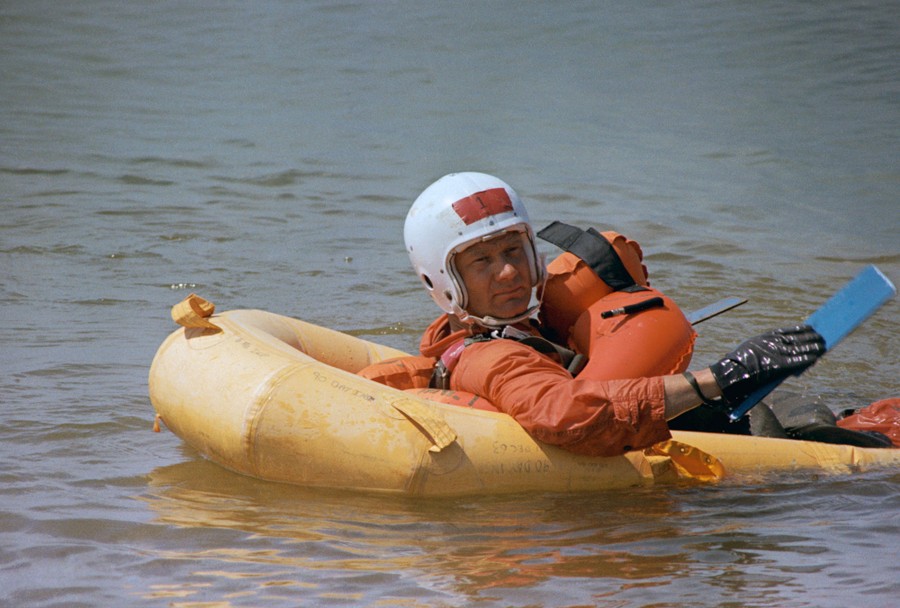 Col. Aldrin during survival training at the U.S. Air Force Air Defense Command Life Support School in Texas
Col. Aldrin during survival training at the U.S. Air Force Air Defense Command Life Support School in Texas
It's well-known that Mr. Armstrong has demonstrated his coolness in emergency situations. Not only did he successfully bring the stricken Gemini-8 safely back to Earth, in May last year, he survived the crash of a Lunar Landing Research Vehicle and shortly afterwards was back at work in his office at the Manned Spacecraft Centre as if his narrow escape had not occurred!
Scientist-Astronaut Dr. Harrison “Jack” Schmitt, a professional geologist, also worked extensively with the Apollo-11 crew, preparing them for lunar rock collecting. After such thorough preparation, the astronauts surely know every twist and turn of the normal and emergency operational procedures, as well as every capricious component of the spacecraft’s 26 subsystems.
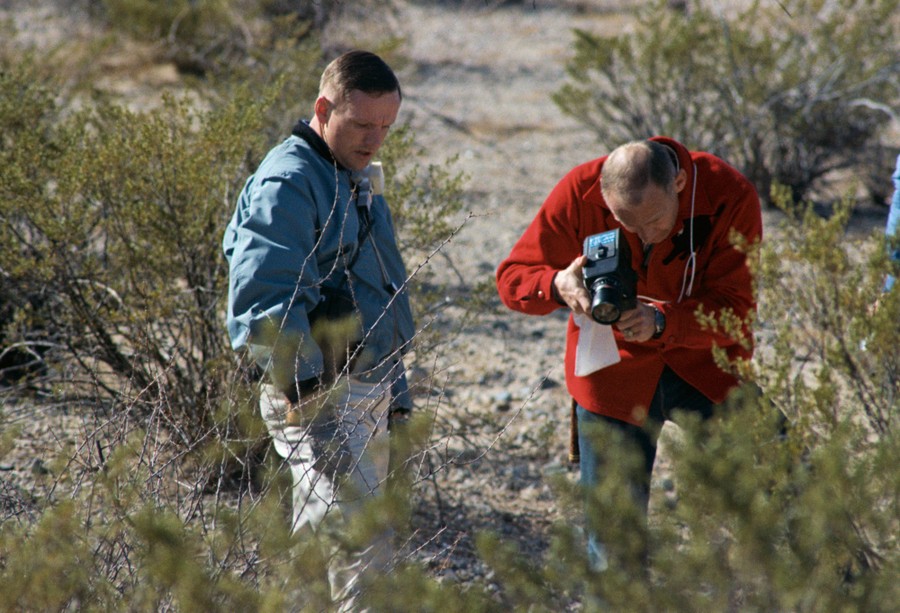 Mr. Armstrong and Col. Aldrin on a geology field trip at Sierra Blanca, Texas
Mr. Armstrong and Col. Aldrin on a geology field trip at Sierra Blanca, Texas
Bringing It All Together
Apollo-11’s Lunar Module, LM-5 and its Command and Service Modules, CSM-107, arrived at Kennedy Space Centre in January. LM-5 has several differences from Apollo 10's Lunar Module, customising it for an actual landing on the Moon. These include: a VHF radio antenna to facilitate communication with the astronauts during their time on the lunar surface; a lighter ascent engine and more thermal protection on the landing gear. The LM is also carrying a scientific instrument package – the Early Apollo Scientific Experiments Package (EASEP), which will be deployed on the Moon.
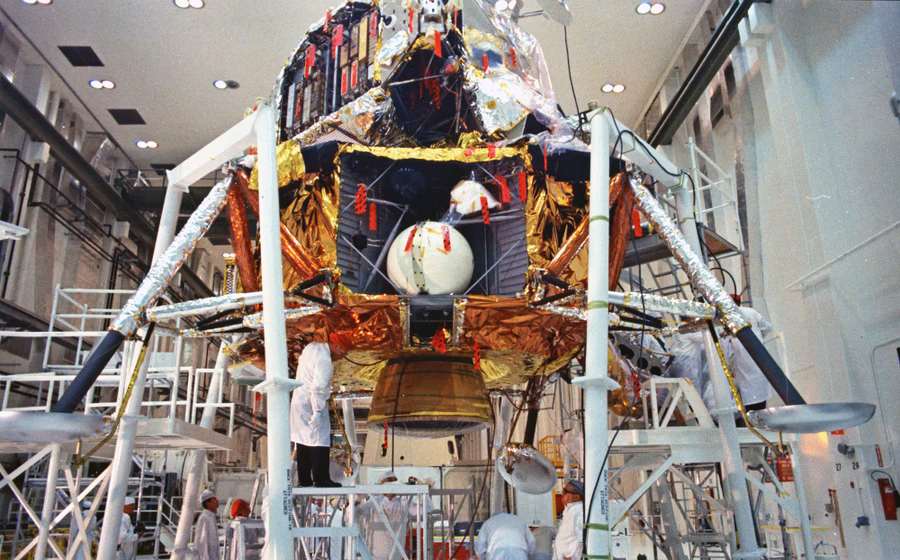 LM-5 being checked out at KSC prior to being installed for launch in in the Saturn-V
LM-5 being checked out at KSC prior to being installed for launch in in the Saturn-V
Apollo-11’s Saturn-V vehicle, AS-506, was rolled out of the Vehicle Assembly Building on 20 May, and transported to Launch Pad 39A while Apollo 10 was still on its way to the Moon. A countdown test was conducted between 26 June and 2 July, which went extremely smoothly, without any major issues – hopefully a good omen for the entire mission.
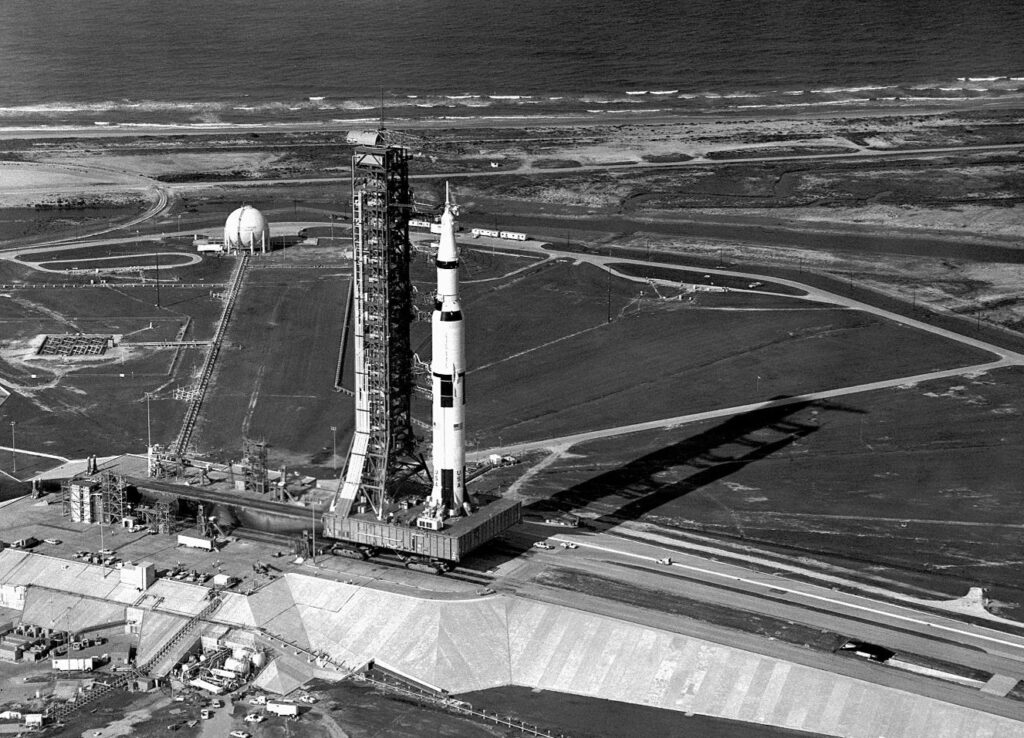 The Apollo-11 launch vehicle arrives at Pad 39A, in preparation for the historic flight
The Apollo-11 launch vehicle arrives at Pad 39A, in preparation for the historic flight
Avoiding Any Infections
To prevent the crew from picking up any infections that might lead to illnesses causing delays to the mission, since a brief visit home with their families (whom they will not see up close again after their release from quarantine in August if all goes to plan) for the Fourth of July holiday, the astronauts have been kept carefully isolated from all un-necessary contacts.
A dinner with the crew, proposed by President Nixon for the night before launch, was cancelled, while at their last press conference before the launch, Mr. Armstrong and Colonels Aldrin and Collins were stragetically placed on a platform so that air flowed from behind them towards the assembled press corps, in hope that this would keep any germs from the audience reaching the astronauts!
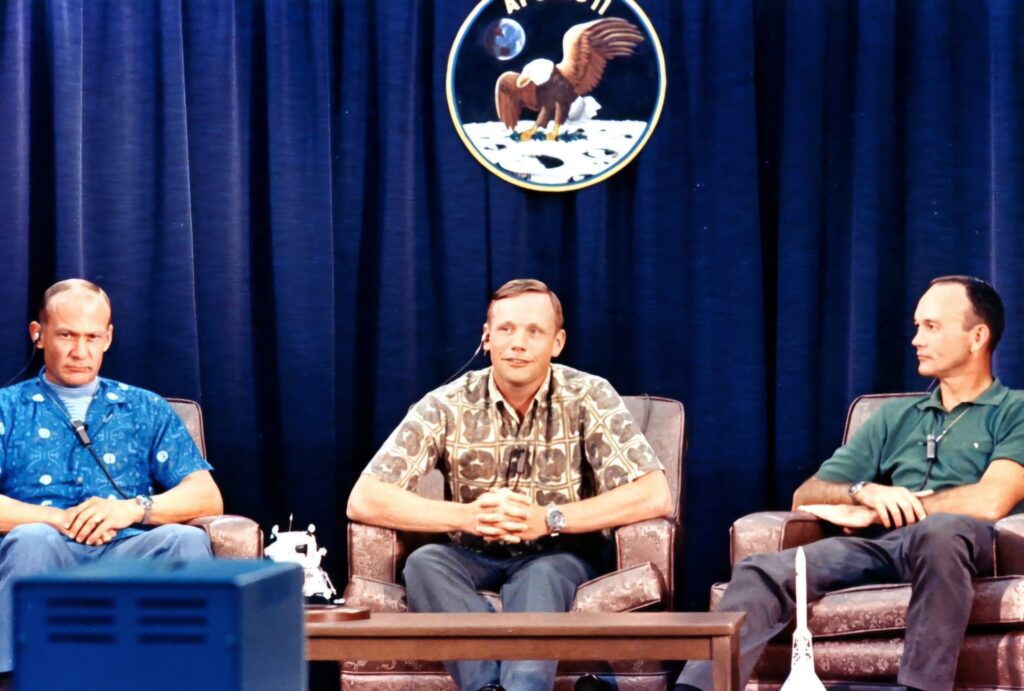 The Apollo-11 crew at their final press conference, hoping to avoid any germs!
The Apollo-11 crew at their final press conference, hoping to avoid any germs!
At their final medical checks, all three astronauts were pronounced fit and ready for flight – so one assumes that the precautions worked as intended.
Pre-flight Preparations
The final preparations for Apollo-11’s launch continued the now established pattern for Apollo missions, with an early morning wake-up for the crew, the traditional pre-flight breakfast of steak and eggs with Flight Operations Director Deke Slayton and the backup crew, followed by the ritual of suiting up. A small folding shovel with plastic sample bags were placed in the special pocket of Mr. Armstrong’s spacesuit, to be used should the astronauts’ stay on the Moon be cut short for any reason: at least they would return to Earth with a few lunar soil samples.
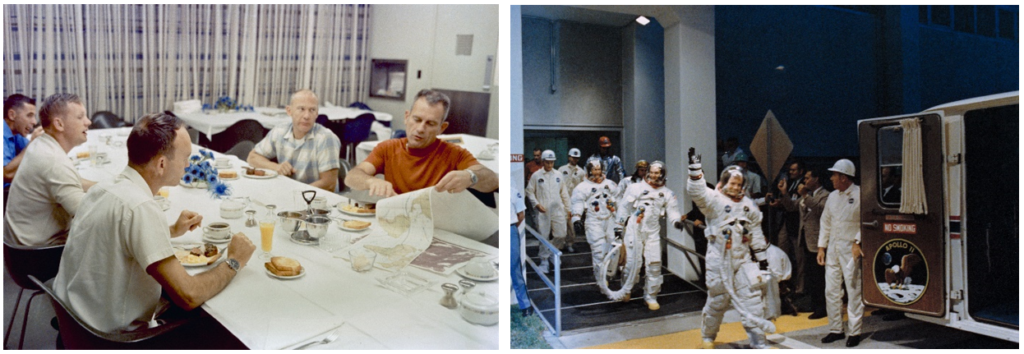 L. The Apollo-11 crew enjoy their traditional pre-flight breakfast; R. Suited and ready for space, the astronauts enter their transfer van for the ride to the launch pad
L. The Apollo-11 crew enjoy their traditional pre-flight breakfast; R. Suited and ready for space, the astronauts enter their transfer van for the ride to the launch pad
When the crew arrived at Pad 39A, the White Room crew chief, Guenter Wendt, greeted them holding a 4ft long "key to the Moon", which he presented to Neil Armstrong. Mr. Armstrong in turn gave Wendt a card reading, “Space Taxi ticket, good between any two planets.”
At three minutes and twenty seconds before launch, the countdown became automated, and over 450 personnel at the consoles in Launch Control Firing Room 1 turned their eyes to watching that very special Saturn-v leave the tower and soar into the sky.
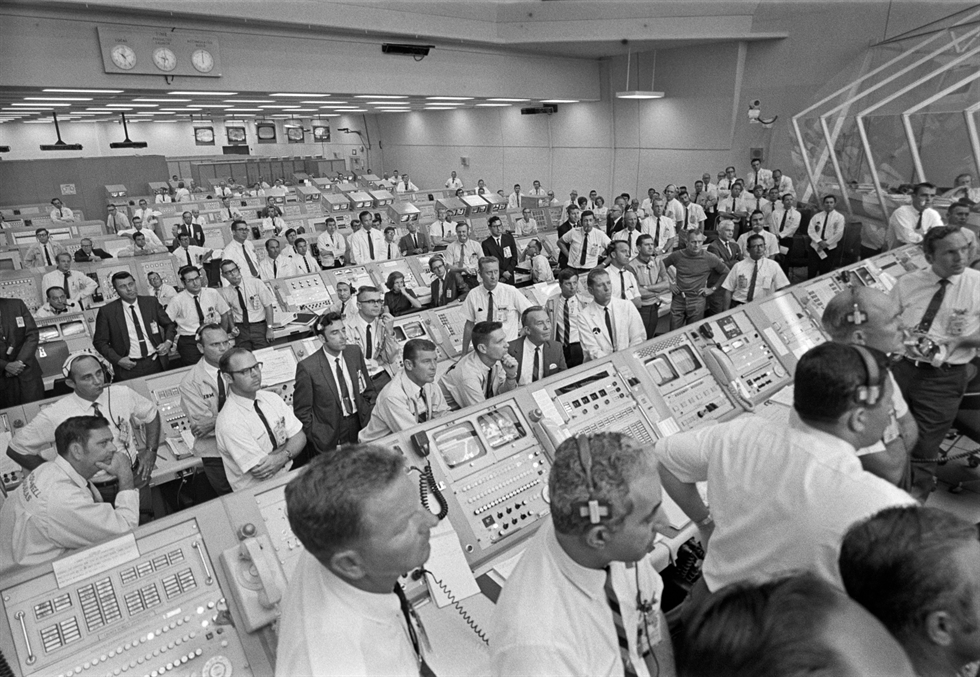
A Million Spectators?
The Cocoa Beach Chamber of Commerce estimated that perhaps one million spectators would gather to watch the launch of Apollo-11 from the highways, beaches and waterways within the vicinity of Kennedy Space Centre. CBS news later reported that the number was closer to 300,000; local motel owners, charging rates as high as $65 a night, were reportedly disappointed. Nevertheless, the essentially uncountable number was still the highest ever to attend a space launch.
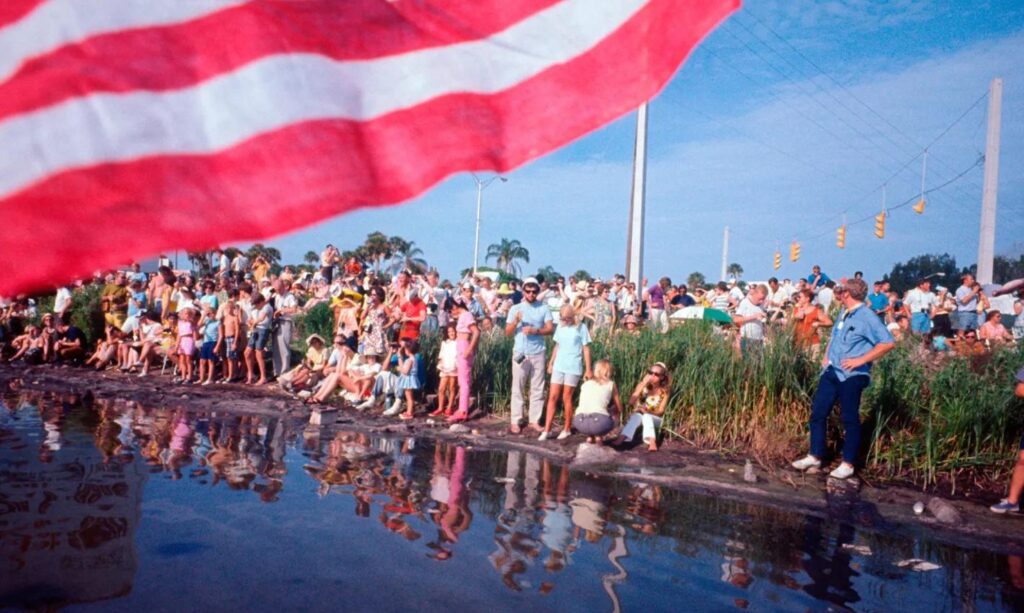 A crowd of spectators in Titusville, near KSC, ready to watch the launch
A crowd of spectators in Titusville, near KSC, ready to watch the launch
These spectators included a group from the American Poor People's Campaign demonstrating against the expenditure on space exploration, when people are going hungry in the United States. The Campaign director, Mr Hosea Williams, said the demonstration included hungry people from five southern States. “We're not against things like the space shot” he said, explaining the reason for their protest. "But there's been a miscalculation in priorities". NASA Administrator Paine agreed to host protesters as spectators at the launch. Awestruck, by the powerful spectacle of the rocket's launch, they prayed for the astronauts, despite protesting the mission itself.
Although President Nixon decided to watch the launch on television in the White House, Vice President Agnew and former president Johnson and his wife were among the VIP guests at the launch site. Other dignitaries at the launch included the Chief of Staff of the United States Army, four members of the Cabinet, 19 state governors, 40 mayors, 60 ambassadors and 200 congressional representatives. There were approximately 3,500 press, radio and television representatives: while the majority were from the United States, 55 other countries were also represented in the media contingent.
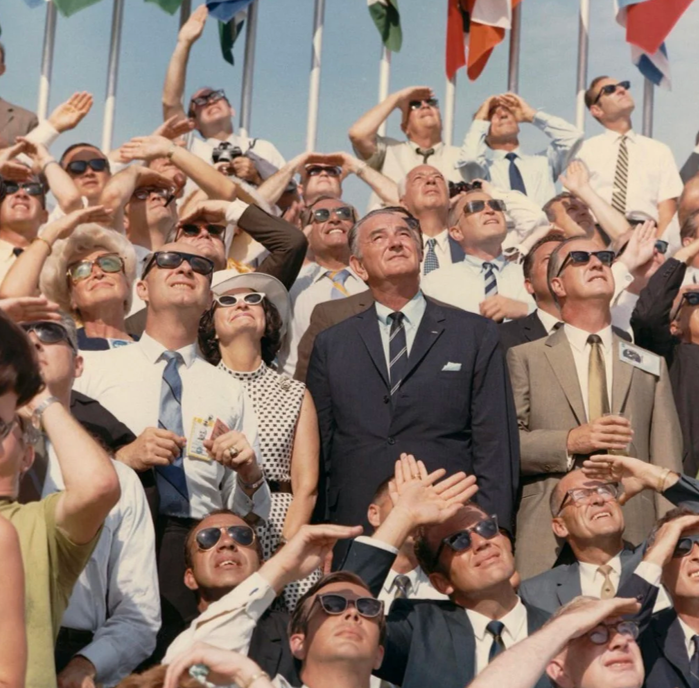 President and Mrs. Johnson, with Vice President Agnew, were among the VIPS watching the launch from Kennedy Space Centre, along with a huge press corps.
President and Mrs. Johnson, with Vice President Agnew, were among the VIPS watching the launch from Kennedy Space Centre, along with a huge press corps.
It is estimated that 25 million people tuned in to watch the launch in the US, while thanks to satellite communications, the lift-off was televised live in 33 countries, including Australia. Millions more around the world listened in to radio broadcasts of the launch.
Despite the late night timeslot of the launch here in Australia (11.32pm), thousands of households around the country stayed up to watch. Like many other parents, my sister and her husband roused their children from bed to join the viewing audience: they even sat their eight-month-old baby on the couch to watch. He may not remember it, but at least in the future he will be able to honestly say that he saw the launch of Apollo-11!
Lift off into History!
At last, on 16 July, at 9.32am EDT, Apollo-11 lifted off into history, rising slowly at first from the launch pad. The three astronauts have reported that they were not aware of the moment of lift-off, but first felt a powerful thrust to their backs, accompanied by a distant rumble, sounding rather like a train. They were thrown left and right against their straps in spasmodic jerks as the 36 storey vehicle adjusted itself to wind effects, to keep on the planned course.
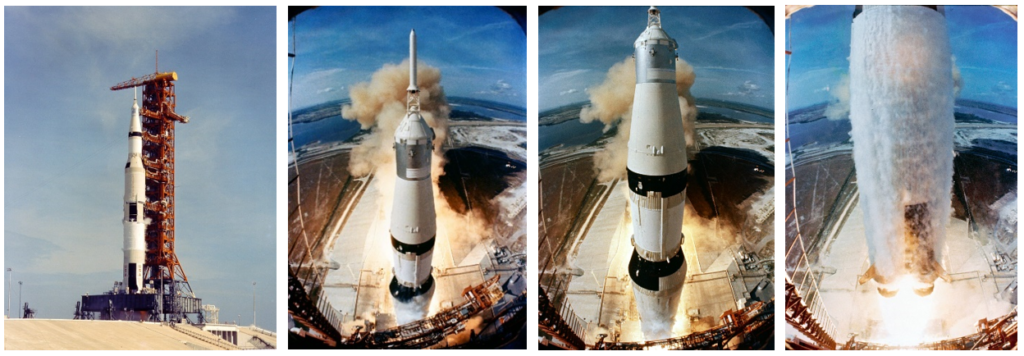
Within forty seconds the Saturn-V was travelling faster than the speed of sound, and the noise in the cabin dropped away. However, Commander Armstrong noted that those first 40 seconds of flight were uncomfortably noisy and rough, much worse than the Gemini Titan launches. He reported that he found it was hard to hear any voices in his earphones, even with his helmet on.
Twelve minutes into the flight, Apollo-11 entered a near-circular Earth orbit. Within 30 minutes, the astronauts were feeling so relaxed that they were playing with the onboard still and movie cameras as they plunged into the night over Tananarive. The powerful FPQ6 radar at the Carnarvon tracking station in Western Australia confirmed that Apollo-11 was in the planned parking orbit, and on the second orbit over Carnarvon, the Capcom at Houston gave the astronauts the “Go!” for the Trans-Lunar Injection (TLI) burn that would send Apollo-11 on the way to the Moon.
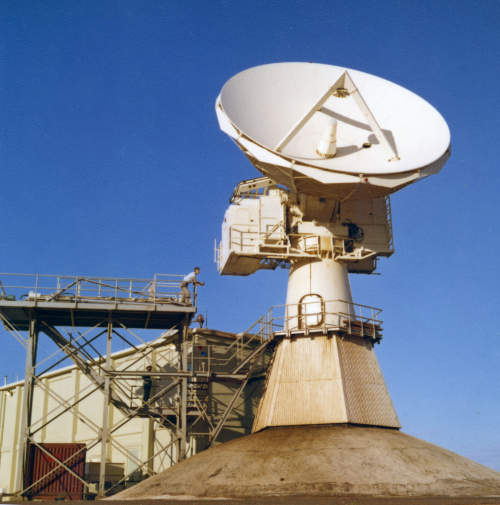 The FPQ6 radar at Carnarvon tracking station that confirmed Apllo-11's initial orbit. This MSFN station also relayed the TLI confirmation to the spacecraft
The FPQ6 radar at Carnarvon tracking station that confirmed Apllo-11's initial orbit. This MSFN station also relayed the TLI confirmation to the spacecraft
On the Way to the Moon
With the Apollo-11 crew now on their way to the Moon, I have no more photos from the mission to share, until they return to Earth with their film canisters hopefully filled with wonderful images from the flight.
To quickly summarise the activities since TLI, about 30 minutes post-TLI, Col. Collins performed the transposition, docking, and extraction manoeuvre, needed to free the LM for the voyage to the Moon. Since leaving Earth orbit, the Apollo-11 crew has quickly settled into routine. After the docking with the LM, they astronauts exchanged their bulky pressure suits for their more comfortable white Teflon jump suits and consumed a lunch of beef and potatoes, butterscotch pudding, and brownies washed down with grape punch.
 The crew's first in-flight meal included beef and potatoes, made possible by the new thermostabilised wet pack container technique that is expanding the range of available meals for Apollo flights
The crew's first in-flight meal included beef and potatoes, made possible by the new thermostabilised wet pack container technique that is expanding the range of available meals for Apollo flights
During that first day in en route for the Moon, the astronauts said that the Moon didn’t seem to be getting bigger, although the Earth was visibly shrinking. At 11 hours and 20 minutes after launch, they settled down for a sleep period, about 2 hours early, made possible by the cancellation of a mid-course correction.
Television Tryout
Just before 23 hours into the flight, the crew’s second day in space began with a wake-up call from Houston. Then, at the 30 hour mark, there was a 50 minute trial television broadcast from the spacecraft using the omni-directional antennae, which was received at the Goldstone tracking station. This impromptu broadcast showed some spectacular colour views of the Earth, I'm told, and provided practice for the crew's first public television broadcast a few hours later. The astronauts also showed themselves “running” in their seats, while asking if the medical team was receiving their heartbeat data. Goldstone reported they could see the astronauts trying to run in their seats, and Capcom Charles Duke in Houston indicated that the medical telemetry was being received.
This marks the point at which I will have to complete this article to send it via telex to the Traveller, so we’ll pick up the second part of story of Apollo-11's great adventure once the mission has returned, hopefully safely and successfully from the Moon.
Just the Beginning
If Apollo-11 achieves all its mission goals, it will be just the first small step in the exploration of our local neighbourhood in space, the true beginning of our road to the stars.
Neil Armstrong, who will soon become the first person to set foot on another world has said “I think we’re going to the Moon because it’s in the nature of the human being to face challenges. It’s by the nature of his deep inner soul…we’re required to do these things just as salmon swim upstream”. I think he’s right!

by Kaye Dee
May has been an exciting month for space exploration, with two Soviet space probes arriving at Venus and Apollo-10 safely returning just days ago from its epic lunar voyage, which has constituted a full-dress rehearsal for the first manned Moon landing. 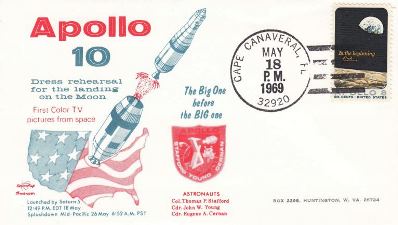 A philatelic cover referring to Apollo-10 as "the Big One before the BIG One"! (Meaning Apollo-11, of course)
A philatelic cover referring to Apollo-10 as "the Big One before the BIG One"! (Meaning Apollo-11, of course)
The Bridesmaid, not the Bride
Before Apollo-10 lifted off on its big mission as NASA’s final test flight ahead of the planned landing of Apollo-11 in July, for a while there was the possibility that the landing attempt might actually be made on this flight, to ensure that American astronauts reached the Moon before any Soviet cosmonauts!  I’m told by my friends at the Honeysuckle Creek Tracking Station, that there was considerable discussion within NASA about accelerating the lunar landing programme. As early as February, even before the launch of Apollo-9, there were suggestions that, if the Earth orbit test of the Lunar Module (LM) was successful, Apollo-10 might go for the first manned lunar landing. George Mueller, Head of NASA’s Office of Manned Space Flight (left), supported this approach. He may not look it, but Dr. Mueller has been described as someone who “always shoots from both hips”, and he strongly pushed for the Apollo-10 landing scenario.
I’m told by my friends at the Honeysuckle Creek Tracking Station, that there was considerable discussion within NASA about accelerating the lunar landing programme. As early as February, even before the launch of Apollo-9, there were suggestions that, if the Earth orbit test of the Lunar Module (LM) was successful, Apollo-10 might go for the first manned lunar landing. George Mueller, Head of NASA’s Office of Manned Space Flight (left), supported this approach. He may not look it, but Dr. Mueller has been described as someone who “always shoots from both hips”, and he strongly pushed for the Apollo-10 landing scenario.
However, a dress rehearsal mission had been planned since June 1967, and the consensus was that the programme was not quite ready to safely achieve a landing with Apollo-10, with more work needed on different docking techniques, as well as more experience with communications and tracking capabilities at lunar distances.
There were concerns that not enough is known about the effect on planned lunar orbit manoeuvres of the Mascons (gravity peaks caused by heavy material under the lunar surface) discovered by Apollo-8. In addition, the lunar landing computer software wasn’t quite ready, and the LM allocated to the Apollo-10 mission was one that had been planned for use in an Earth orbit flight test. Since it was heavier than a LM intended for a lunar landing, its greater weight might have caused problems lifting off the lunar surface. 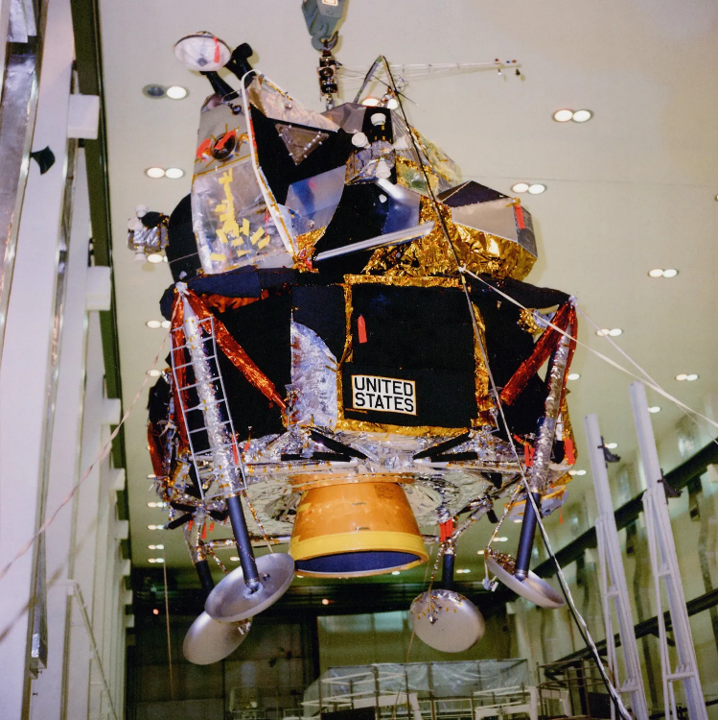 LM-4 being prepared for the Apollo-10 mission at Kennedy Space Centre
LM-4 being prepared for the Apollo-10 mission at Kennedy Space Centre
Thus, on 26 March, with the Saturn-V for its mission already on the launchpad, senior NASA officials finally announced that Apollo-10 would remain the bridesmaid and not become the bride, performing the final full-dress rehearsal for a Moon landing with Apollo-11, rather than itself attempting the historic first lunar touchdown. “With the exception of the actual landing of the Lunar Module on the lunar surface, the mission planned is the same as for the [Apollo-11] lunar mission”, NASA’s announcement of the decision said. 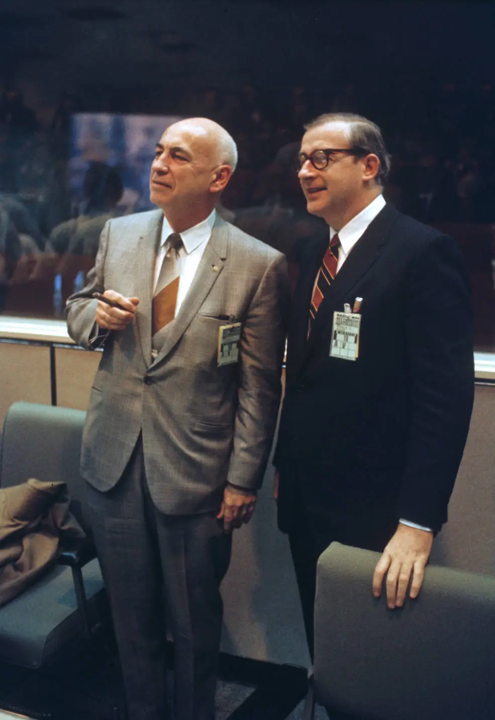 Dr. Paine (right) with Mr. Robert Gilruth, Director of the Manned Spacecraft Centre, celebrating the safe return of Apollo-10
Dr. Paine (right) with Mr. Robert Gilruth, Director of the Manned Spacecraft Centre, celebrating the safe return of Apollo-10
Perhaps Dr. Thomas O. Paine, only confirmed as NASA's third Administrator on 20 March – and a Democrat in the Republican Nixon Administration, which has yet to demonstrate strong enthusiasm for continuing the spaceflight programme of the previous Administration – preferred to err on the side of caution, rather than take another bold gamble like Apollo-8 at such a late stage in the Moon landing programme.
Seasoned Crew
Whether Apollo-10 remained the lunar landing dress rehearsal, or if it had become the first mission to land on the Moon, its crew were well-qualified for either mission scenario, as seasoned veterans of Gemini spaceflights.  Mission Commander Colonel Thomas Stafford previously flew as Pilot of the Gemini-VI mission, and then as Commander of Gemini-IX. On the latter flight, his Pilot was Commander Eugene “Gene” Cernan, assigned as LM Pilot for Apollo-10. The third member of the Apollo-10 crew, Command Module (CM) Pilot Commander John Young, made his first spaceflight as Pilot of Gemini-III, before becoming Commander of Gemini-X. I think NASA would have been hard-pressed to assemble a more experienced crew for this crucial flight.
Mission Commander Colonel Thomas Stafford previously flew as Pilot of the Gemini-VI mission, and then as Commander of Gemini-IX. On the latter flight, his Pilot was Commander Eugene “Gene” Cernan, assigned as LM Pilot for Apollo-10. The third member of the Apollo-10 crew, Command Module (CM) Pilot Commander John Young, made his first spaceflight as Pilot of Gemini-III, before becoming Commander of Gemini-X. I think NASA would have been hard-pressed to assemble a more experienced crew for this crucial flight.
A Mission Patch with Mission Heritage
North American Rockwell artist Allen Stevens, who has previously collaborated with the crews to design the mission patches for Apollo-1 , 7, and 9, apparently wanted to break away from the circular shape used for so many previous missions. He initially offered the Apollo-10 crew some concepts based on polygonal patch shapes, but these did not appeal. 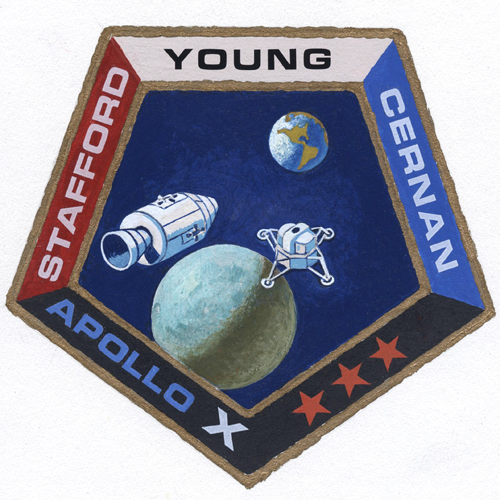
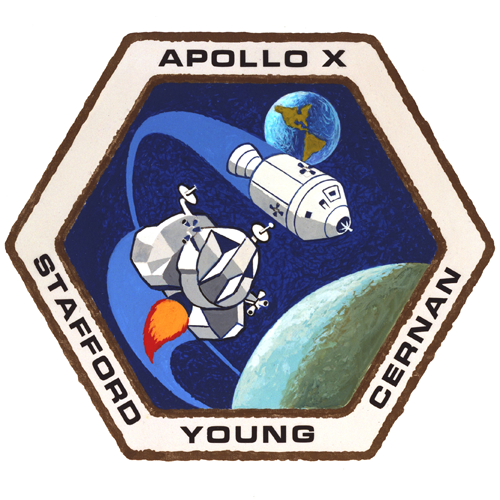 Instead, US Navy officers Cernan and Young primarily developed the patch, which Stevens then illustrated. Their concept drew heavily on the design of Stafford and Cernan’s Gemini-IX mission patch, especially using the shape of a shield.
Instead, US Navy officers Cernan and Young primarily developed the patch, which Stevens then illustrated. Their concept drew heavily on the design of Stafford and Cernan’s Gemini-IX mission patch, especially using the shape of a shield. 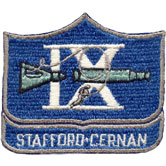
Astronaut Cernan has said that the mission patch was based on the mechanics and goals of the mission, and this is exemplified in the dominance of the spacecraft and the mission number represented by a large Roman numeral in the middle of the design.  The final version of the Apollo-10 patch depicts the CM circling the Moon as the LM makes its low pass over the surface, with the Earth in the background. The three-dimensional rendering of the Roman ‘X’ gives the impression that it is sitting on the Moon, its prominence in the illustration indicating the mission’s significance in furthering the Apollo programme. The crew names appear around the rim of the shield.
The final version of the Apollo-10 patch depicts the CM circling the Moon as the LM makes its low pass over the surface, with the Earth in the background. The three-dimensional rendering of the Roman ‘X’ gives the impression that it is sitting on the Moon, its prominence in the illustration indicating the mission’s significance in furthering the Apollo programme. The crew names appear around the rim of the shield.
A Mascot Namesake
With two spacecraft operating independently around the Moon, the CM and LM would need their own individual callsigns, as was the case with Apollo-9. For their historic mission, the Apollo-10 crew looked to the popular “Peanuts” comic strip, injecting a light-hearted note into a critical mission by designating the Command Module “Charlie Brown” and the Lunar Module “Snoopy”. It seems that NASA executives were once again unhappy with the crew’s choice of names, being particularly concerned about the perception of the hapless Charlie Brown as a born loser. 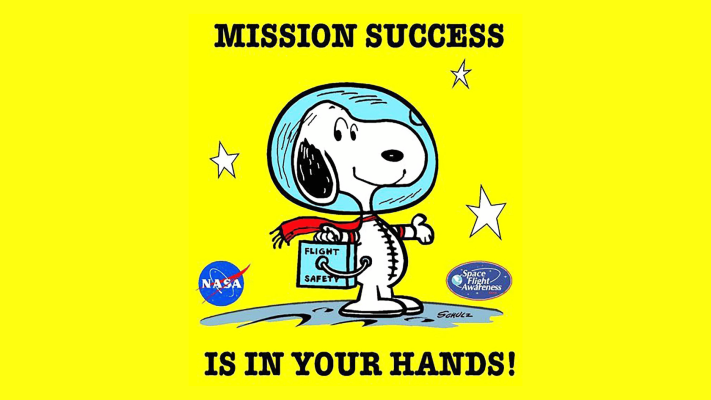 But the two characters, particularly Snoopy, have been associated with spaceflight since last year, when the lovable beagle was adopted as the mascot for NASA’s Manned Spaceflight Awareness programme. This safety campaign, begun in 1963, focuses on encouraging the workforce constructing spacecraft and equipment for NASA to remember that astronaut lives, and mission success, depend upon the quality and reliability of their work: a message that has taken on new meaning and urgency following the Apollo-1 fire. Snoopy, with his daring imaginary adventures (as a World War 1 flying ace, Olympic skater and other action roles), seemed an ideal choice for a mascot to raise morale and increase visibility for the renewed effort.
But the two characters, particularly Snoopy, have been associated with spaceflight since last year, when the lovable beagle was adopted as the mascot for NASA’s Manned Spaceflight Awareness programme. This safety campaign, begun in 1963, focuses on encouraging the workforce constructing spacecraft and equipment for NASA to remember that astronaut lives, and mission success, depend upon the quality and reliability of their work: a message that has taken on new meaning and urgency following the Apollo-1 fire. Snoopy, with his daring imaginary adventures (as a World War 1 flying ace, Olympic skater and other action roles), seemed an ideal choice for a mascot to raise morale and increase visibility for the renewed effort.
In 1968, with the permission and participation of “Peanuts” creator Charles Schultz, Snoopy became not only the mascot for this programme, but the symbol of its special achievement award, the “Silver Snoopy”. The award recognises individuals within the NASA workforce and contractors who have made valuable contributions to safety and mission assurance. Recipients receive a silver lapel pin which depicts a spacesuited Snoopy doing his famous “happy dance”. 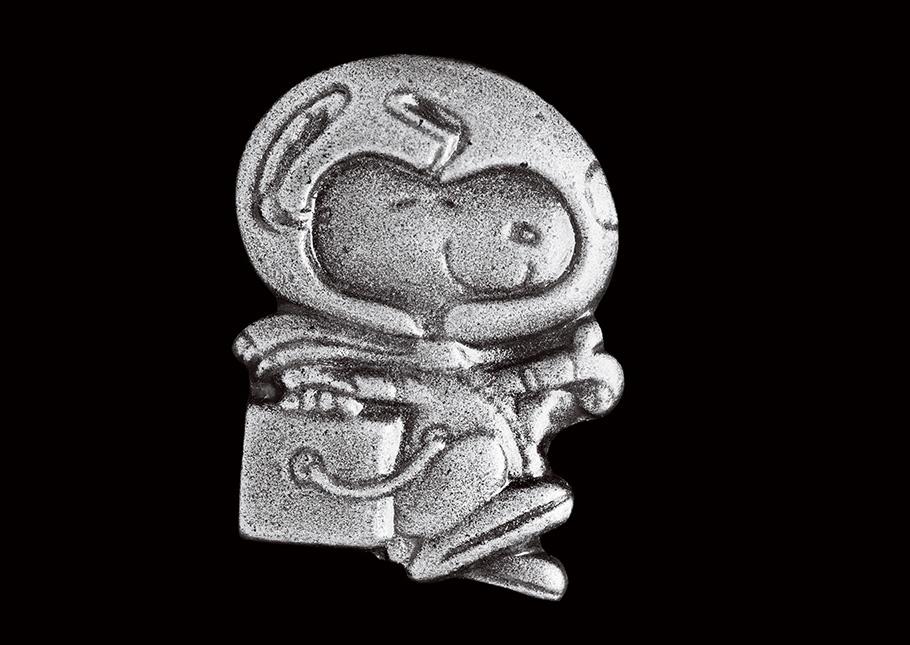 A batch of Silver Snoopy pins was carried to the Moon on Apollo-8, and each award pin is presented to its recipient by an astronaut. As a person can only be honoured once with a Silver Snoopy award, it has already become a highly-coveted form of recognition.
A batch of Silver Snoopy pins was carried to the Moon on Apollo-8, and each award pin is presented to its recipient by an astronaut. As a person can only be honoured once with a Silver Snoopy award, it has already become a highly-coveted form of recognition.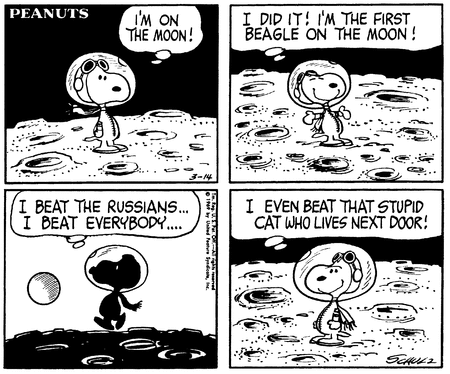 Snoopy-ing Around
Snoopy-ing Around
In March this year, Snoopy beat the Apollo-11 crew to a Moon landing in his comic strip fantasies, but he and Charlie Brown are turning up in many guises across the space agency, frequently featuring on motivational posters. 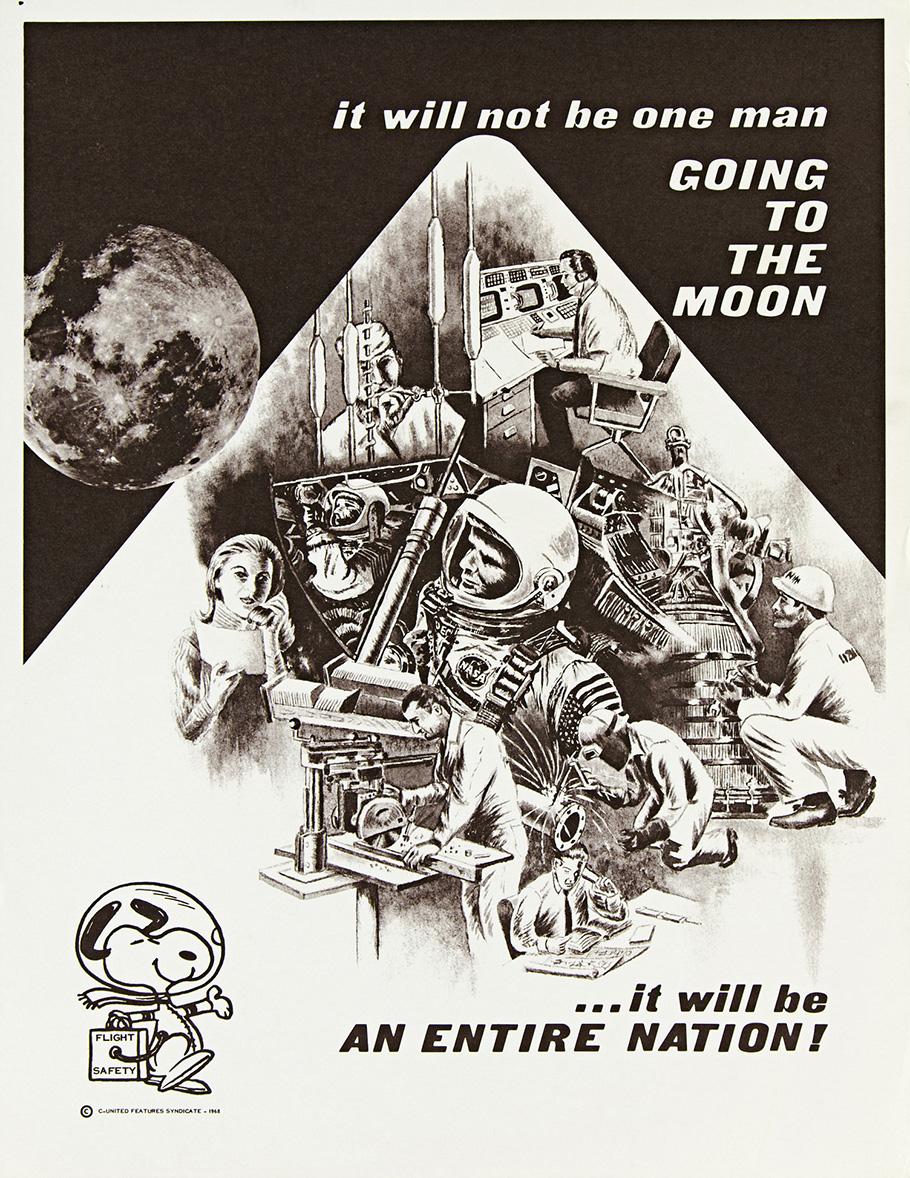
 Small models of the boy and his dauntless dog are found in the Apollo spacecraft simulator area, where the astronauts spend much of their time in training. The astronauts have also taken to calling their communications headgear “Snoopy caps”, because of their resemblance to the flying helmet Snoopy wears in his daydreams of battling the Red Baron. The black-and-white design of the caps also recalls Snoopy's white head and black ears. Toy models of Charlie Brown and astronaut Snoopy also graced the consoles in Mission Control while Apollo-10 was in flight.
Small models of the boy and his dauntless dog are found in the Apollo spacecraft simulator area, where the astronauts spend much of their time in training. The astronauts have also taken to calling their communications headgear “Snoopy caps”, because of their resemblance to the flying helmet Snoopy wears in his daydreams of battling the Red Baron. The black-and-white design of the caps also recalls Snoopy's white head and black ears. Toy models of Charlie Brown and astronaut Snoopy also graced the consoles in Mission Control while Apollo-10 was in flight. 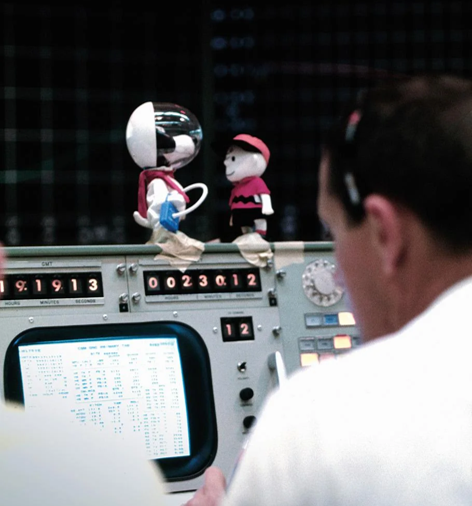 In an interview in April, Col. Stafford explained why the astronauts adopted the Snoopy and Charlie Brown callsigns. “Since we're going to the Moon to find all these facts and kind of snoop around, we decided that the Lunar Module is going to be called Snoopy. Snoopy is a comic character that’s a favourite, I know, of many people in the United States and around the world, and to go with it, we'll call the Command Module Charlie Brown”. In the same interview Commander Cernan also referenced the Silver Snoopy as a reason for the name choice, saying “Snoopy is a sort of champion of the space programme, anyway”.
In an interview in April, Col. Stafford explained why the astronauts adopted the Snoopy and Charlie Brown callsigns. “Since we're going to the Moon to find all these facts and kind of snoop around, we decided that the Lunar Module is going to be called Snoopy. Snoopy is a comic character that’s a favourite, I know, of many people in the United States and around the world, and to go with it, we'll call the Command Module Charlie Brown”. In the same interview Commander Cernan also referenced the Silver Snoopy as a reason for the name choice, saying “Snoopy is a sort of champion of the space programme, anyway”. 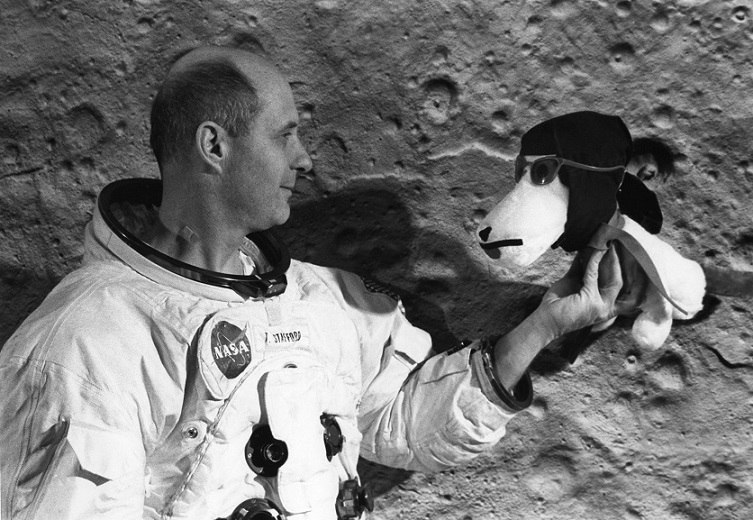
Getting Ready
Despite not landing on the Moon, Apollo-10 was still going to be a big mission, with its flight plan closely following that of Apollo-11. To enable detailed photography of the designated Apollo-11 landing site at the Sun angle planned for the July mission, the launch was postponed from 16 to 17 May. In March, it was delayed again to 18 May, to allow for a better view of the backup landing site. An extra day in lunar orbit was also added to the mission to provide time for additional testing of the LM’s systems and photography of possible future Apollo landing sites. 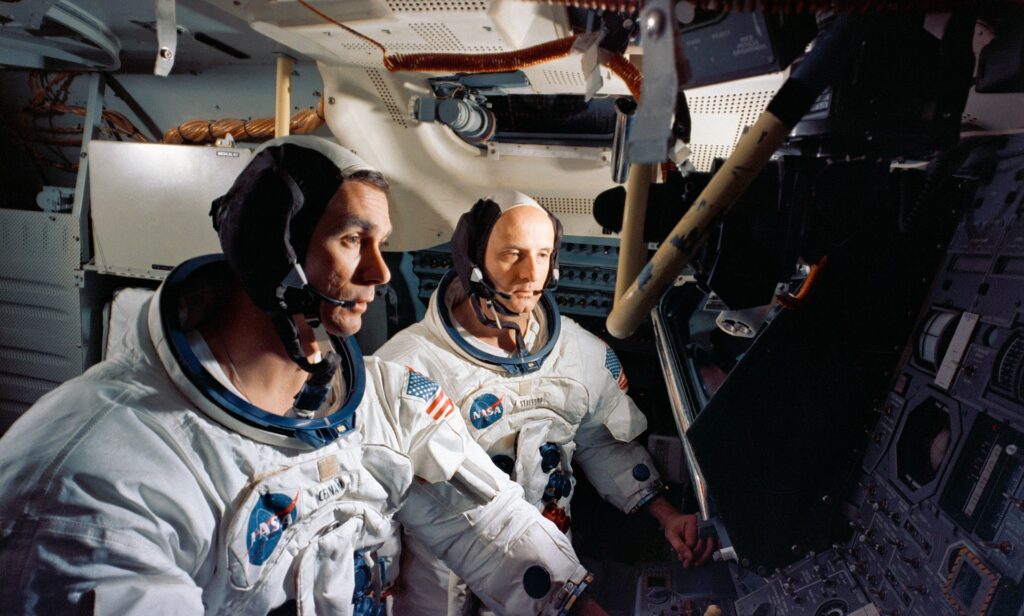 Col. Stafford and Commander Cernan training for their flight in the LM simulator
Col. Stafford and Commander Cernan training for their flight in the LM simulator
The Apollo-10 crew’s intensive mission training schedule saw them putting in five hours of formal training for every hour of their mission’s eight-day duration. This included more than 300 hours each in the CM or LM simulators, and centrifuge training to prepare for the high-acceleration conditions they would endure during re-entry.
An accidental fuel spillage from the first stage of the Saturn V at the end of April fortunately caused no damage, and countdown preparations went ahead as planned, with no major delays. On 14 May, the astronauts received their final lunar topography briefing from scientist-astronaut, geologist Dr. Harrison Schmidt, and were pronounced fit and ready for lunar flight in their final medical checks. Everything was ready for the full-dress rehearsal of a manned lunar landing! 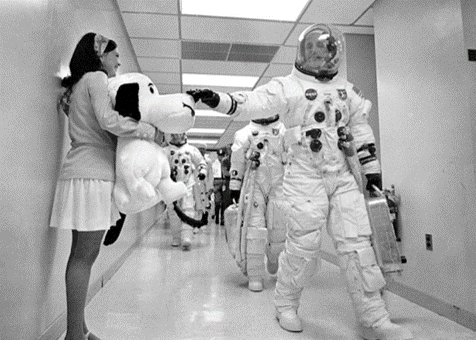 Mission Commander Stafford pats a giant Snoopy plush toy for luck, as the crew walk out to the Astronaut Transfer Van. Snoopy is being held by Cernan's secretary, Jamye Flowers
Mission Commander Stafford pats a giant Snoopy plush toy for luck, as the crew walk out to the Astronaut Transfer Van. Snoopy is being held by Cernan's secretary, Jamye Flowers
Lift Off!
Due to mission scheduling requirements, Apollo-10 was slated to lift off from Launch Complex 39B at Kennedy Space Centre, the first Apollo mission to use that pad. (LC 39A, used for Apollo-8 and 9 is being used for Apollo-11, whose Saturn V vehicle was rolled out to the pad just a few days before the Apollo-10 launch). Firing Room 3, at Kennedy Space Centre’s Launch Control Centre was also used for the first time on Apollo-10’s launch. Mission Director of Flight Crew Operations Deke Slayton and other NASA officials in Firing Room-3 during Apollo 10's pre-flight preparations
Mission Director of Flight Crew Operations Deke Slayton and other NASA officials in Firing Room-3 during Apollo 10's pre-flight preparations
Apollo-10 lifted off exactly on time at 16.49 GMT on 18 May. Although pogo effects gave the astronauts something of a rough ride into orbit, this fortunately had no impact on the mission. However, during Trans-Lunar Injection (TLI) burn, shuddering vibrations caused by the S-IVB stage pressure relief valves blurred the astronauts’ vision, to the point that they feared that the mission might have to be aborted. Fortunately, after five minutes the burn ended satisfactorily, with Apollo-10 safely on the way to the Moon.
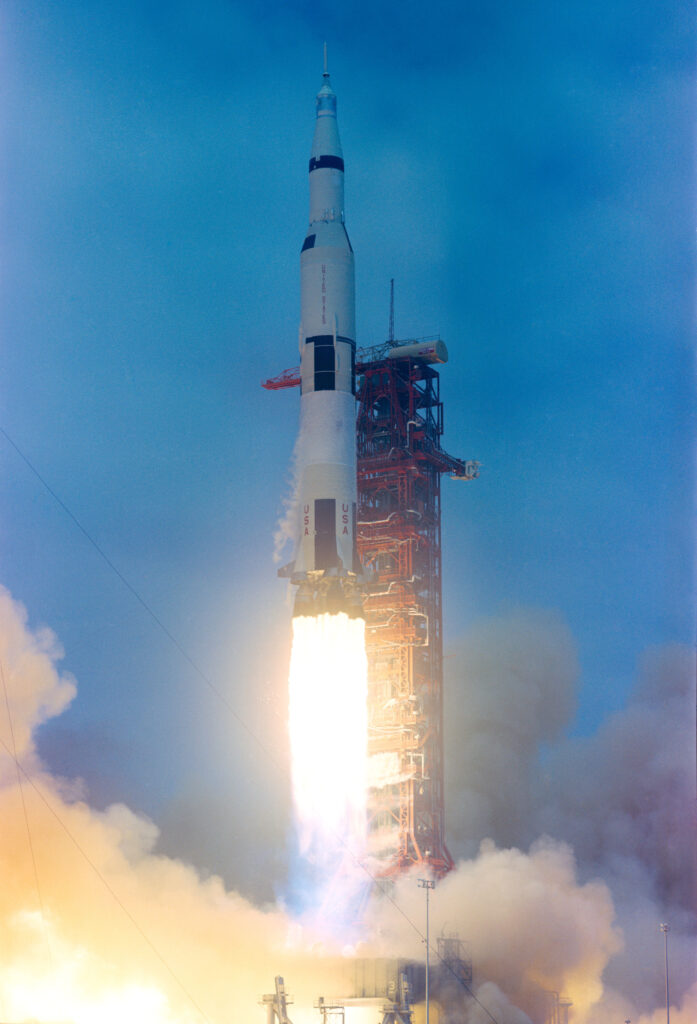
The TLI burn occurred about 100 miles above outback Queensland, witnessed on the ground by thousands of people thanks to perfect observing conditions. A local official in the town of Cloncurry gave an interview to NBC News, which I understand was broadcast live in the US, describing what they saw: “The veil surrounding the relatively large white spot of the rocket’s rear end could best be described as resembling a mercury vapor street light seen through thick fog, although it was of a tenuous nature.”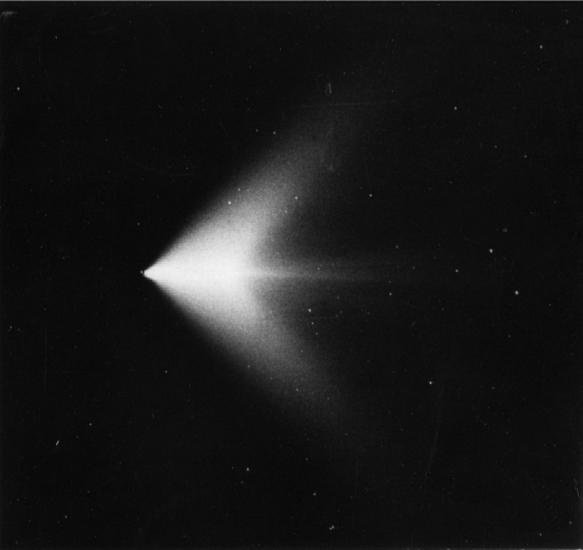 I've not yet seen a picture of the Apollo TLI burn from Queensland, but this photo of the Apollo-8 TLI burn above Hawaii will give some idea of the amazing sight seen by many in remote Queensland towns
I've not yet seen a picture of the Apollo TLI burn from Queensland, but this photo of the Apollo-8 TLI burn above Hawaii will give some idea of the amazing sight seen by many in remote Queensland towns
Coming to You in Living Colour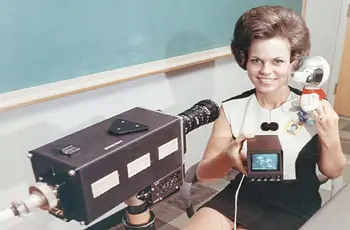 The Apollo-10 Westinghouse colour television camera and its custom-made viewing monitor for onboard use in the CM
The Apollo-10 Westinghouse colour television camera and its custom-made viewing monitor for onboard use in the CM
Apollo 10 has seen the first use of a compact colour television camera, developed by Westinghouse. Installed in the CM, the camera was first used to show mission controllers in Houston the complex transposition, docking, and extraction manoeuvre performed by CM Pilot John Young, to extract the LM from the S-IVB stage, attaching it to the nose of the Command Module for the journey to the Moon. 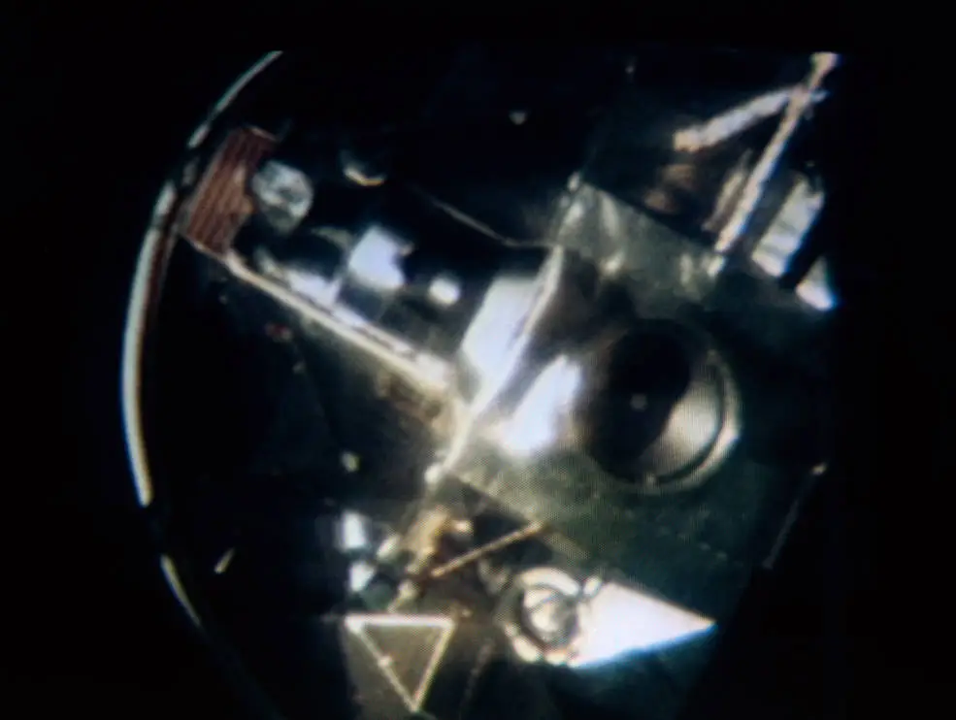 Soon after the special LM extraction transmission, the first public broadcast on the way to the Moon treated the audience to live colour vistas of the Earth from 25,000 miles away in a thirteen-minute show.
Soon after the special LM extraction transmission, the first public broadcast on the way to the Moon treated the audience to live colour vistas of the Earth from 25,000 miles away in a thirteen-minute show. 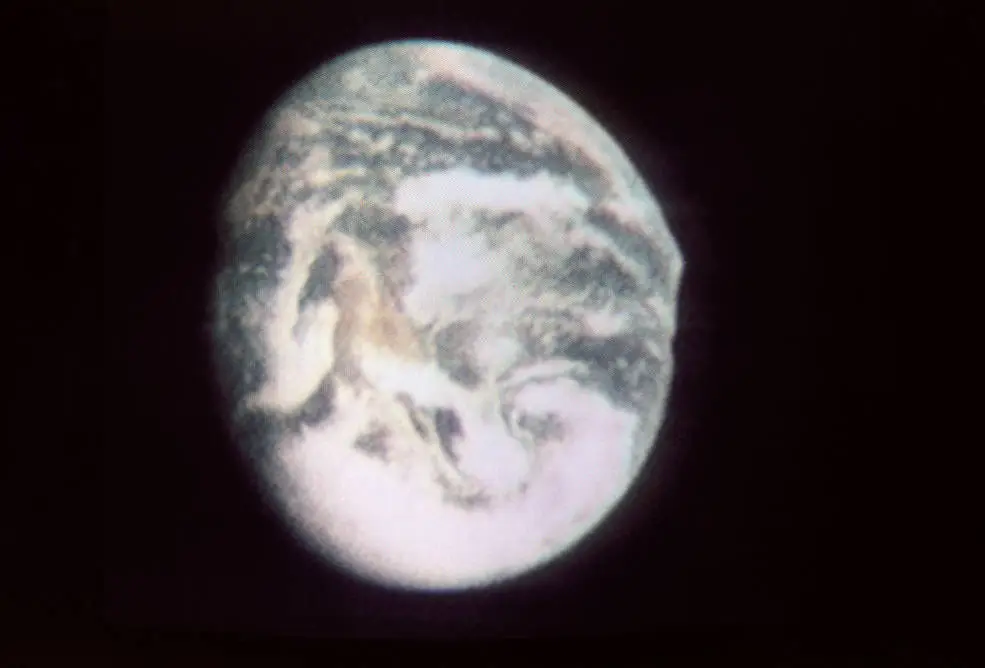
This was followed, before the crew's first sleep period, with a 24-minute TV transmission, that began with views from 36,300 nautical miles in space, showing the Earth floating in the black void of the cosmos. The scene moved LM Pilot Cernan to say: "It's just sitting out there in the middle of nowhere. It's unbelievable…it's just incredible".
The camera was then turned inside the the CM showing the astronauts themselves. Capcom Bruce McCandless commented, “It’s really great. The colours are fantastic.”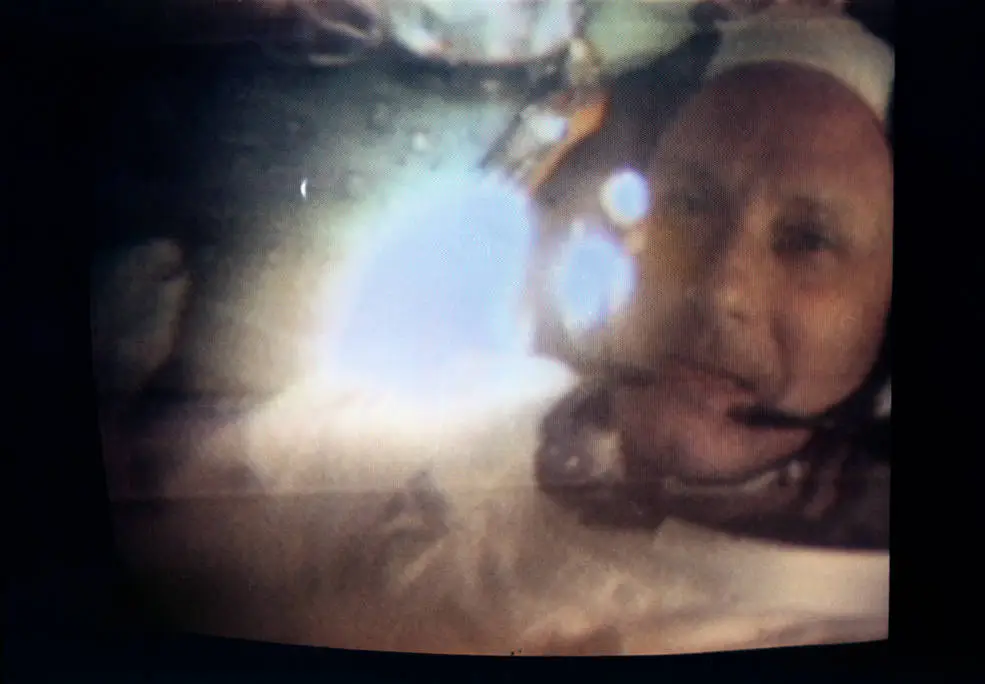
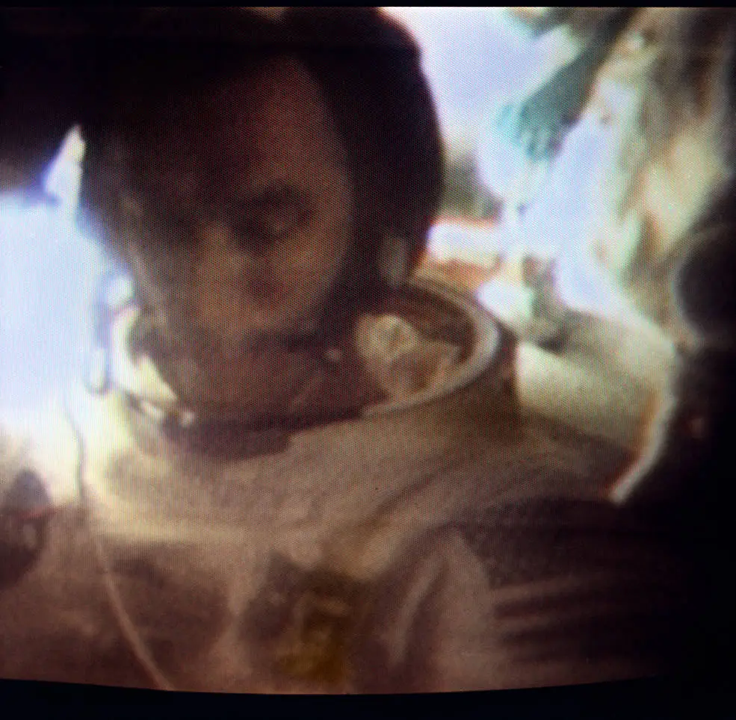
 Images of the Apollo-10 crew captured during one of the broadcasts from the CM. Stafford (top), Cernan (middle), Young (bottom)
Images of the Apollo-10 crew captured during one of the broadcasts from the CM. Stafford (top), Cernan (middle), Young (bottom)
The Apollo-10 crew must have thought their colour camera was a great new toy, as they treated Earth audiences to nineteen colour television transmissions, totalling 5 hours 52 minutes across the entire mission. In one of the early broadcasts, the crew displayed colour illustrations of Charlie Brown and Snoopy, produced by a NASA illustrator, which I understand were intended as colour calibration checks. 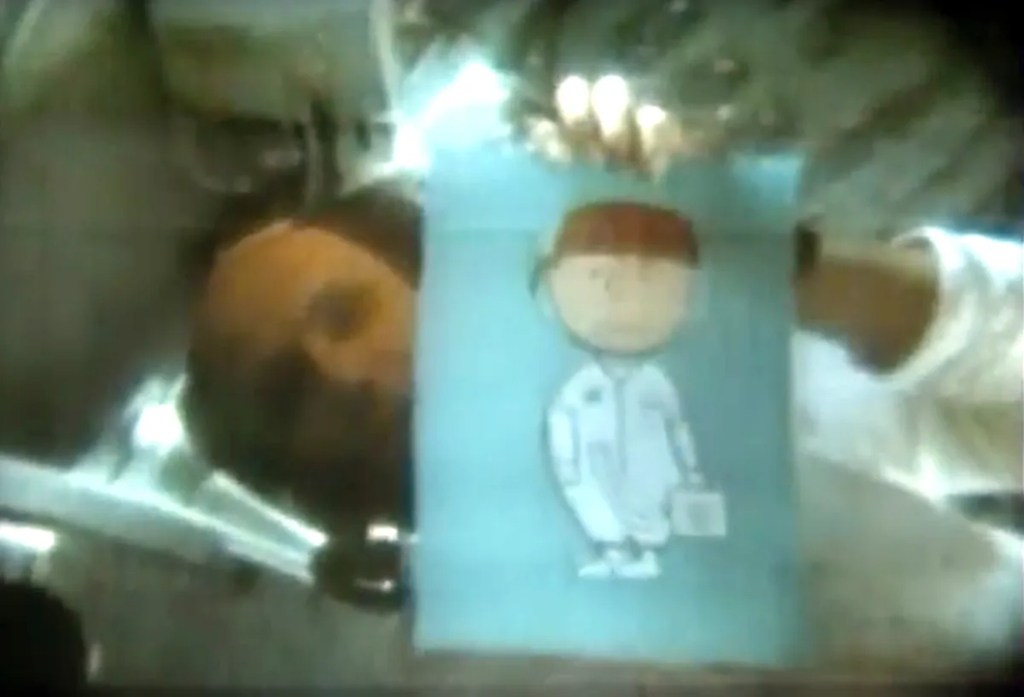

During another broadcast on the way to the Moon, Astronauts Stafford and Young were shown side by side, with Young upside down to demonstrate the weightless environment. Col. Stafford, using just a light touch, moved his CM pilot up and down, as Young joked “I do everything he tells me.”
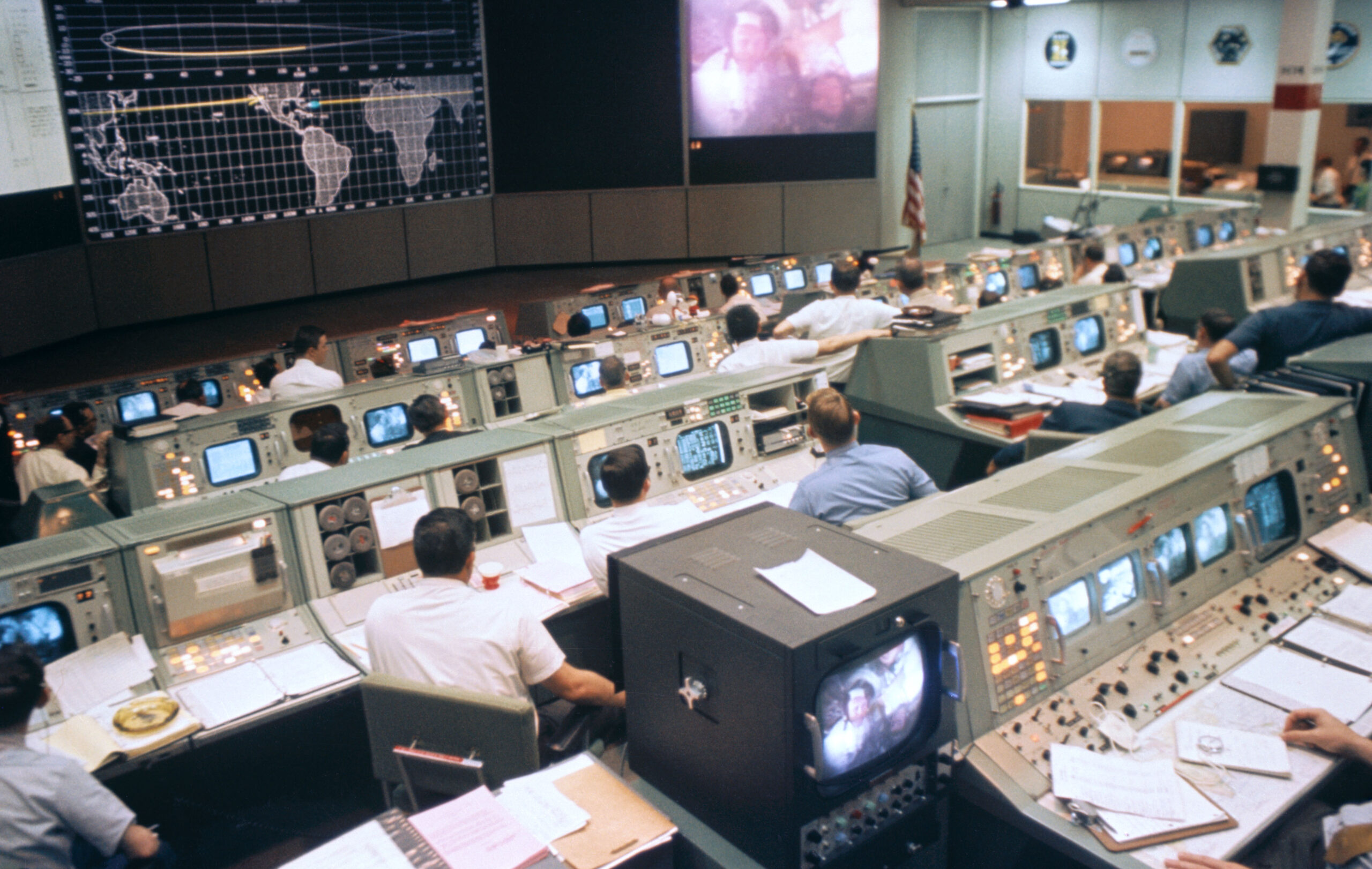 Monitors in Mission Control show the Stafford-Young broadcast from the CM demonstrating the weightless environment
Monitors in Mission Control show the Stafford-Young broadcast from the CM demonstrating the weightless environment
The first broadcast after Trans-Earth Injection was initially received in Australia and distributed to the local television networks (albeit in black and white, since we don't yet have colour television), prior to transmission back to the United States and on to the rest of the world. This functioned as a test for the systems that have been put in place to handle Australia's potential role as the prime receiver for Apollo-11's lunar surface transmissions.
Amusingly, the normally laconic Cernan and Stafford gushed like schoolboys on an outing, clearly excited to be floating in weightlessness, on their way to the Moon. Speaking of which, it was just shortly before this flight that NASA determined what was causing some astronauts to get "space sick" during missions. It wasn't a cold or food-related; it was weightlessness, itself, affecting the inner ear adversely.
Eating Out
Food for the astronauts is being continually improved, and new items were added to the menu on this mission, such as small sandwiches with real bread, and ham, chicken and tuna salad. I've heard that this expanded menu was a real boost to the crew's morale as they travelled to the Moon – although looking at pictures of some space foods, I'm not so sure that they are appetising, even if they are nutritious. 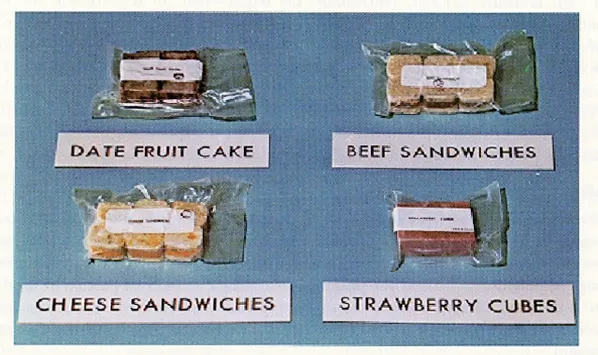
(above) Some of the new menu items available to the Apollo-10 crew. (below) I'm not so sure about the new dehydrated chicken salad! 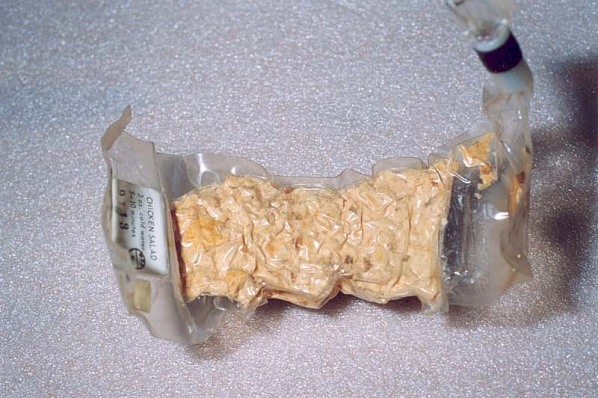
Another innovation for Apollo-10 has been the introduction of the "wet pack" or "spoon bowl" packaging, allowing the astronauts to eat many meals with a spoon! To reduce the risk of food floating away and becoming a nuisance and potential hazard to electronic equipment, the spoon-eatable wet pack food is mixed with just enough water to make it sticky, so that it clings to the inside of the container and sticks on the spoon.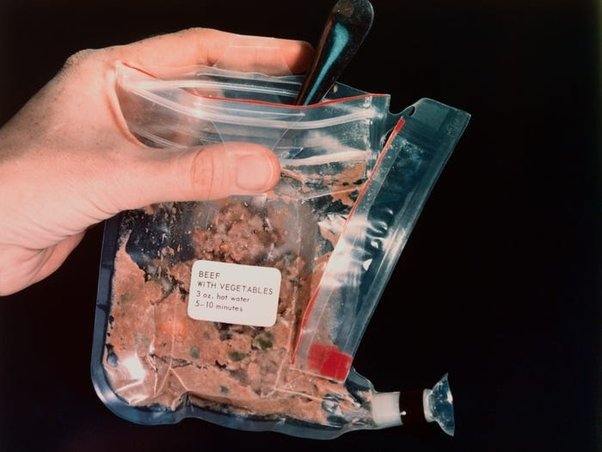 (above) A spoon-bowl container with a beef and vegetable meal. It looks a lot more enjoyable to eat than that chicken salad
(above) A spoon-bowl container with a beef and vegetable meal. It looks a lot more enjoyable to eat than that chicken salad
Unfortunately, some food on Apollo-10 was not so morale-boosting, as Col. Stafford apparently put too much chlorine in the drinking water used to rehydrate the meals, making the dehydrated foods taste strange.
Cruising Along
The astronauts had a relatively light workload on the way to the Moon, with only one slight course correction to place Apollo-10 on the trajectory Apollo-11 is expected to take. The only real problem they encountered was that the mylar cover of the CM’s hatch pulled loose, spreading shreds of fibreglass insulation into the docking tunnel, CM and LM. 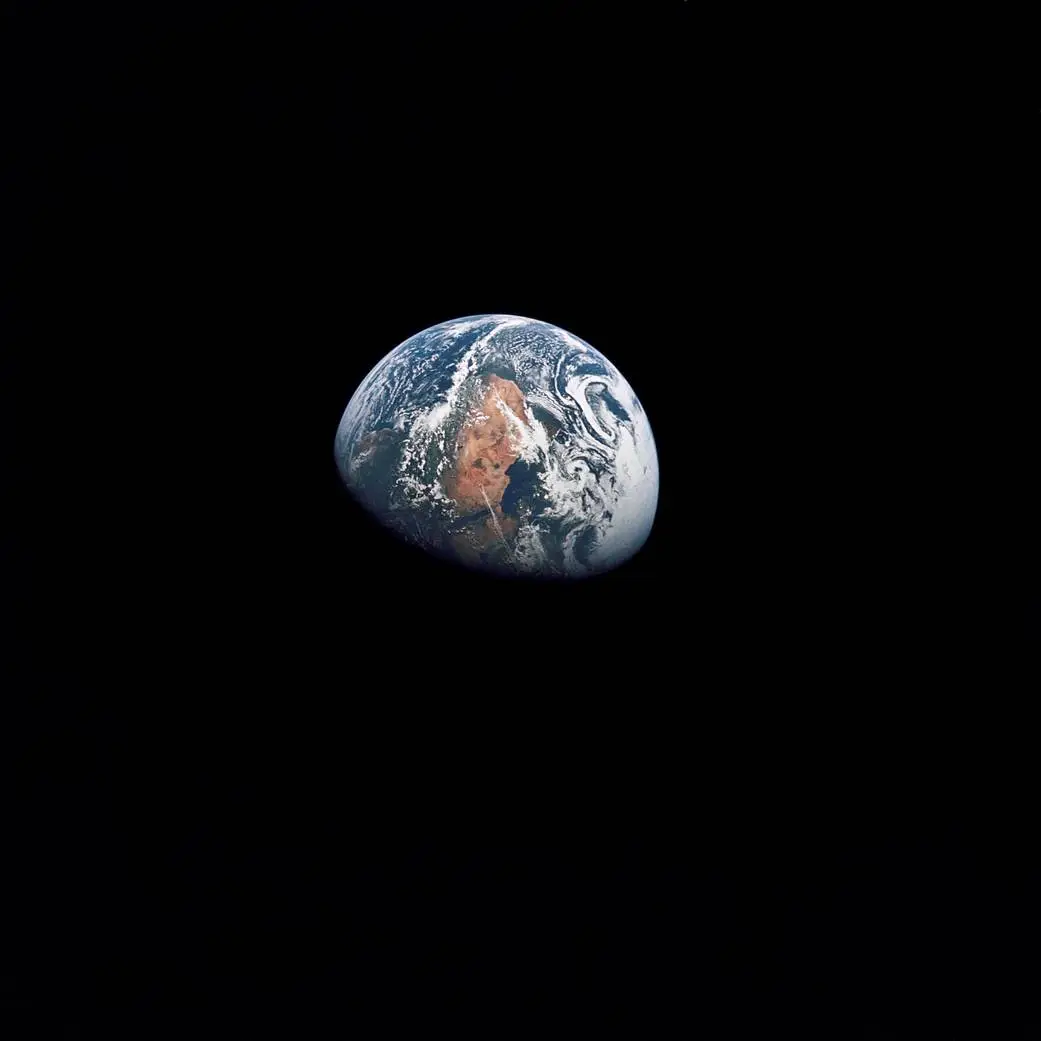 Photograph of the Earth from 100,000 miles, showing parts of Africa, Europe and the Middle East
Photograph of the Earth from 100,000 miles, showing parts of Africa, Europe and the Middle East
About 62 hours after launch, Apollo-10 crossed into the Moon’s gravitational sphere of influence, passing about 10 hours later into the darkness of the lunar shadow. Just on 76 hours into the mission, Apollo-10 passed behind the Moon, with the Lunar Orbit Insertion burn occurring out of radio contact with the Earth. Fortunately, this manoeuvre experienced no issues and Apollo-10, now safely in lunar orbit, emerged from the behind the Moon to begin the real work of the mission. “You can tell the world that we have arrived,” Col. Stafford announced.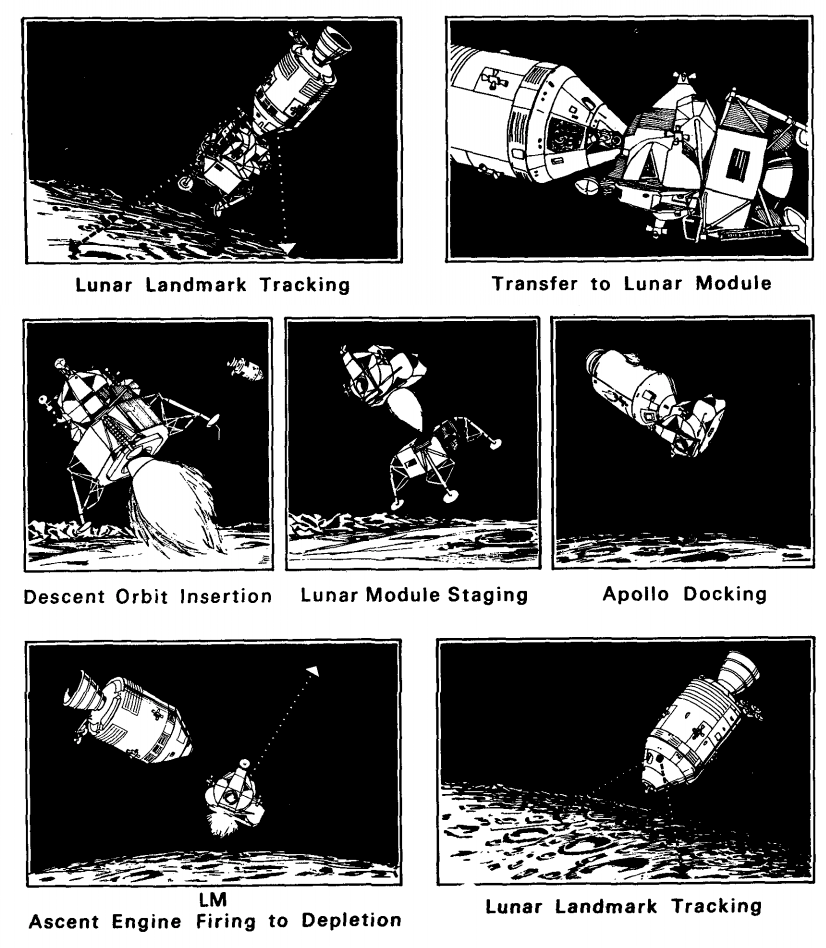 The Real Work Begins
The Real Work Begins
Almost as soon as they were back in contact with the Earth, the crew began describing the lunar terrain they were flying over, with Commander Cernan saying, “It might sound corny, but the view is really out of this world.” Within the first couple of hours at the Moon, after circularising their orbit at approximately 60 nautical miles above the Moon, the crew began planned observations of lunar surface landmarks. This included photographing three of the proposed Apollo-11 landing sites (which the astronauts would also photograph at a lower altitude from LM Snoopy), as well as many craters and other surface features. 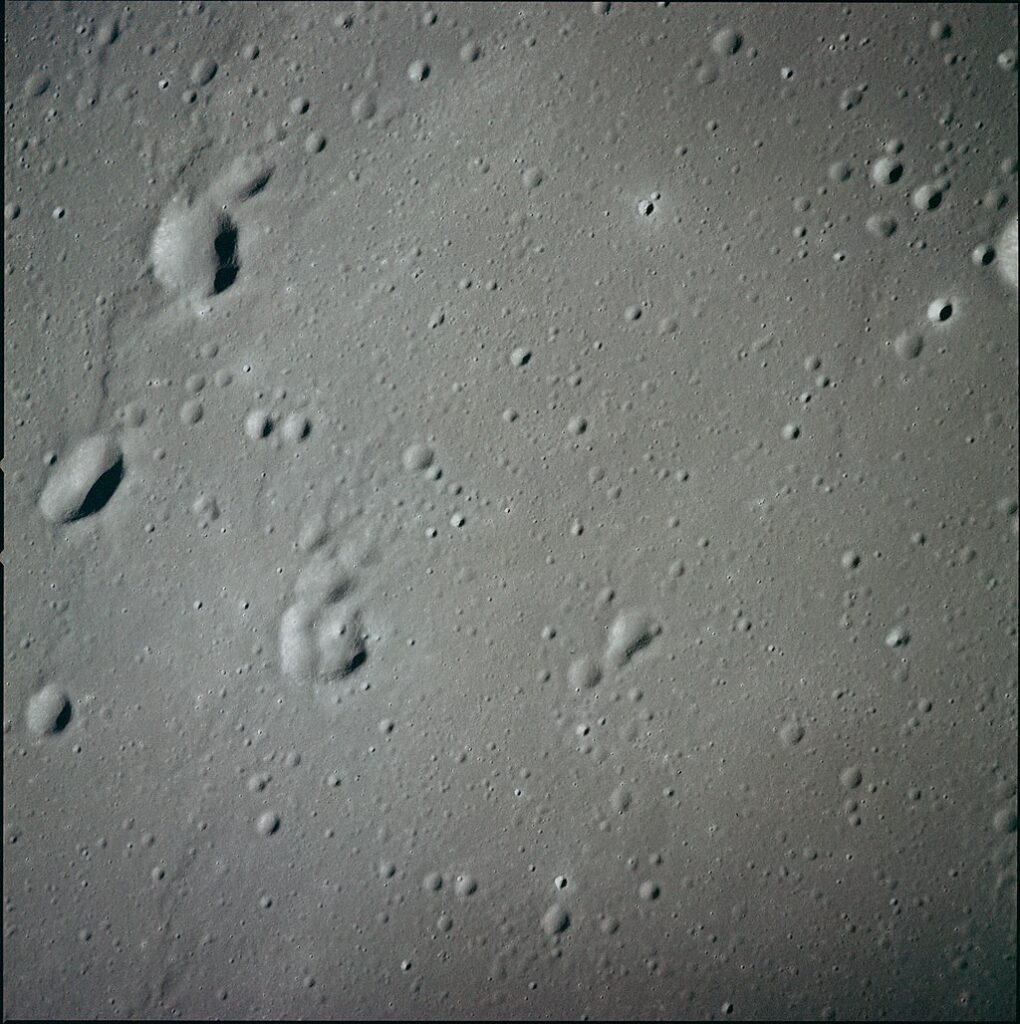
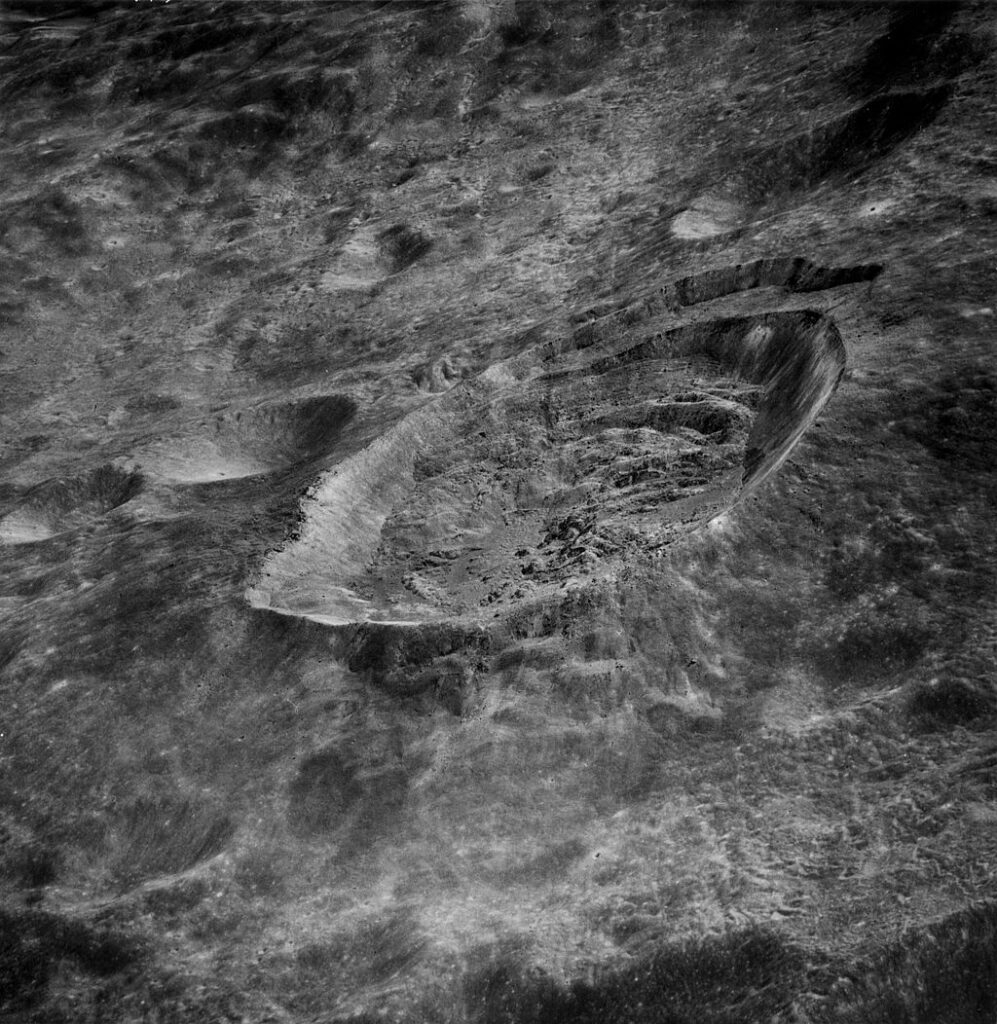 (top) A view of the prime Apollo-11 landing site. (bottom) Crater Necho on the far side of the Moon
(top) A view of the prime Apollo-11 landing site. (bottom) Crater Necho on the far side of the Moon
For their first telecast from lunar orbit, the Apollo-10 crew described the lunar terrain speeding below them, which included the approach to the Apollo-11 landing site in the Sea of Tranquillity. I could only see this broadcast in black and white, but I understand that for viewers in the US and other parts of the world, the colour and quality of the television images was quite breathtaking: these stills made available to me by the Australian NASA representative certainly suggest that! 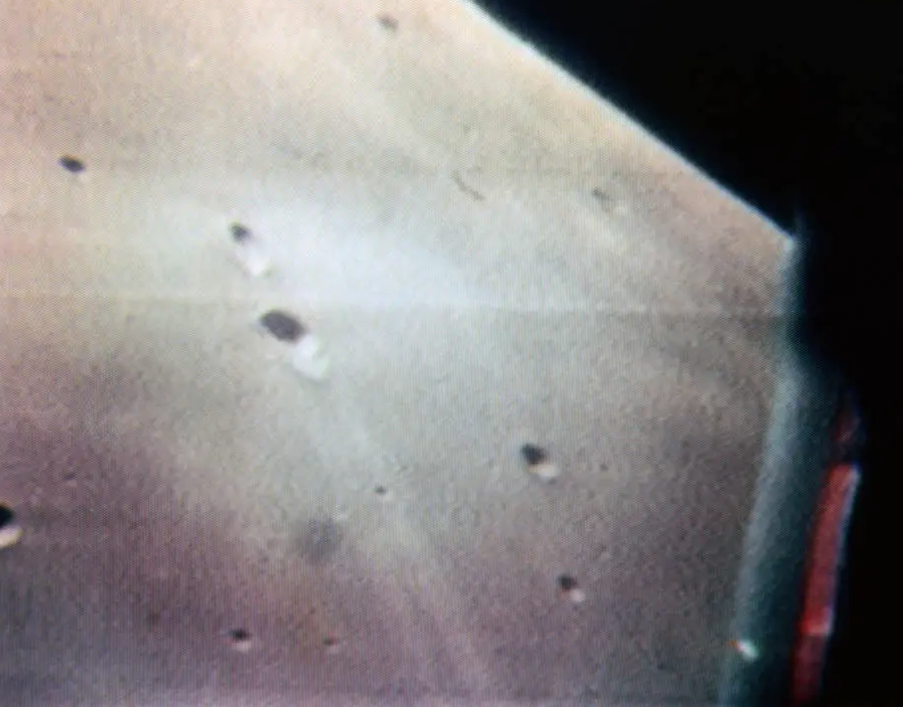
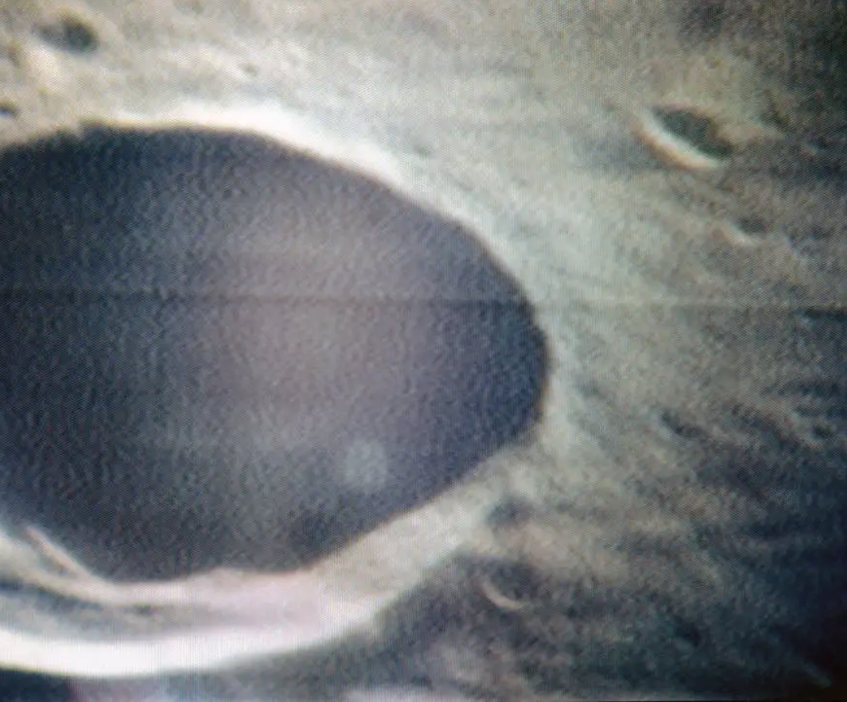 (top) Colour view of craters Messier and Messier-A (bottom) Crater Maskelyne
(top) Colour view of craters Messier and Messier-A (bottom) Crater Maskelyne
Waking Up Snoopy
When Commander Cernan opened Snoopy’s hatch for the first time, to be engulfed in fibreglass particles from the earlier damage to the CM hatch, bits got into his hair and eyebrows. Col. Stafford helped remove some of these particles, remarking that the LM Pilot “looked like he just came out of a chicken coop”. Though the astronauts used a vacuum cleaner to remove as much of the fibreglass particles as possible, tiny flecks annoyingly continued to circulate in the spacecraft, making the astronauts itch. They got into the air conditioning system and had to be constantly scraped from the CM’s filter screens for the rest of the mission.
Despite the fibreglass nuisance, Cernan partially activated the LM, conducted communications checks, and prepared the vehicle for its test flight. “I’m personally very happy with the fellow”, the LM Pilot later reported to Mission Control, saying in reference to the next day’s flight “We’ll take him out for a walk and let him stretch his legs in the morning.”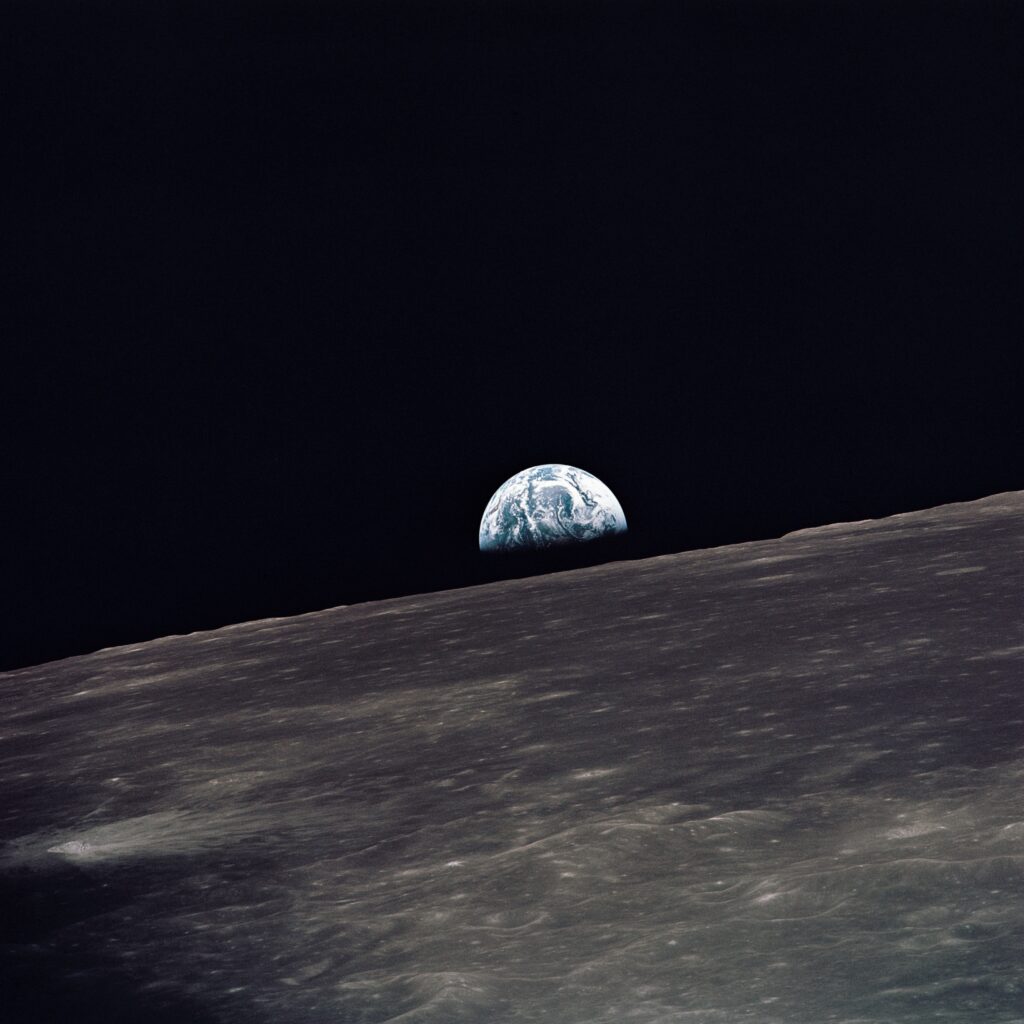 A spectacular Earthrise image captured during Apollo-10's first orbit of the Moon
A spectacular Earthrise image captured during Apollo-10's first orbit of the Moon
Taking Snoopy for a Walk
Apollo-10’s first full day in lunar orbit was going to be its busiest, with the critical eight-hour sequence of manoeuvres in lunar orbit to simulate all aspects of Apollo-11 mission operations except the landing itself. Stafford and Cernan transferred to Snoopy, while Young remained in Charlie Brown. Despite some issues with the docking tunnel, Mission Control assured the astronauts that it was safe to undock, and the two craft separated while they were out of contact behind the Moon. 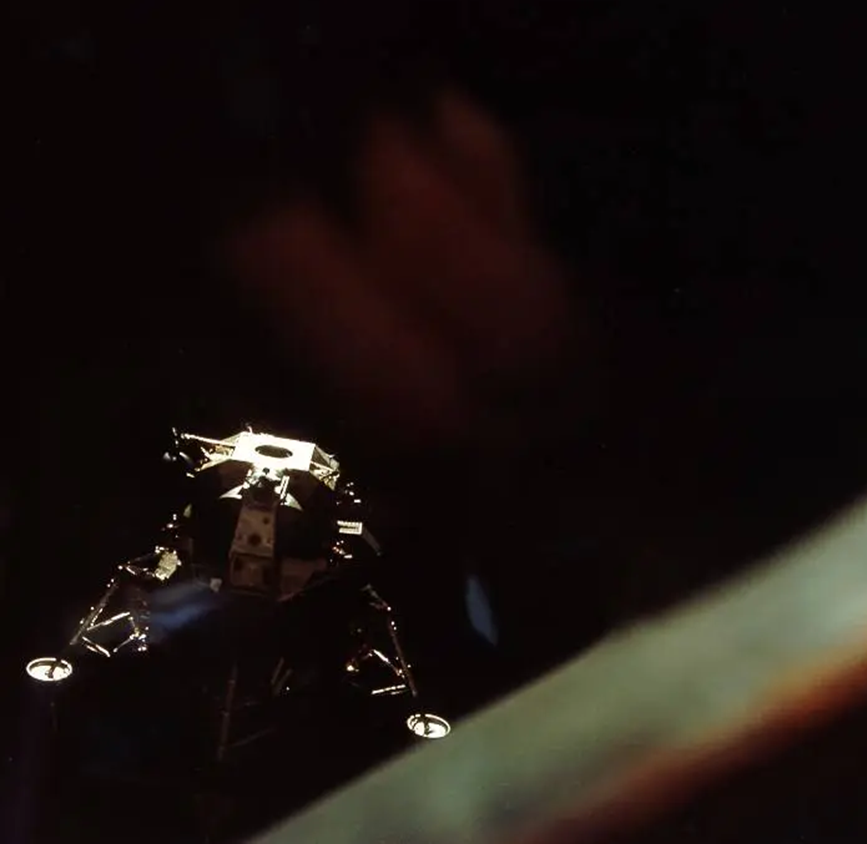
 Returning to contact with Earth, Commander Young made a visual inspection of the LM and then fired the CM’s thrusters to separate from Snoopy. With a GO from Mission Control, Snoopy commenced its Descent Orbit Insertion burn while on the lunar farside, to lower itself to about 50,000 feet. This critical manoeuvre took place behind the Moon, so that the low point of its orbit would be reached on the nearside near the Apollo-11 landing area in the Sea of Tranquillity. As they looped back around to the nearside of the Moon, Cernan reported to Capcom Charles Duke, “We is down among them, Charlie,” referring to their low altitude over the lunar landscape.
Returning to contact with Earth, Commander Young made a visual inspection of the LM and then fired the CM’s thrusters to separate from Snoopy. With a GO from Mission Control, Snoopy commenced its Descent Orbit Insertion burn while on the lunar farside, to lower itself to about 50,000 feet. This critical manoeuvre took place behind the Moon, so that the low point of its orbit would be reached on the nearside near the Apollo-11 landing area in the Sea of Tranquillity. As they looped back around to the nearside of the Moon, Cernan reported to Capcom Charles Duke, “We is down among them, Charlie,” referring to their low altitude over the lunar landscape.  A low-altitude view of the Apollo-11 prime landing site, focussed towards the upper right of the image
A low-altitude view of the Apollo-11 prime landing site, focussed towards the upper right of the image
Snoopy successfully tested the landing radar, a particularly critical test in advance of the actual landing mission, as the crew maintained a running commentary describing the landscape below them, including all the landmarks leading up to the planned Apollo 11 landing site. This was followed by a firing of the LM’s Descent Propulsion System to set up the right orbital geometry for a simulated liftoff from the Moon during the next orbit.
Crisis averted
As Snoopy’s crew prepared to separate the LM’s ascent stage from the lower stage, the vehicle began to gyrate and tumble out of control, causing Cernan to utter a shocked expletive that was broadcast live, bringing some complaints about his language (though I think his outburst was perfectly understandable in the circumstances).
Col. Stafford quickly discarded the descent stage and fought to manually regain control of the LM, suspecting a thruster stuck firing. Fortunately, after about eight seconds Snoopy was brought back under control and the Ascent Stage, was able to safely climb to orbit, mimicking the orbital insertion manoeuvre after launch from the lunar surface that Apollo-11 would have to conduct.
For a tense hour, it looked as if the Apollo-11 mission was in jeopardy. If the ascent stage always subjected its crew to "wild gyrations" upon firing, that was a problem that had to be solved, and pronto. Fortunately, the actual cause of the problem was determined quickly: it seems that a switch controlling the mode of the abort guidance system, a sort of back-up computer, has been left on, conflicting with the main guidance computer. That issue is easily resolved with a better checklist!
Blue Moon
There are rumours that NASA deliberately did not load Snoopy with enough propellant to safely land on the Moon and return to orbit, in order to dissuade Stafford and Cernan from unofficially attempting the first lunar landing. However, I’m told that, since Snoopy was overall too heavy to attempt a safe return from the lunar surface, the ascent stage was loaded with the equivalent quantity of propellant that it would have had remaining if it had lifted off from the lunar surface and reached the altitude at which the Apollo-10 ascent stage was fired. 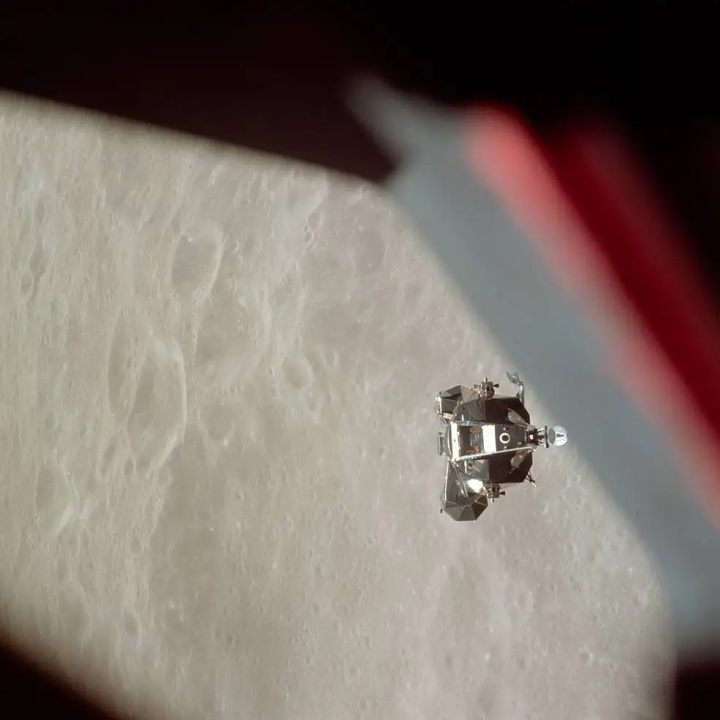 After coasting for about an hour, Snoopy performed manoeuvres to bring it close to Charlie Brown, while the two craft were behind the Moon. Just after they returned to contact with the Earth, Commander Young completed the CM-LM docking, with Stafford joking that “Snoopy and Charlie Brown are hugging each other.” During its independent flight of 8 hours 10 minutes, Snoopy met all planned objectives for the Lunar Module flight tests.
After coasting for about an hour, Snoopy performed manoeuvres to bring it close to Charlie Brown, while the two craft were behind the Moon. Just after they returned to contact with the Earth, Commander Young completed the CM-LM docking, with Stafford joking that “Snoopy and Charlie Brown are hugging each other.” During its independent flight of 8 hours 10 minutes, Snoopy met all planned objectives for the Lunar Module flight tests. 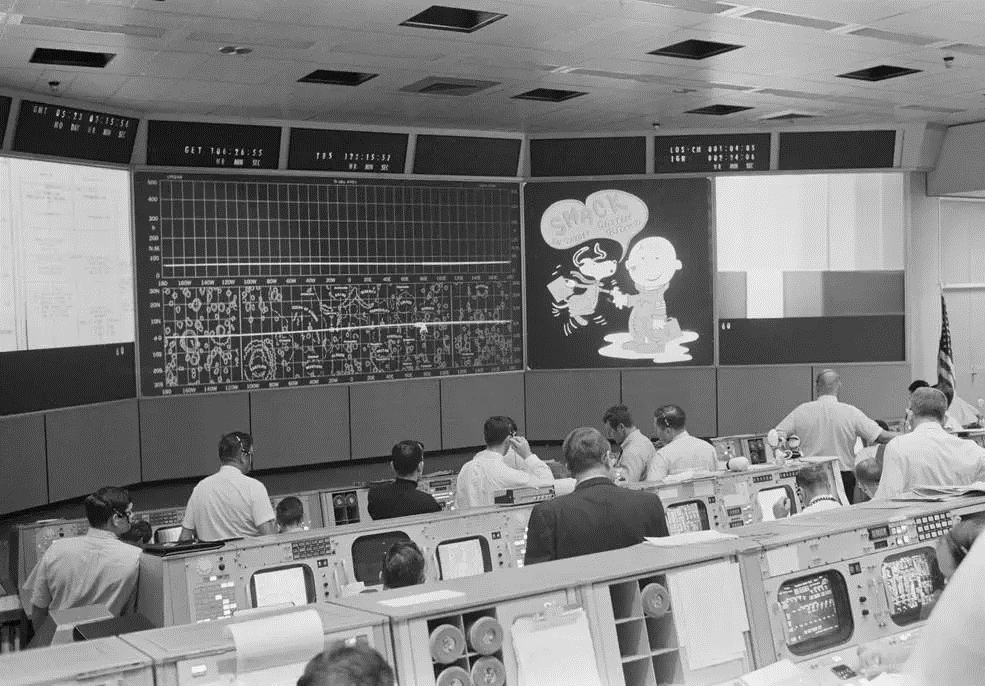 The scene in Mission Control as the LM and CM are safely docked together
The scene in Mission Control as the LM and CM are safely docked together
With all the astronauts safely back in the CM, Snoopy was cut free from Charlie Brown. To prevent any further contact between the two spacecraft, Snoopy’s ascent engine was automatically fired to fuel depletion, sending it safely out of lunar orbit and into an orbit around the Sun. LM Pilot Cernan said sadly, “I feel sort of bad about that, because he’s a pretty nice guy; he treated us pretty well today.”
On Their Way Home
During their final day in lunar orbit, the Apollo-10 crew took stereo images of the Apollo-11 landing site, gave another 24-minute colour TV broadcast, and prepared the spacecraft for its critical Trans Earth Injection manoeuvre, that would send the CM out of lunar orbit and on its way back to Earth. Just as with Apollo-8, this critical engine firing occurred while the spacecraft was behind the Moon and out of radio communications with Earth.
With extra fuel left over from the lunar activities, Apollo-10 burnt it off to accelerate the spacecraft back to Earth, the return trajectory taking only 42 hours rather than the normal 56. By the time it reached re-entry, the CM was travelling at 24,791 mph relative to Earth on re-entry, making the crew of Apollo 10 the fastest humans in history!
During their relatively lazy return to Earth, the Apollo-10 astronauts indulged themselves with the first shave in space. Using safety razors, a thick shaving gel and a wet cloth to wipe away gel and whiskers, the crew displayed freshly shaven visages during their final broadcast from space. 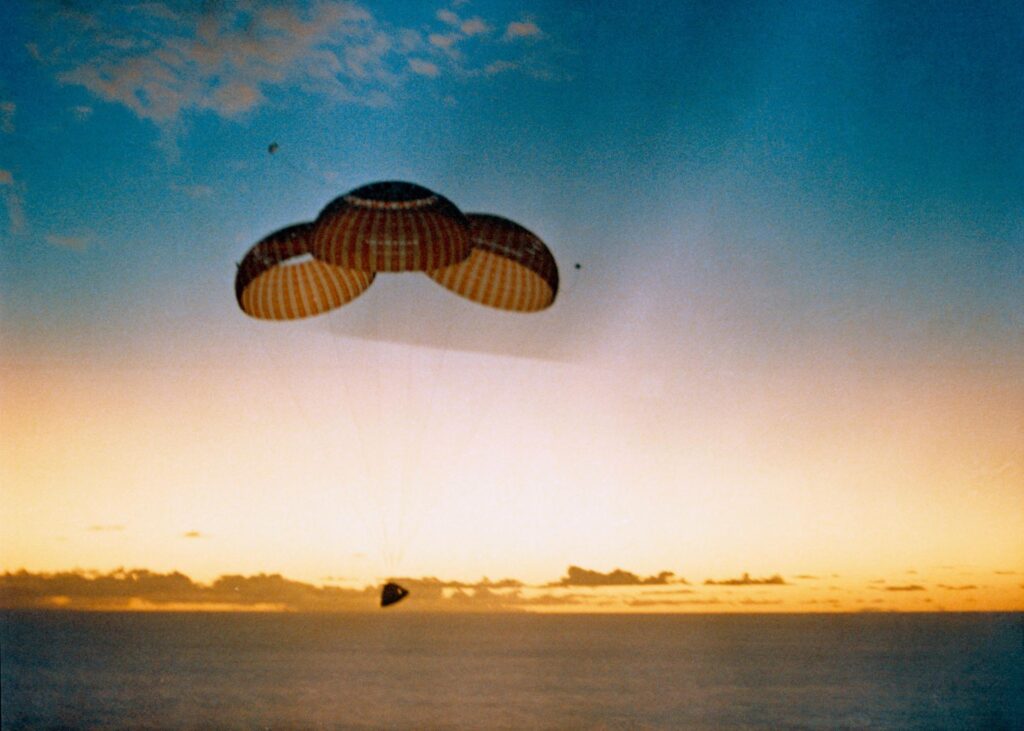 Eight days after launch (with a mission elapsed time of 192:03:23), Apollo-10 splashed down safely in the Pacific Ocean on 26 May, about 400 nautical miles east of American Samoa and just a couple of miles from the recovery ship USS Princeton. The carrier crew witnessed the spectacular sight of the Service Module streaking across the pre-dawn sky in a blazing fireball as it burned up, followed by the Command Module silhouetted against the brightening sky under its three big parachutes.
Eight days after launch (with a mission elapsed time of 192:03:23), Apollo-10 splashed down safely in the Pacific Ocean on 26 May, about 400 nautical miles east of American Samoa and just a couple of miles from the recovery ship USS Princeton. The carrier crew witnessed the spectacular sight of the Service Module streaking across the pre-dawn sky in a blazing fireball as it burned up, followed by the Command Module silhouetted against the brightening sky under its three big parachutes. 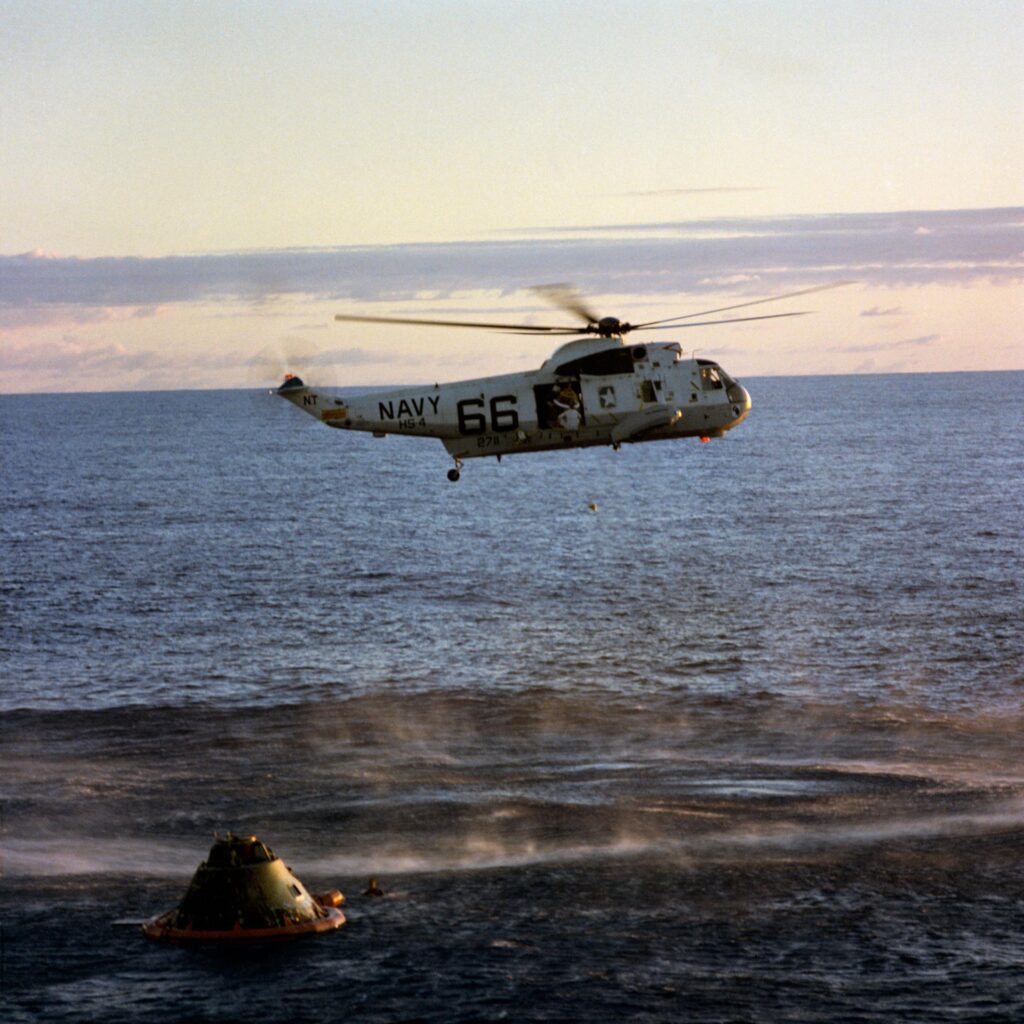 When the astronauts, waiting in their “rubber-ducky” to be retrieved, looked up at the recovery helicopter hovering above they saw “Hello there Charlie Brown” written across the underside of the fuselage!
When the astronauts, waiting in their “rubber-ducky” to be retrieved, looked up at the recovery helicopter hovering above they saw “Hello there Charlie Brown” written across the underside of the fuselage! 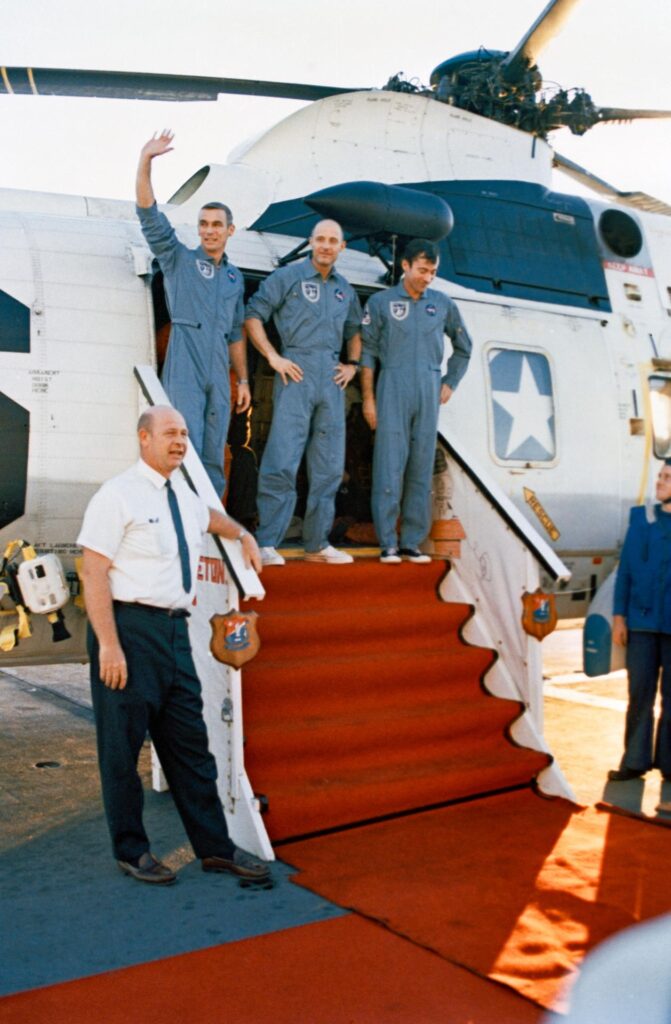 After taking a congratulatory phone call from President Richard Nixon, the crew were flown to Pago Pago and then on to Ellington Air Force Base near Houston, where they are now undergoing medical checks, debriefing and, of course, re-union with their families.
After taking a congratulatory phone call from President Richard Nixon, the crew were flown to Pago Pago and then on to Ellington Air Force Base near Houston, where they are now undergoing medical checks, debriefing and, of course, re-union with their families.
Apollo-10 has completed an epic voyage that has in many ways surpassed even Apollo-8. Its completion of a successful full-dress rehearsal, means that nothing now stands in the way of the first manned landing taking place in July 1969, with Apollo-11 – that will be the BIG one, to stand on the shoulders of this big test-flight mission. I can't wait! 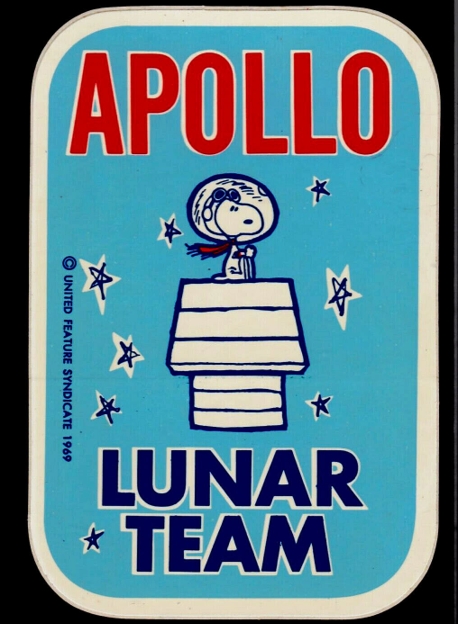

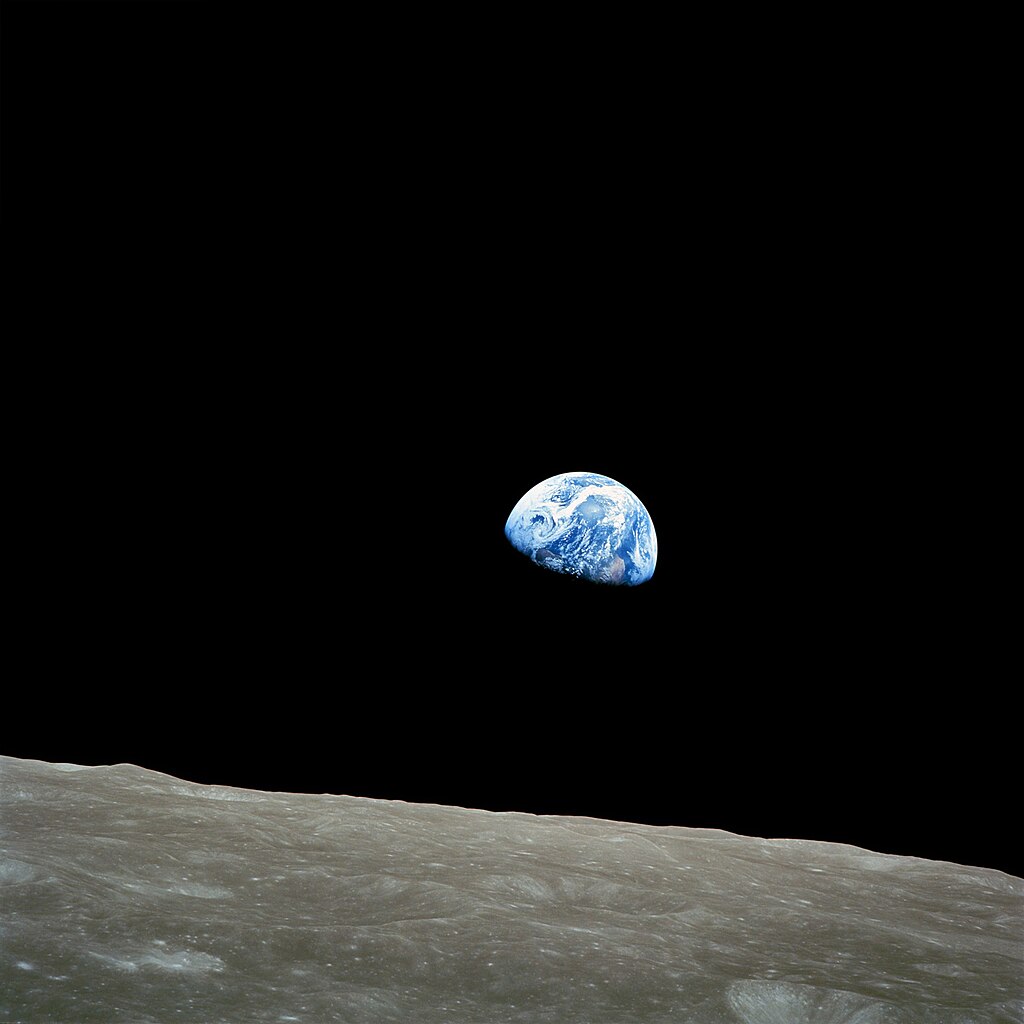 "Oh my God!" is what Astronaut William Anders said just before he took this awe-inspiring photograph of the Earth rising over the Moon, as seen from lunar orbit. That was my exact response – and yours, too, I expect – on first seeing this incredible sight. I confidently predict that this amazing view will become one of the defining images of the Space Age
"Oh my God!" is what Astronaut William Anders said just before he took this awe-inspiring photograph of the Earth rising over the Moon, as seen from lunar orbit. That was my exact response – and yours, too, I expect – on first seeing this incredible sight. I confidently predict that this amazing view will become one of the defining images of the Space Age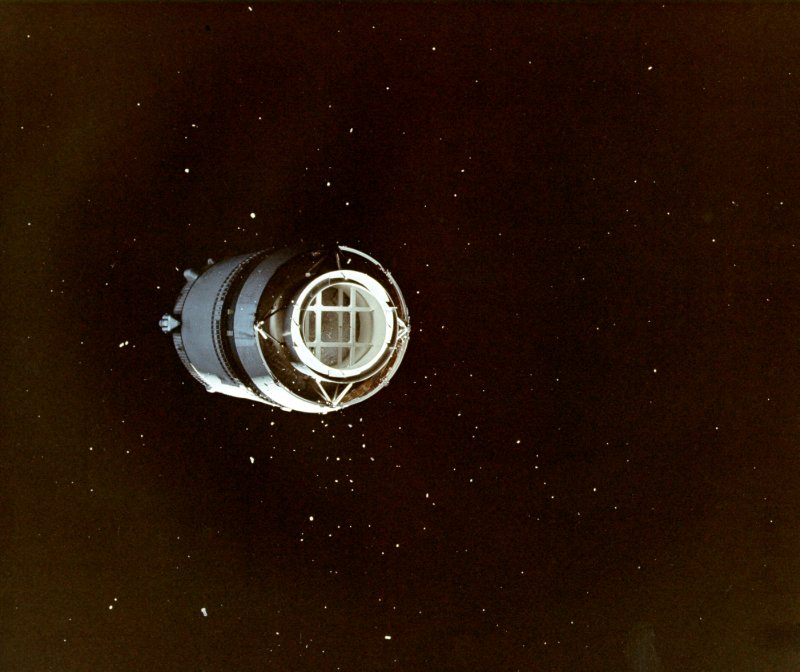 Fuel venting isn't visible in this image of the jettisoned S-IVB stage, but small debris from the separation can be seen floating around it. Although Apollo 8 carried no Lunar Module, this shot shows the LM test article contained in the S-IVB stage
Fuel venting isn't visible in this image of the jettisoned S-IVB stage, but small debris from the separation can be seen floating around it. Although Apollo 8 carried no Lunar Module, this shot shows the LM test article contained in the S-IVB stage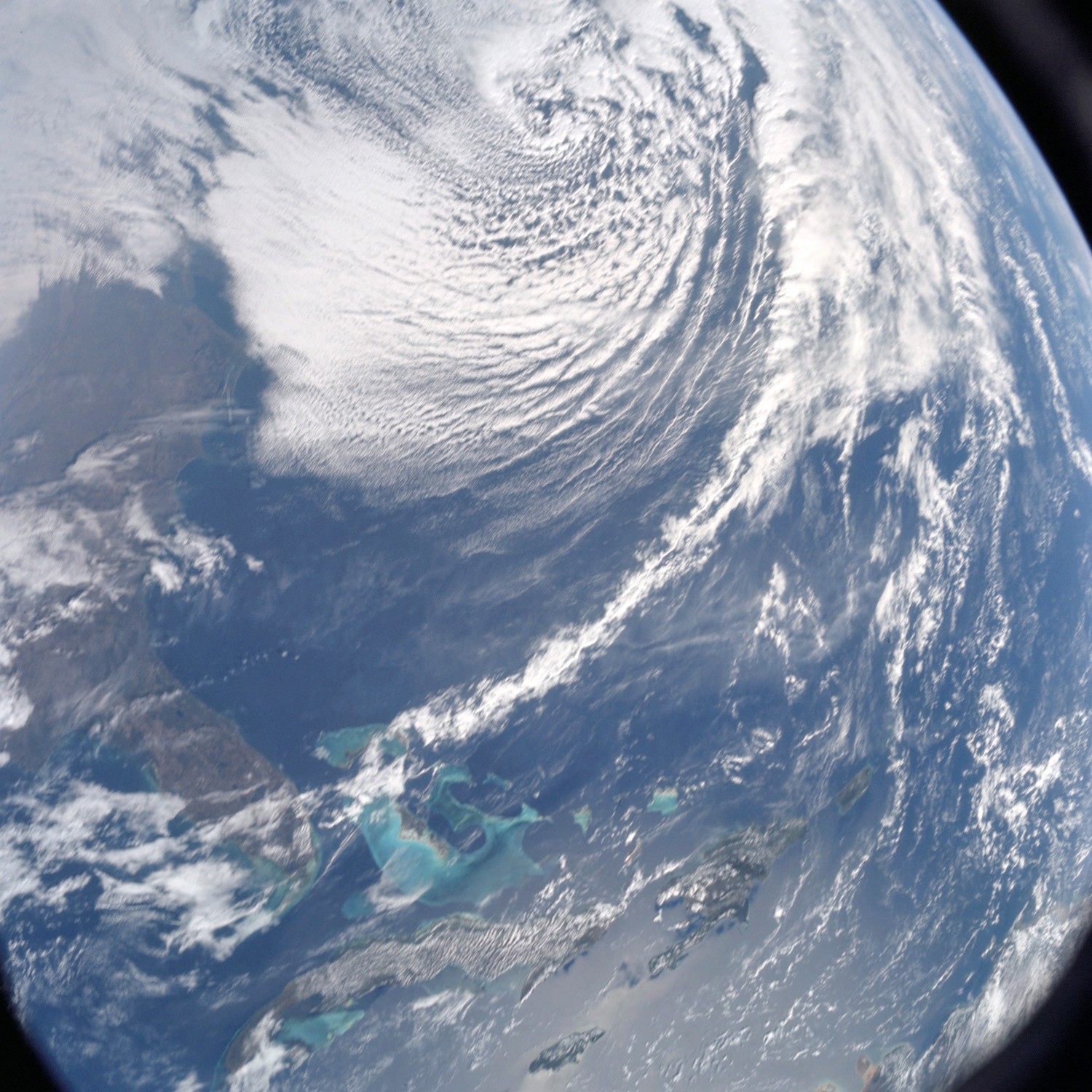 Taken just around the time of TLI, this view from high orbit shows the Florida peninsula, with Cape Kennedy just discernible, and several Caribbean islands
Taken just around the time of TLI, this view from high orbit shows the Florida peninsula, with Cape Kennedy just discernible, and several Caribbean islands The view of Earth after S-IVB stage separation. From the Americas to west Africa, and from daylight to night, for the first time humans could see their entire planet at a glance!
The view of Earth after S-IVB stage separation. From the Americas to west Africa, and from daylight to night, for the first time humans could see their entire planet at a glance!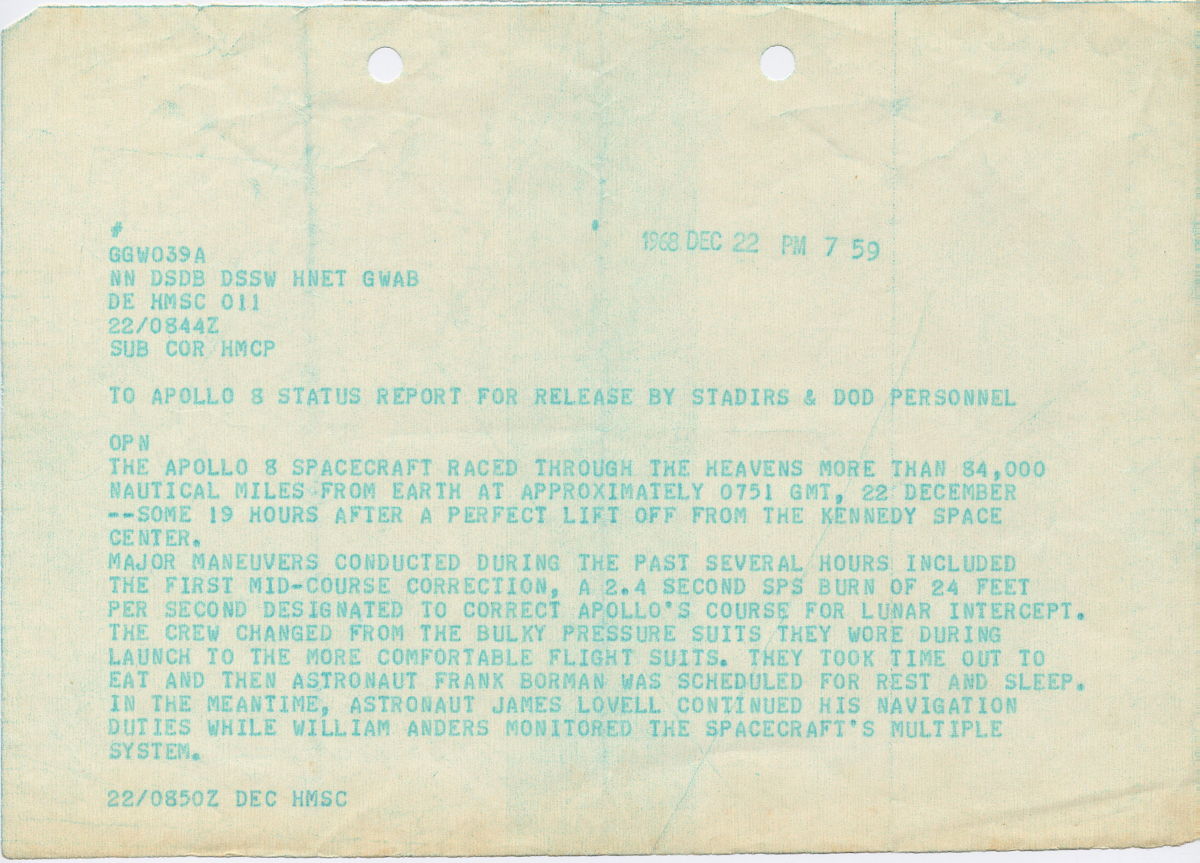 The first mission status report for Apollo 8, sent to the NASA tracking stations around the world, for release to local media. Dated some 19 hours after launch, it outlines some of the activities of the early part of the coast to the Moon
The first mission status report for Apollo 8, sent to the NASA tracking stations around the world, for release to local media. Dated some 19 hours after launch, it outlines some of the activities of the early part of the coast to the Moon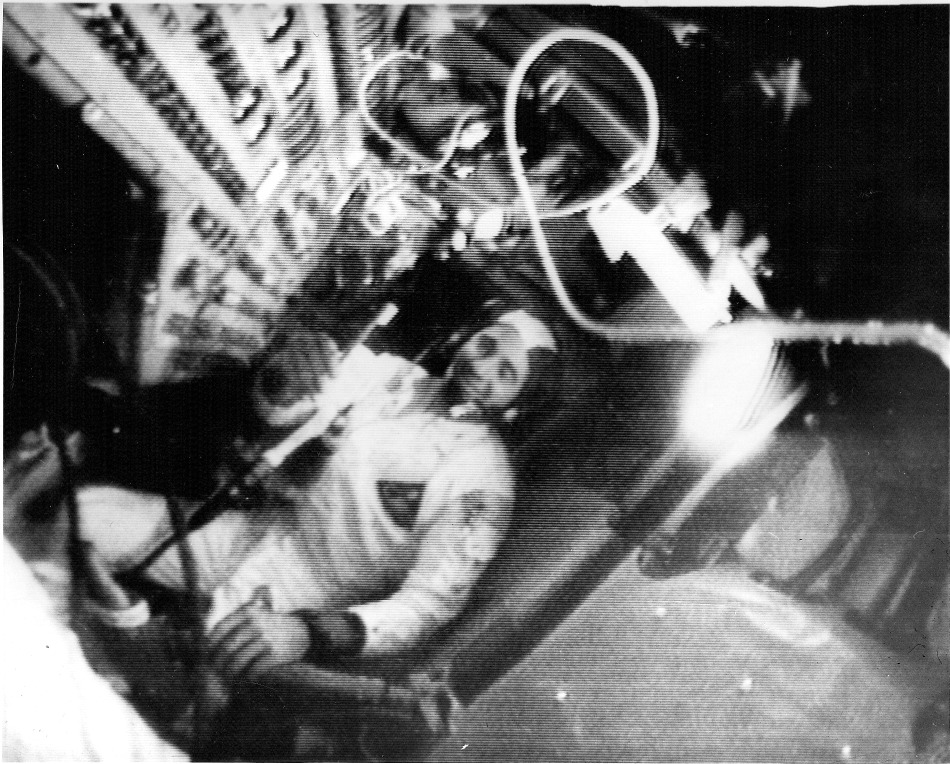
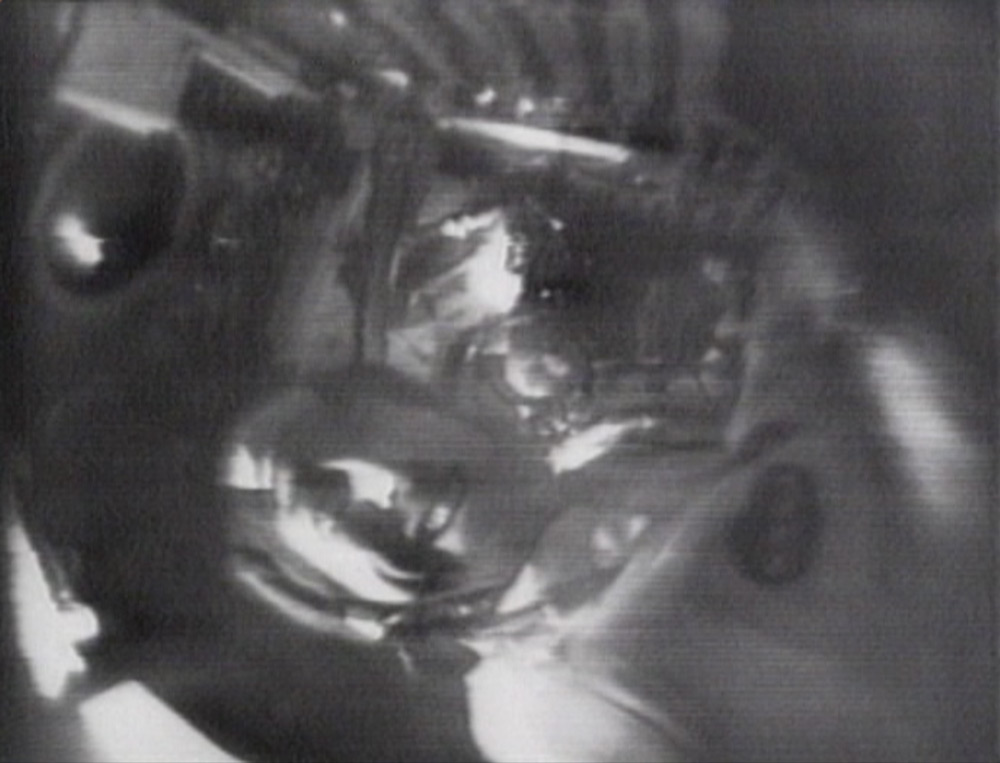 Astronaut Anders shows us his toothbrush (top) and Jim Lovell wishes his mother "Happy Birthday" (bottom) during Apollo 8's first deep space broadcast
Astronaut Anders shows us his toothbrush (top) and Jim Lovell wishes his mother "Happy Birthday" (bottom) during Apollo 8's first deep space broadcast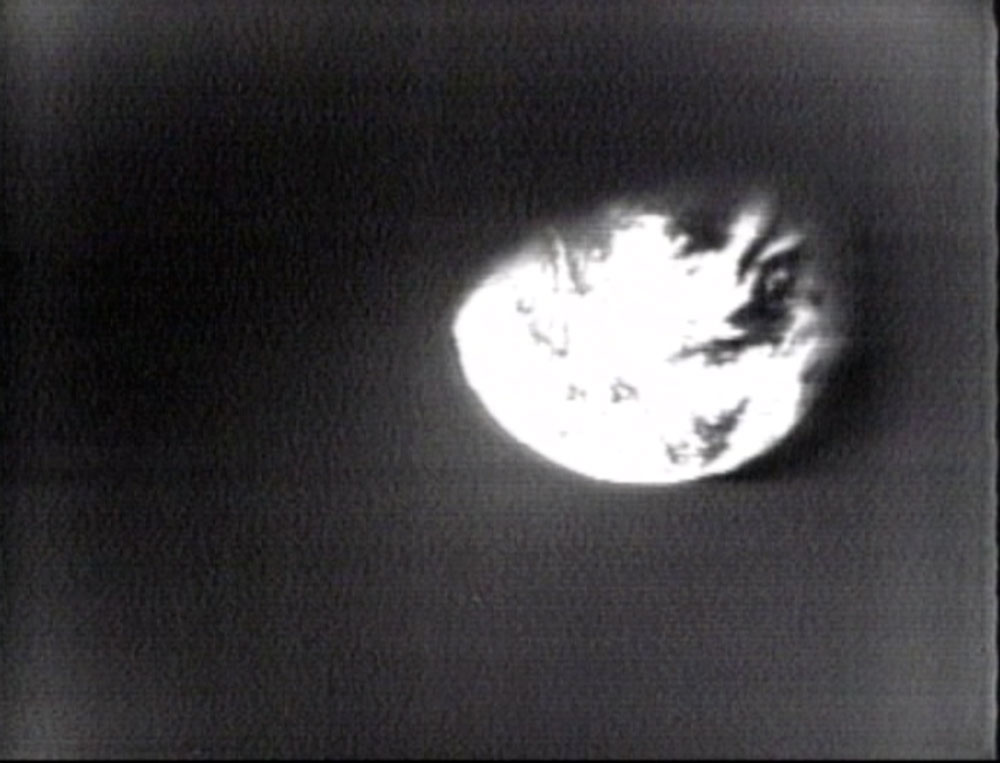 The Apollo 8 second broadcast view of the Earth as we saw it on television (above) and how Capcom Collins saw it on his monitors in Mission Control (bottom). Would alien visitors to our solar system think anyone lived there?
The Apollo 8 second broadcast view of the Earth as we saw it on television (above) and how Capcom Collins saw it on his monitors in Mission Control (bottom). Would alien visitors to our solar system think anyone lived there?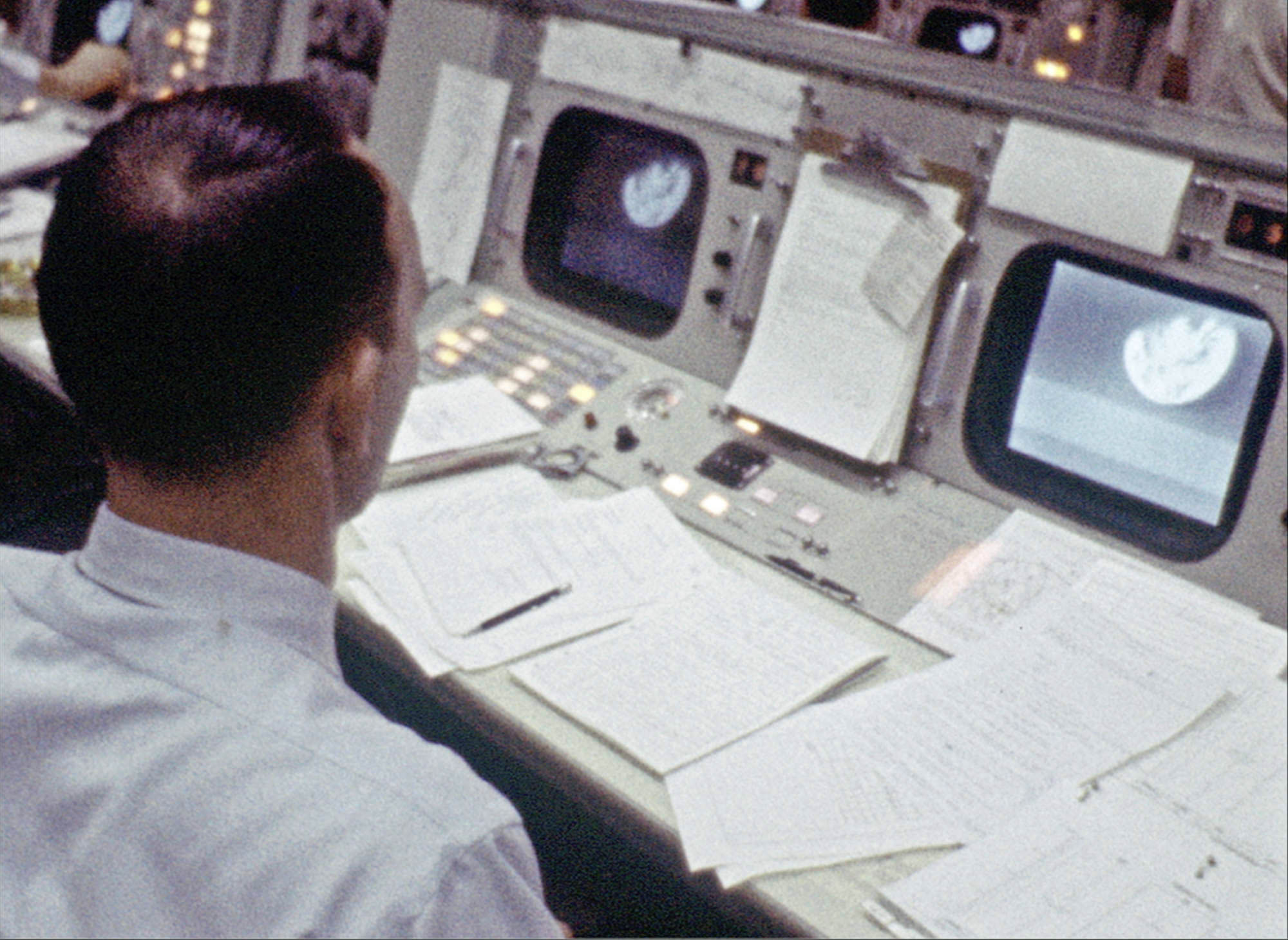
 A view of the Moon, finally visible as Apollo 8 approached and prepared to go into orbit
A view of the Moon, finally visible as Apollo 8 approached and prepared to go into orbit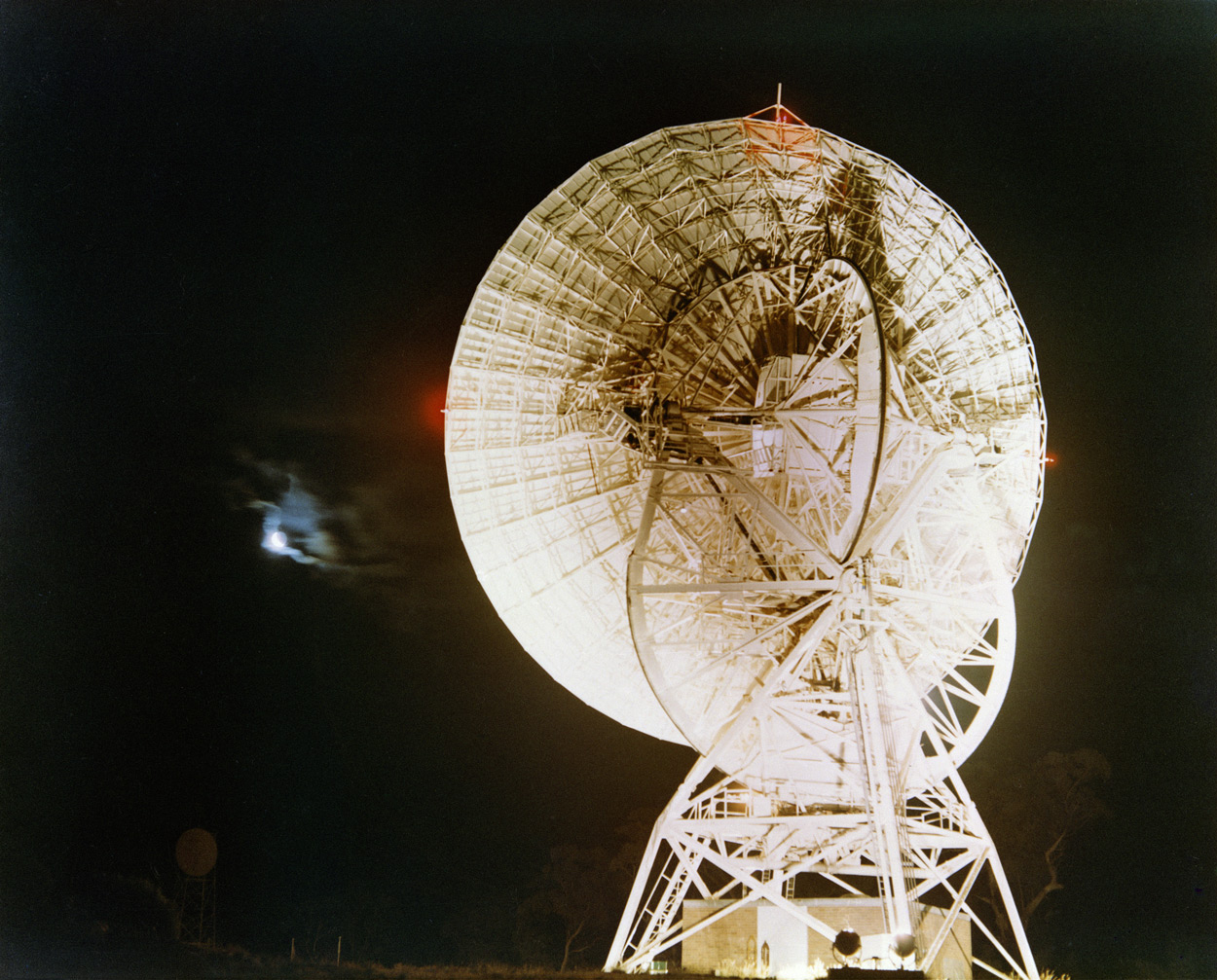 The Manned Space Flight Network station at Honeysuckle Creek, near Canberra, was tracking Apollo 8 as it went behind the Moon and received the first signals as it re-emerged, safely in lunar orbit
The Manned Space Flight Network station at Honeysuckle Creek, near Canberra, was tracking Apollo 8 as it went behind the Moon and received the first signals as it re-emerged, safely in lunar orbit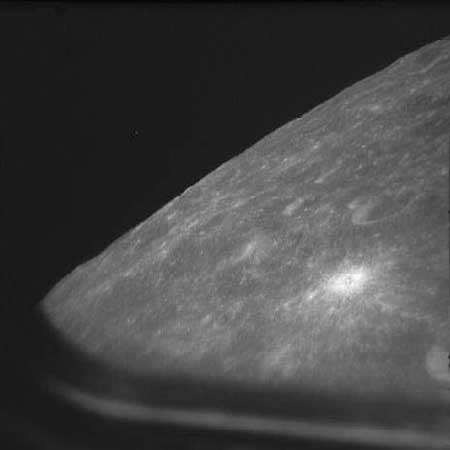
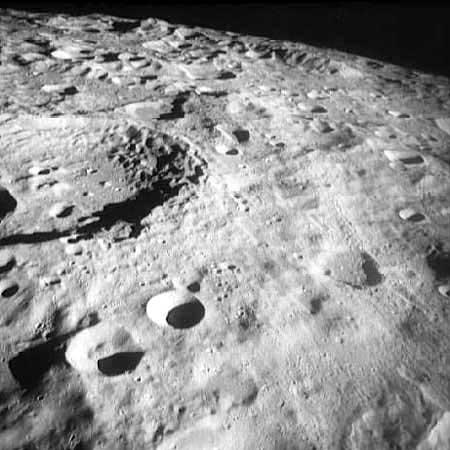 Jim Lovell's "sand pile" on the Moon!
Jim Lovell's "sand pile" on the Moon! View of the Moon's surface during the third Apollo 8 television broadcast
View of the Moon's surface during the third Apollo 8 television broadcast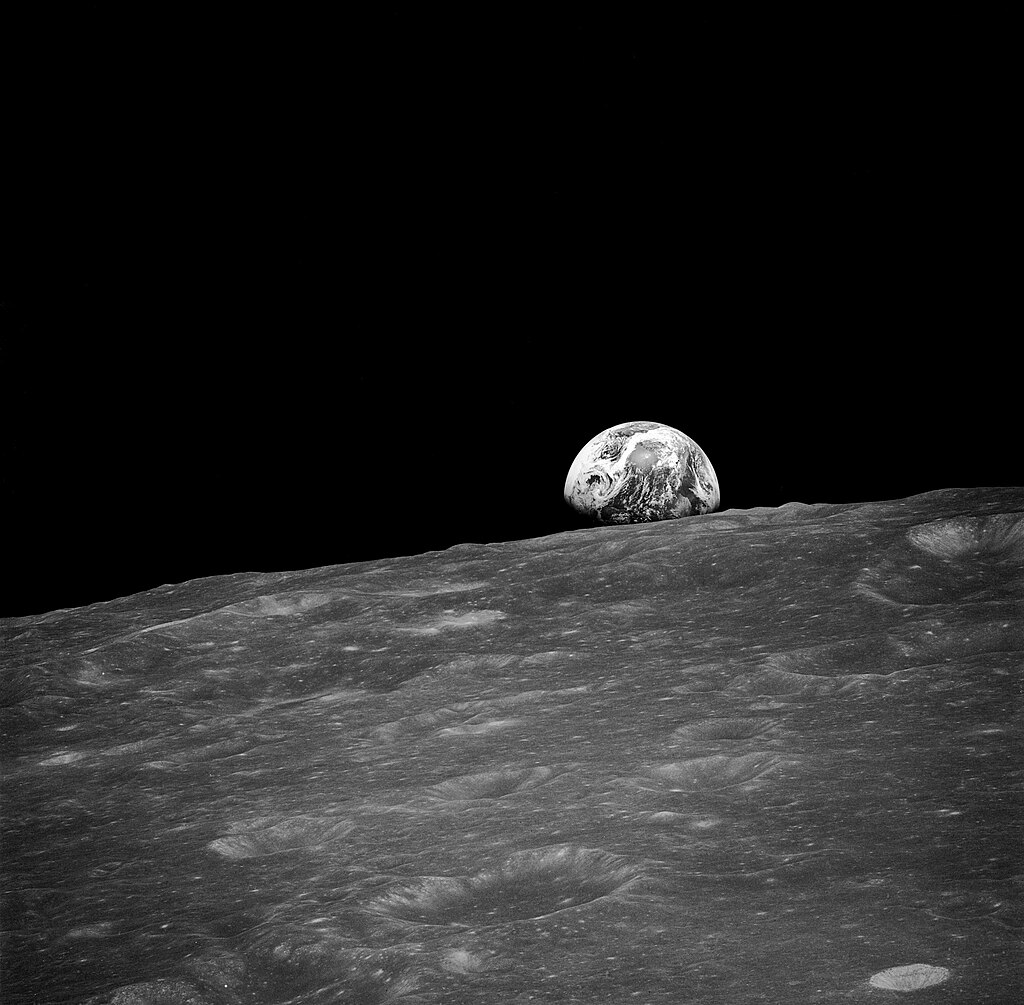 Awestruck, they scrambled so quicky to capture the vision that no-one is quite sure now who took which picture, although it seems that Col. Borman may have snapped the first black and white photograph, and Bill Anders a number of breathtaking colour images of the Earthrise.
Awestruck, they scrambled so quicky to capture the vision that no-one is quite sure now who took which picture, although it seems that Col. Borman may have snapped the first black and white photograph, and Bill Anders a number of breathtaking colour images of the Earthrise.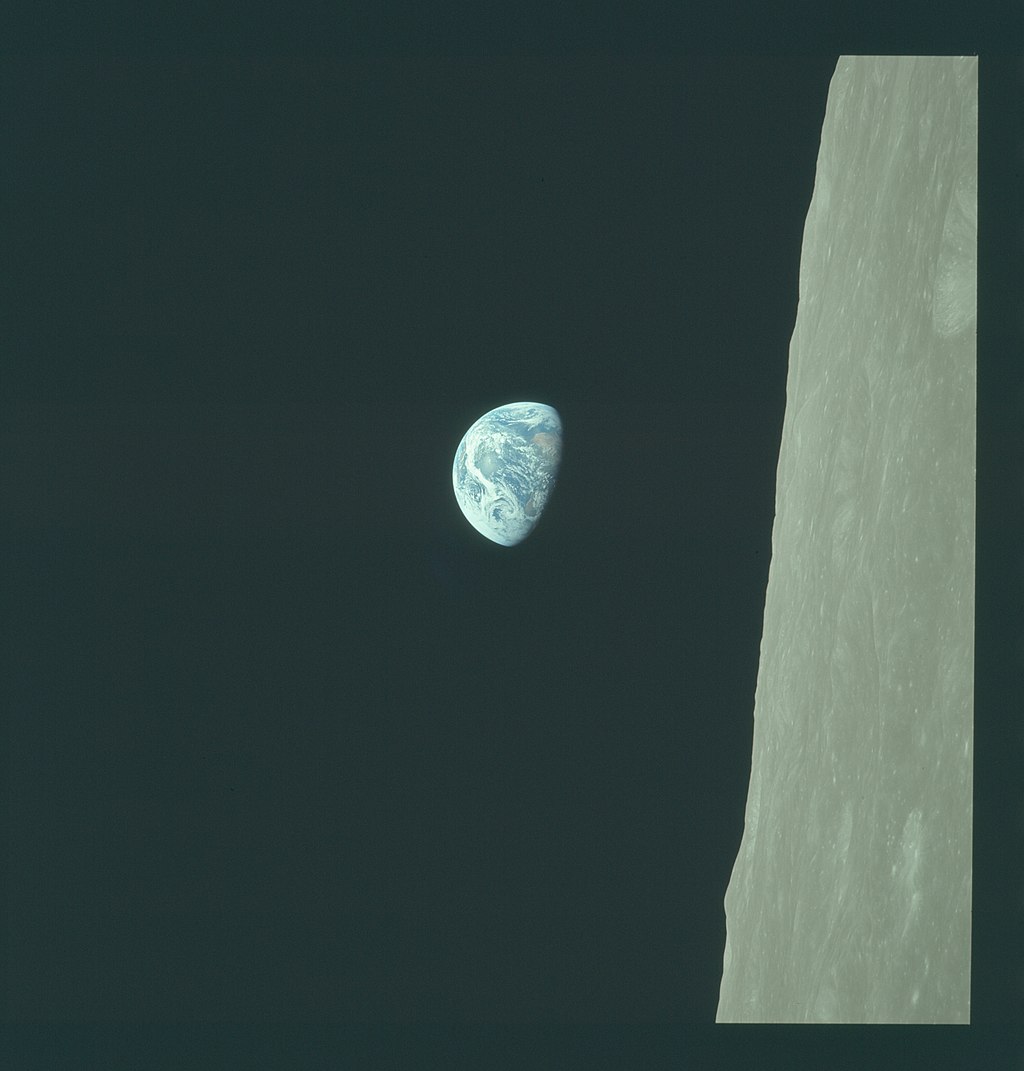 Apollo 8's Earthrise images are usually published oriented with the lunar horizon at the bottom, as that is how we are used to seeing the Moon rising over the horizon on Earth. But the orientation of astronauts' orbit meant that they actually saw the Earth appearing to rise 'sideways', as seen in this original version of Major Anders' photograph
Apollo 8's Earthrise images are usually published oriented with the lunar horizon at the bottom, as that is how we are used to seeing the Moon rising over the horizon on Earth. But the orientation of astronauts' orbit meant that they actually saw the Earth appearing to rise 'sideways', as seen in this original version of Major Anders' photograph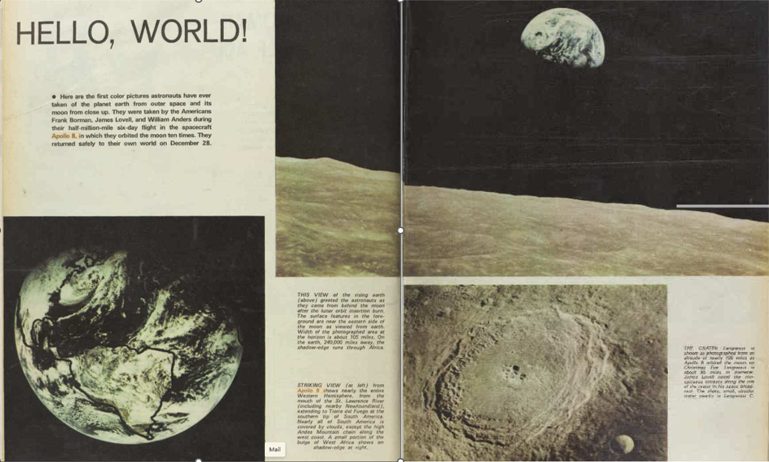 This spread from the 15 January issue of the Australian Women's Weekly is just one example of thousands of magazine and newspaper articles already featuring the Earthrise photograph and Apollo 8's other amazing pictures
This spread from the 15 January issue of the Australian Women's Weekly is just one example of thousands of magazine and newspaper articles already featuring the Earthrise photograph and Apollo 8's other amazing pictures A view of the Moon seen by the audience on Earth while the crew of Apollo 8 read from the Book of Genesis
A view of the Moon seen by the audience on Earth while the crew of Apollo 8 read from the Book of Genesis Families around the world gathered on Christmas Eve/Christmas Day (depending on where you were!) to watch Apollo 8's broadcast
Families around the world gathered on Christmas Eve/Christmas Day (depending on where you were!) to watch Apollo 8's broadcast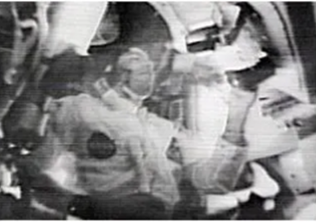 A view inside the Command Module, during the fifth Apollo 8 television broadcast
A view inside the Command Module, during the fifth Apollo 8 television broadcast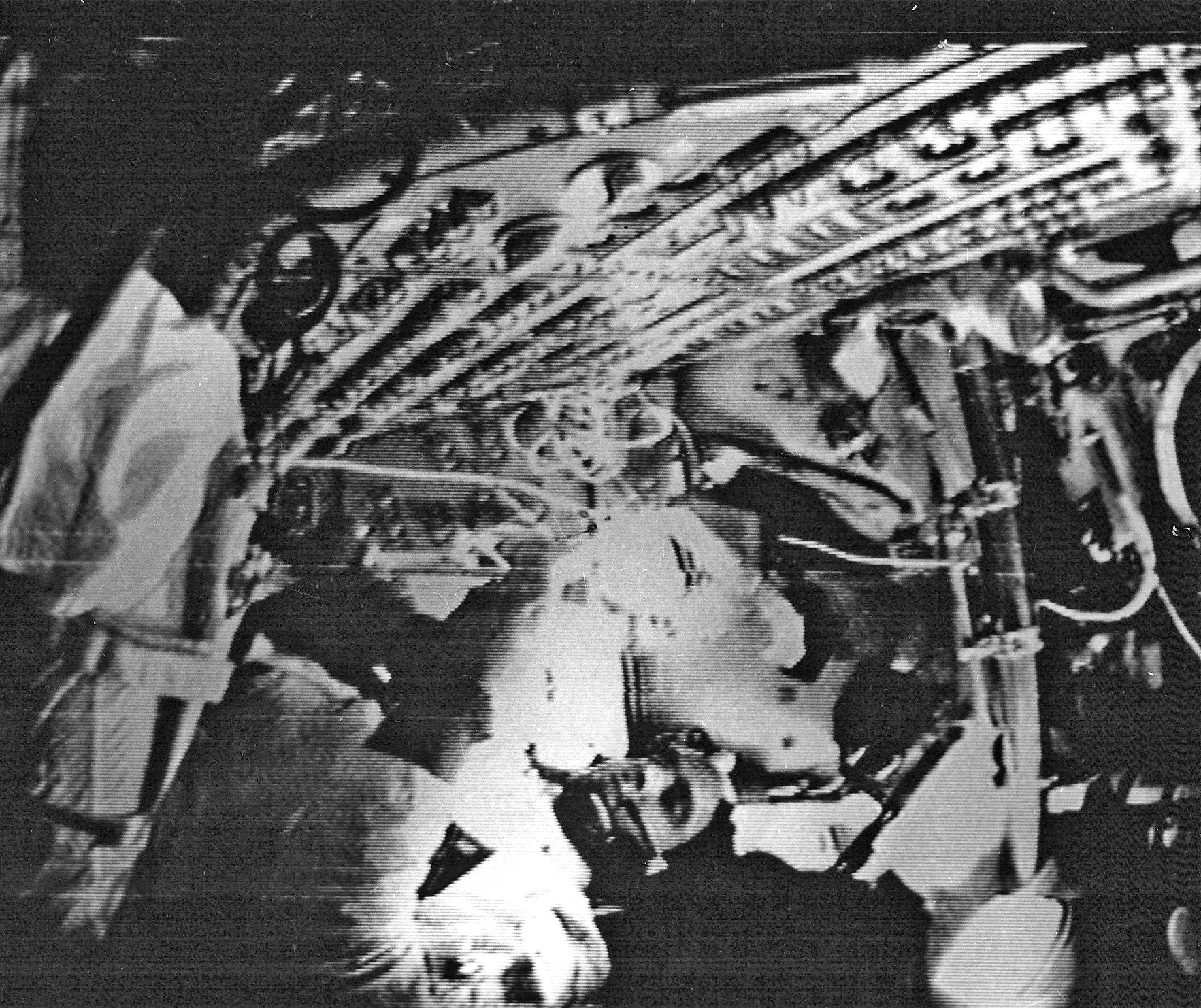 An image from the fifth broadcast taken directly from a monitor at the Honeysuckle Creek tracking station. It shows Bill Anders demostrating how to prepare a meal
An image from the fifth broadcast taken directly from a monitor at the Honeysuckle Creek tracking station. It shows Bill Anders demostrating how to prepare a meal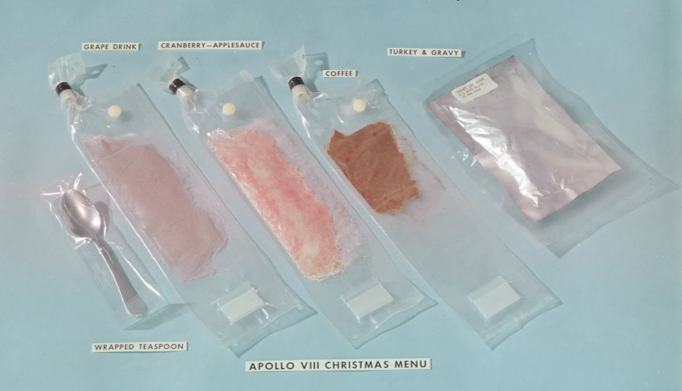 Slayton also included three miniature bottles of brandy with the meal, although Borman decided that they should be saved until after splashdown!
Slayton also included three miniature bottles of brandy with the meal, although Borman decided that they should be saved until after splashdown!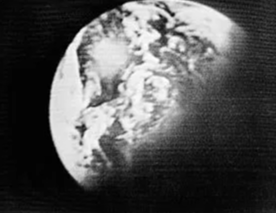

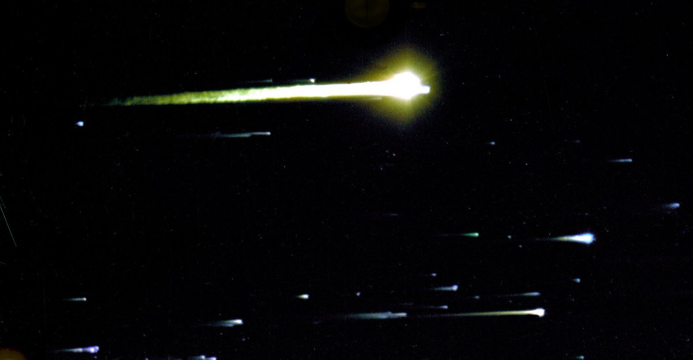 Apollo 8's re-entry, captured by one of NASA's Apollo Range Instrumented Aircraft that operate as airborne tracking stations
Apollo 8's re-entry, captured by one of NASA's Apollo Range Instrumented Aircraft that operate as airborne tracking stations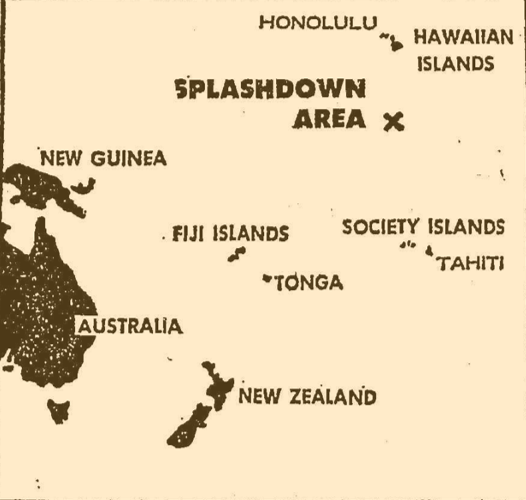 Map of Apollo 8's splashdown area
Map of Apollo 8's splashdown area 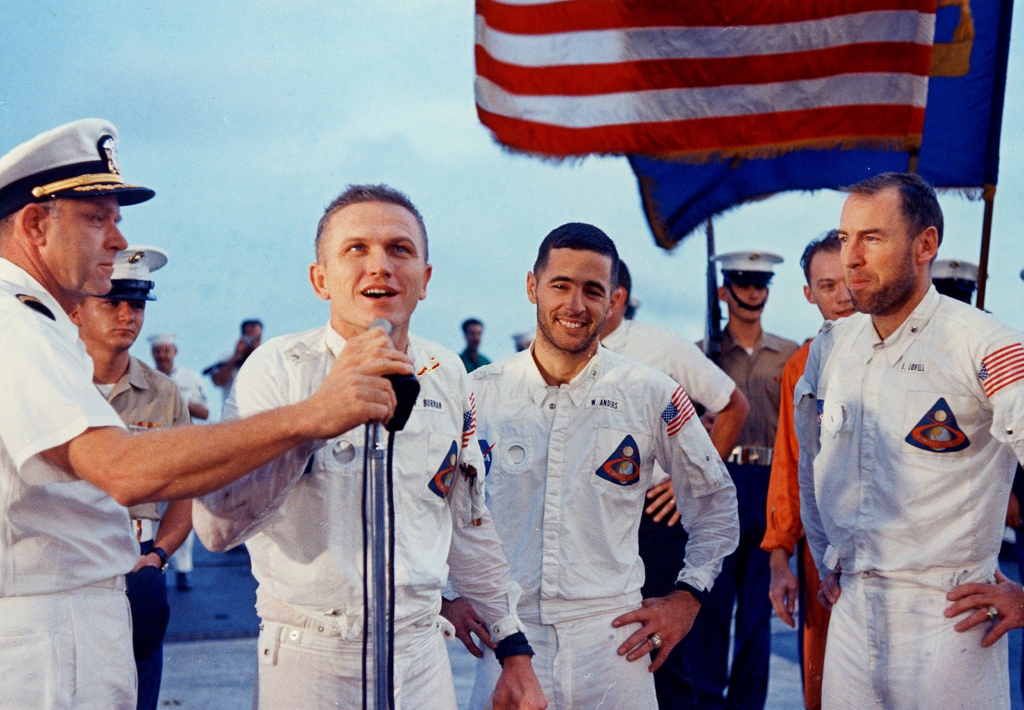 After their recovery, the Apollo 8 astronauts addressed the USS Yorktown's crew, very glad to be home!
After their recovery, the Apollo 8 astronauts addressed the USS Yorktown's crew, very glad to be home!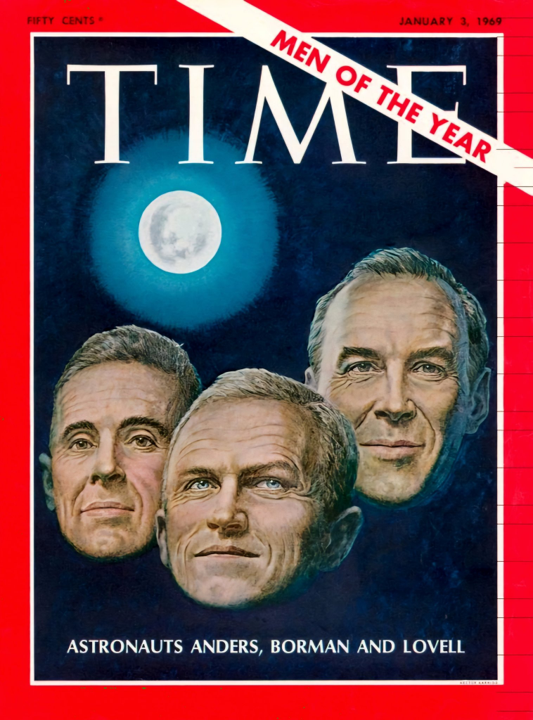 <
<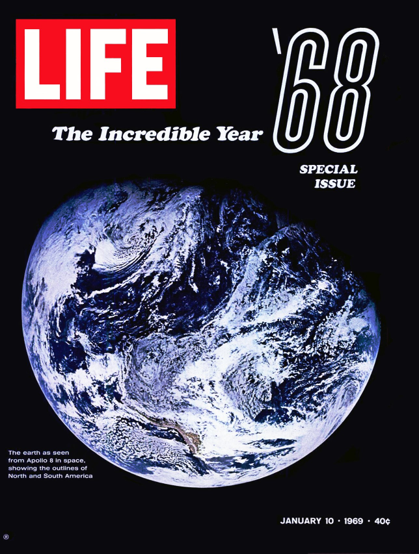 For the influence and impact of their mission, Time magazine has chosen the crew of Apollo 8 as its Men of the Year for 1968, while Life has selected the post-TLI image of the Earth for the cover its 1968 retrospective issue.
For the influence and impact of their mission, Time magazine has chosen the crew of Apollo 8 as its Men of the Year for 1968, while Life has selected the post-TLI image of the Earth for the cover its 1968 retrospective issue.